A Haunting in Venice (PG-13)

Starring: Kenneth Branagh
September 2023
Warning! This is NOT a movie review. This is a critique of the film. Intended to initiate a dialogue, the following analysis explores various aspects of the film and may contain spoilers. For concerns over objectionable content, please first refer to one of the many parental movie guide websites. Ratings are based on a four star system. Happy reading!
Master detective, Hercule Poirot (Kenneth Branagh), is settling into his post-retirement life when an old friend, Ariadne Oliver (Tina Fey), visits him at his exquisite residence in Venice, Italy. In an attempt at snapping the detective out of his funk, Ms. Oliver tells Poirot she’s arranged for him to attend a séance with the sensational spiritualist, the “Unholy” Mrs. Joyce Reynolds (Michelle Yeoh). Confident he can expeditiously expose Mrs. Reynolds as a charlatan, Poirot accepts Ms. Oliver’s invitation.
Arriving at a large mansion (which has all the hallmarks of a haunted house) on Halloween night, Poirot is introduced to Mrs. Reynolds. The detective is in the process of explaining his distrust of the supernatural when a giant chandelier crashes to the floor behind him. When Poirot begins hearing and seeing things that aren’t there, a fascinating question arises: are these paranormal occurrences part of an elaborate ruse, or is Poirot losing his mind?
Based on Agatha Christie’s 1969 novel Hallowe’en Party, A Haunting in Venice is Branagh’s third outing as renowned Belgian detective Poirot, the central character in many Christie mysteries. Unfortunately, the third time isn’t the charm for Branagh, who also serves as the film’s director. In addition to Branagh, Fey and Yeoh, the cast is rounded out by some fine actors including Jamie Dornan (Fifty Shades of Grey), Kelly Reilly (Yellowstone) and Camille Cottin (Killing Eve).
The opening sequence of establishing shots—which focus on such subjects as ancient statues, quaint European alleys, and pigeons pecking away at stray seeds lost among the cobblestones—are artfully framed and help to establish the film’s melancholic atmosphere. Also, several gorgeous Italian vistas (as seen from Poirot’s expansive rooftop) bookend the film. Sadly, there’s far too little of this excellent location work in the film.
The bulk of the story takes place in the ominous mansion (palazzo) with events transpiring over the course of one night. With such confined action, the story feels like a glorified stage play—Christie’s penchant for stuffing a large ensemble of characters into a claustrophobic setting was also on full display in Branagh’s earlier two movies in the series, Murder on the Orient Express (2017) and Death on the Nile (2022).
Haunting is a dark film, both artistically and spiritually. Symbolically, the middle (heart) of the movie is saturated with evil. It’s filled with scary tales, a séance, murders, and a creepy imaginary kid…the only thing missing is a black cat.
The lighting and cinematography combine to create a moody environment where dim-lit faces float in front of indistinct backgrounds and characters are dwarfed by expansive halls with vaulted ceilings. Branagh’s work behind the camera is meticulous, but he employs high angle and canted shots a bit too often.
Though appropriate to the story, the movie’s relentlessly bleak atmosphere may detract from the enjoyment of the film for some, and may be inappropriate for younger viewers. To wit, while watching a shadow puppet show about kids killing their parents, Poirot asks if the presentation is too frightening for children. An ironic question that also applies to the movie’s malicious and macabre subject matter.
Haunting is the worst of Branagh’s three Christie movies, which is disappointing since it squanders superb performances and excellent production values. Though the psychological thriller aspects are intriguing, the steady stream of cheap horror movie gimmicks (shattering saucers, slamming doors, bursting lightbulbs, squawking parrots and bees flying out of a skeleton’s mouth) fail to frighten…or entertain. Bottom line: Haunting is too drab and dire, without a hint of fun.
In one scene, Ms. Oliver quips that a brooding young boy has “all the charm of chewing tin foil.” Sadly, the movie has a similar appeal.
Rating: 2 ½ out of 4
Stillwater (R)
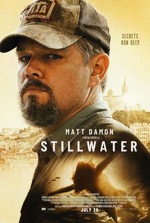
Starring: Matt Damon
September 2021
Warning! This is NOT a movie review. This is a critique of the film. Intended to initiate a dialogue, the following analysis explores various aspects of the film and may contain spoilers. For concerns over objectionable content, please first refer to one of the many parental movie guide websites. Ratings are based on a four star system. Happy reading!
The movie is named after the Oklahoma town which serves as the bookend location in Stillwater. As opposed to its eponym, the dramatic waters in this film are anything but still.
Matt Damon plays Bill Baker, a divorced oil-rig driller whose daughter, Allison (Abigail Breslin) has been accused of a murder and is languishing in a French prison. Between jobs, Bill manages to scrape enough cash together to visit Allison and bring her gifts, like an Oklahoma State Cowboys hoodie. Sadly, Allison sees her former alcoholic dad as a mess up and her relationship with him is estranged, despite his best efforts to patch things up.
On his most recent visit to Marseille, Bill is assisted by Virginie (Camille Cottin). Bill forms a close bond with Virginie’s young daughter Maya (Lilou Siauvaud), and eventually falls in love with Virginie…at which point his life begins to implode.
The movie is about choices and how people tend to go to extremes when protecting the ones they love. Bill makes a series of bad decisions that threaten his newly-formed French family and nearly land him in jail. The climactic bombshell revelation, that Allison might not be as innocent as she claims, sets up a bittersweet denouement and a downer ending.
Director Tom McCarthy does an excellent job of contrasting the U.S. and French locations. The cinematography serves a double purpose of capturing the character of these two worlds while revealing how these two worlds impact the characters.
It’s hard to imagine a more fish-out-of-water scenario then dropping someone like Bill into a bustling French city. His attempts at learning to speak French are amusing; especially his comment about how many syllables it takes to say “chisel.”
Damon deftly inhabits his character and is thoroughly convincing as the rough-living roughneck trying to do right by his daughter. As good as Damon is, the supporting cast is excellent, especially Cottin, who grounds the story’s more contrived elements in reality. Siauvaud is cute as a button.
In the end, this family drama with crime elements and Parisian flair won’t be everyone’s cup of joe. Though it has shades of Taken (2008), this well written clash of cultures tale will inhabit a unique corner in the “intercontinental, daughter in trouble, father takes matters into his own hands” genre.
Rating: 3 out of 4
Richard Jewell (R)
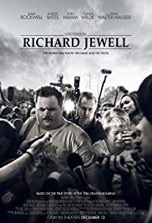
Starring: Paul Walter Hauser
December 2019
Warning! This is NOT a movie review. This is a critique of the film. Intended to initiate a dialogue, the following analysis explores various aspects of the film and may contain spoilers. Views are my own and elaborate on comments that were originally tweeted in real time from the back row of a movie theater @BackRoweReviews. For concerns over objectionable content, please first refer to one of the many parental movie guide websites. Ratings are based on a four star system. Happy reading!
Based on the horrific events that transpired at Centennial Olympic Park in Atlanta, GA during the 1996 Summer Olympic Games, Richard Jewell tells the true account of how the right security guard at the right time saved countless lives, but then went from hero to prime suspect in a matter of days. The movie is based on the book The Suspect by Kent Alexander & Kevin Salwen and the Vanity Fair article “American Nightmare: The Ballad of Richard Jewell” by Marie Brenner.
The movie begins with Richard Jewell (Paul Walter Hauser) delivering mail (and Snickers bars) to his new boss, Watson Bryant (Sam Rockwell). Jewell soon leaves that job to pursue a career in law enforcement. Years later, after being fired from his security position at Piedmont College, one of Jewell’s friends recommends that he try getting on one of the security crews at the Olympic Games.
We jump forward to when Jewell is working security for AT&T during the Olympics’ nightly concert series. One night, Jewell sneaks up behind his mother, Bobi (Kathy Bates), and joins her in singing the chorus to “The Gambler” as Kenny Rogers performs it live on stage. The following night isn’t as festive. Backpack. Explosion. And the rest is history.
Whereas the film’s central event is explosive, the story isn’t. Billy Ray’s (Captain Phillips) screenplay is extremely slow out of the starting gate. We follow Jewell as he bounces from job to job before finally getting hired on at the Olympics. Though we learn a good deal about Jewell’s personality and eccentricities during these preliminary scenes, it would’ve been nice if the early stages of the movie had been more intentional.
Much of the movie’s geriatric pacing can be attributed to the octogenarian director’s filming style. With a few exceptions, the majority of Clint Eastwood’s recent films have lacked urgency. He tends to capture the reality of a story in a very deliberate manner. Here, that purposefulness almost works in his favor, since the film is set in the Deep South, a region known for its slower pace. Negative critiques aside, after a series of average (The Mule) to awful (The 15:17 to Paris) films, this is Eastwood’s best effort in years.
Eastwood has tapped some fine talent for his biopic. Simply put, Hauser (I, Tonya) makes this movie work. You can’t help but feel pity for the quirky, vigilant and by the book security guard.
There’s a great scene where Bryant accuses Jewell of not being mad enough about what’s happening to him. The remark succeeds in triggering Jewell’s indignation. Jewell tells Bryant he can’t react the way the lawyer would and that he has to be true to himself. Even when provoked to anger, Jewell still had integrity.
Rockwell is flawless as Jewell’s “loud lawyer.” Bryant repays Jewell’s loyalty by sticking with him through the media circus that ensues after Jewell becomes the assumed perpetrator of the bombing. Bryant’s hard-nosed approach is a huge asset in preventing the FBI agents from intimidating Jewell and coercing him into surrendering his rites.
Though she only has a handful of scenes, Bates is exceptional as Jewell’s mother. Her impassioned speech at the end of the film is deeply moving and shows her range as an actor. Jon Hamm perfectly plays Tom Shaw, the FBI agent who continues building his case against Jewell even after it becomes obvious the security guard is innocent. Rounding out the cast is Olivia Wilde, who plays Kathy Scruggs, an unscrupulous journalist more interested in grabbing a headline (and Shaw’s crotch) than telling the truth, regardless of how such falsehoods might destroy the reputation of an innocent person.
And therein lies the crux of the story. Jewell was falsely accused of a crime he didn’t commit. Though the judicial bedrock of our nation has been eroding for decades now, it’s clear that the time-honored standard “innocent until proven guilty” was tenuous even at this point in our history.
Indeed, more than ever, people are rushing to judgment and vilifying perceived offenders before they’ve been sentenced, tried or convicted. This type of trial by media is incredibly dangerous to individual rights. Though the media scrutiny was unbearable in 1996, can you image the living hell Jewell would’ve endured if the bombing had occurred during the age of social media?
Despite the fact that his reputation was besmirched by an overeager reporter and an overzealous federal agent, Jewell is one of history’s greatest unsung heroes since the bombing would’ve claimed many more lives were it not for his training, awareness and aggressive evacuation of the concert venue. Even though Jewell fits a certain profile (gun owner, lives with his mother, knows how to make a pipe bomb, wants to be seen as a hero, etc.), estimations of his character, by various news outlets and key law enforcement officials, couldn’t have been further off base. Using Jewell as a case study, one wonders how many others in our society are just like him…misunderstood heroes in the making?
Ironically, the real Olympic bomber, Eric Rudolph, confessed to the crime in 2005. Two years later, Jewell died of heart failure at age 44.
In the end, Jewell is a bittersweet tale that illustrates just how quickly someone can go from being lionized to villainized. The movie is a sobering reminder of the media’s prevalence and the government’s ostensible omnipotence.
Jewell is a cautionary tale of how easily lives can be destroyed when powerful institutions succumb to knee-jerk reactions and turn public opinion against innocent citizens. It’s a lesson that’s just as salient today as it was in 1996.
Rating: 3 out of 4
Motherless Brooklyn (R)
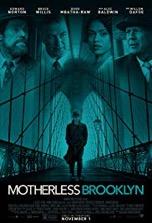
Starring: Edward Norton
November 2019
Warning! This is NOT a movie review. This is a critique of the film. Intended to initiate a dialogue, the following analysis explores various aspects of the film and may contain spoilers. Views are my own and elaborate on comments that were originally tweeted in real time from the back row of a movie theater @BackRoweReviews. For concerns over objectionable content, please first refer to one of the many parental movie guide websites. Ratings are based on a four star system. Happy reading!
Based on the novel of the same name by Jonathan Lethem, Motherless Brooklyn is a neo-noir set in NYC during the 1950s. It’s a tale of murder, greed, scandal and political corruption. Some things never change.
The film opens with Lionel Essrog (Edward Norton), a private detective afflicted (or blessed) with Tourette’s Syndrome, assisting his boss, Frank Minna (Bruce Willis), with an important case. Things go sideways when Frank is taken for a ride, shot in the stomach and dumped in an alley. Frank’s final words not only hint at the identity of his murderer, they also blow the lid off a high-level political scandal.
As he begins unraveling the tangled web of graft, Lionel meets Laura Rose (Gugu Mbatha-Raw), an attorney who’s advocating for the scores of minority families that are being forced out of their homes to make way for new housing developments. Lionel also encounters Paul Randolph (Willem Dafoe), a disgruntled engineer who implicates his brother, Moses (Alec Baldwin), as the chief architect of the unlawful land grab. These clues edge Lionel ever closer to the truth behind Frank’s death…and, as we learn in the opening sequence, once Lionel starts pulling on a loose string, he just can’t stop.
Due to the movie’s excesses, it’s difficult to remain impartial while evaluating it. On the one hand, Motherless is a gorgeous film (Norton’s deft direction beautifully captures the look and feel of the 50s milieu) with superb acting from its scintillating cast and period appropriate production elements—sets, props, clothing and coifs are all crafted with excellence. On the other hand, the movie is loaded with foul language (including over 60 F-bombs) and crude speech from one set of credits to the other.
It’s unfortunate that the movie’s unsavory dialog sullies the worthwhile facets of its story. Its R rating also prevents a broader audience from experiencing the movie’s remarkable central performance. Norton’s neck snaps and sudden outbursts never feel forced or rehearsed and are thoroughly convincing…an Oscar-worthy turn.
Lionel’s condition serves as a wild card element and produces sympathy in other characters (and the audience) when he apologizes for his behaviors (“I’ve got a condition…makes me say funny things”). Lionel’s ticks and quirks are the most interesting part of the movie. The same story with an average Joe detective would’ve made for a much duller film.
In adapting the screenplay, Norton borrowed story devices from two of the finest movies ever made: Chinatown (1974) and Citizen Kane (1941). Even though they take place on opposite coasts and are separated by a couple decades, Chinatown and Motherless both feature subplots involving political malfeasance. However, while the dispute in Chinatown concerns the theft of water, the civic upheaval in Motherless centers on the illegal appropriation of land.
Unlike Chinatown, there’s a racial element in Motherless, since the people being forced from their homes are largely Blacks and Latinos. One character refers to the city’s renovation efforts as “a program for Negro removal,” which hints at a systematic relocation (and perhaps even genocide).
Norton added the character of Moses Randolph to Lethem’s original cast of characters. Randolph is based on Robert Moses, a controversial city planner who lived in NYC during the mid-20th century. Orson Welles also modeled his main character in Kane after a real-life figure: many feel that Charles Foster Kane was a thinly-veiled analog of newspaper mogul William Randolph Hearst. Norton’s use of the name Randolph would seem to be a tip of the hat to Kane.
One of the most poignant scenes in the movie is when Paul tells Lionel that his brother, Moses, is part of a “shadow branch” of our government—no one voted him in and no one can vote him out. Moses is the exemplar of the type of unelected bureaucrat that’s ruining our country. He’s completely remorseless over uprooting communities and honestly thinks his efforts are going to make things better for future generations.
Moses believes that real power is when “not one person can stop you.” This proves, beyond question, that Moses has no compunctions about operating above the law. So steeped in narcissism and egomania is Moses, that he just gives a haughty smirk when someone burns an effigy of him at a rally with a sign that reads “Moses the Dictator!”
Paul is a man of good conscience, but he’s afraid of his brother. In the end, only Lionel has the fortitude to confront Moses. A person willing to stand up for what’s right also describes J.J. “Jake” Gittes (Jack Nicholson) in Chinatown, as well as Will Kane (Gary Cooper) in High Noon (1952).
In the end, the movie is a well produced period piece with superb acting and directing. Motherless is a slow boil, hard-boiled crime yarn with flourishes of high art (the movie’s climax crosscuts between action in a taxi, a subway and a jazz club, where the band provides vigorous accompaniment for the entire sequence). It’s also a story that’s uber-salient with what’s transpiring in our government at present.
Early buzz for the film seems to indicate its potential to be in the hunt for Oscar’s top prize. Sadly, any accolades or awards the film receives will only perpetuate its objectionable content.
Lionel describes his condition as having glass in his brain. After enduring nearly two and a half hours of slow pacing, murky plotting and incessant swearing, I know exactly how he feels.
Instant classic or instantly forgettable? The jury is out.
Rating: 3 1/2 out of 4
Joker (R)
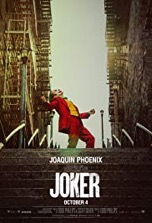
Starring: Joaquin Phoenix
October 2019
Warning! This is NOT a movie review. This is a critique of the film. Intended to initiate a dialogue, the following analysis explores various aspects of the film and may contain spoilers. Views are my own and elaborate on comments that were originally tweeted in real time from the back row of a movie theater @BackRoweReviews. For concerns over objectionable content, please first refer to one of the many parental movie guide websites. Ratings are based on a four star system. Happy reading!
If somebody said “Joker” in the 60s, the name Cesar Romero (from the Batman TV show) would immediately come to mind. In the 80s, the Clown Prince of Crime received a sinister facelift from Jack Nicholson (in Tim Burton’s Batman movie). In the 90s, Joker was brilliantly voiced by Mark Hamill (in Batman: The Animated Series).
Of course, since 2008, the name Joker has become synonymous with Heath Ledger’s mesmerizing portrayal of the anarchic antagonist in The Dark Knight (yes, Jared Leto played Joker in 2016s Suicide Squad, but his take on the madcap villain had neither the cultural relevance nor the staying power of Ledger’s). Even though it’s been over a decade since TDK captivated audiences worldwide, Ledger’s Academy Award-winning performance still looms large in people’s minds. In fact, many still struggle with accepting any other actor in the role.
But if anyone could pull off Joker, it would be Joaquin Phoenix…and he does, to a superlative degree. With all due deference to director Todd Phillips (The Hangover) and the army of artisans who crafted this astounding cinematic achievement, what would Joker be without Phoenix? His performance is the very definition of what it means to chew scenery (in the positive sense). I could gush about Phoenix’ refinement as an artist ad nauseam, as every other reviewer will from here to Arkham, but there are many other worthy aspects of the film to assess as well.
Just as Phoenix’ acting choices will be analyzed by fans and film students for years to come, so too will the movie’s directing, cinematography (Lawrence Sher), and story (Phillips and Scott Silver). The film evokes the gritty NYC milieu of Martin Scorsese’s 1976 masterwork, Taxi Driver, which starred Robert De Niro (who co-stars here as Murray Franklin, a Johnny Carson style late-night TV host) as Travis Bickle, a mentally ill working stiff who tries to assassinate a political candidate.
If there’s a knock on Joker, it’s lack of originality. Not only does Joker hearken back to Driver, it also wholesale borrows its premise from Scorsese’s The King of Comedy (1982), which starred De Niro as wannabe stand-up comic Rupert Pupkin. Pupkin is unemployed, lives with his mother, fantasizes about becoming famous, commits criminal acts and appears on a late-night show. Joker’s Arthur Fleck (Phoenix) has a similar journey, but whereas Pupkin’s mother always yells at him from off-screen, we actually get to see Fleck’s mother, Penny (Frances Conroy).
Penny claims to have had an affair with Thomas Wayne (Brett Cullen) in the past, which, in Fleck’s mind, makes him the son of a multimillionaire. Fleck visits Wayne Manor in an attempt at cutting in on his perceived inheritance and meets a young Bruce Wayne (Dante Pereira-Olson). This is the closest the film comes to the world of the comic book. Thankfully, the movie contains no characters with capes, cowls or names that begin with Bat or Cat.
If the film loses points for being derivative, it makes them up (in spades) with execution. The cast is solid from top to bottom and boasts some truly fine talent in tailor-made roles. Shea Whigham and Bill Camp shine as hard-boiled detectives who smell a rat with Fleck. Zazie Beetz is also perfectly cast as Fleck’s love interest—a kindred spirit who brings a measure of sweetness to his otherwise bitter life.
Joker would’ve fallen flat (like Pupkin’s comedy act) had it failed to engender sympathy for Fleck, whose uncontrollable fits of laughter are based on a real condition called Pseudobulbar affect (PBA). Due to these often untimely outbursts, Fleck is taunted, bullied and beaten. Although this inhumane treatment doesn’t forgive the heinous acts Fleck commits later in the film, it does produce pathos in the viewer and adds to the character’s complexity.
Phillips does an exceptional job of creating atmosphere in the film (although I wish he would’ve held his establishing shots a few seconds longer…to let them breathe a bit). The movie’s showcase sequence, where Joker dances his way down several flights of stairs, is exquisitely lensed and choreographed (and acted). The scene takes place 3/4ths of the way through the movie and marks a defining moment for the character. Even though it may seem like a strange comparison, those same criteria apply to the iconic scene in Rocky when Rocky Balboa (Sylvester Stallone) runs up the steps to the Philadelphia Museum of Art. However, the sequences are polar opposites both directionally and thematically (Joker’s giddy descent into evil is contrasted by Rocky’s arduous ascent to glory). Coincidentally, both characters have a five letter name. Curiously, Joker was inspired by Driver, which was released the same year as Rocky (1976).
In selected scenes, Phillips employs a filming technique that’s been used throughout motion picture history—particularly during the film noir period—where the camera frames a character through bars, window panes, chicken wire, grates, etc. Symbolically, this conveys that the character is trapped in some way, or is destined to be incarcerated. Cannily, whenever Phillips shoots his main character through wire glass (records room at the hospital) or metal bars (the front gate of Wayne Manor), Fleck is always on the outside where he’s able to walk or run away to maintain his freedom. When Fleck is finally captured and tossed into the back seat of a police cruiser, we expect the payoff of these visual cues to be Joker in jail. But Phillips shatters our expectations of Joker’s fate with a twist ending.
That controversial coda presents an interesting theory: what if the Joker in Joker isn’t our Joker (the one we know from comic books and other DC TV series/movies)? What if he’s merely a type of Joker, like the many people who wear clown masks and riot against the police near the end of the movie (such images recall the army of citizens taking to the streets wearing Guy Fawkes masks in V for Vendetta)?
Evidence to support this theory: 1. Arthur doesn’t kill the Wayne’s (admittedly, this is a weaker point since Joker isn’t always the perpetrator of the Wayne murders in the various versions of the Crime Alley vignette). 2. The name Arthur has never been one of Joker’s aliases (Jack or Joe are the most common). 3. There’s an age disparity in the film: Pereira-Olson is 9, Phoenix is 44. If the character’s ages are the same as the actor’s, Joker is 35 years older than Batman. That means by the time Bruce returns to Gotham (after training abroad) to take up the mantle of Batman, Joker would be headed toward retirement. That math doesn’t jibe with all other versions of the Batman/Joker mythos. Regardless of whether this theory holds water, only a psychological thriller this rich with meaning and nuance could produce such a mind-bending possibility in the waning seconds of the film.
In the final analysis, Joker is a masterfully macabre origin story of one of the most colorful and enduringly popular villains in all of fandom. Peerless directing and acting mark this frightening portrait of psychological derangement.
Joker is the least cartoony, most artistic comic book film ever made. Despite the jocularity of its lead character and its moments of black comedy (the hilarious “punch out” scene), Joker is a serious film about serious issues (cynicism, mental illness, class inequality, and the rise of anarchy). Due to its uber-graphic slaughter scenes, Joker is also the most mature superhero (or supervillain) movie ever made.
The sad reality is that the film will probably inspire mentally ill members of our society to attempt acts of violence similar to the ones portrayed in the movie. It’s also profoundly tragic that such little progress (socially and in the field of mental health) has been made in the intervening years between Driver and Joker.
The movie’s ending leaves things open to interpretation. It also leaves things open for a sequel. Unless it’s destined to become a landmark film like The Godfather Part II (1974), I say leave this modern masterpiece well enough alone.
I’m not joking.
Rating: 3 1/2 out of 4
The Girl in the Spider's Web (R)
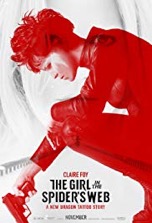
Starring: Claire Foy
November 2018
Warning! This is NOT a movie review. This is a critique of the film. Intended to initiate a dialogue, the following analysis explores various aspects of the film and may contain spoilers. Views are my own and elaborate on comments that were originally tweeted in real time from the back row of a movie theater @BackRoweReviews. For concerns over objectionable content, please first refer to one of the many parental movie guide websites. Ratings are based on a four star system. Happy reading!
Lisbeth Salander (Claire Foy) is back in The Girl in the Spider’s Web, based on the novel by David Lagercrantz and the characters created by the late Stieg Larsson. An extension of the American franchise (predated by a Swedish trilogy based on Larsson’s Millennium series) that began with David Fincher’s The Girl with the Dragon Tattoo (2011), Spider is directed by Fede Alvarez (Don’t Breathe) and features a largely foreign cast, which lends the film added authenticity. The story begins with computer hacker Salander accepting a job to steal top secret information. Soon after completing the task, Salander becomes the target of several international agencies including: the Swedish police, Russian agents, the NSA and a mysterious figure from her past. What has drawn the interest of such disparate entities? A computer program called Firefall, which can access the codes of every nuclear arsenal on the planet. And it’s up to Salander to make sure the program doesn’t fall into the wrong hands. The stolen files become the movie’s MacGuffin—the various parties are willing to go to any length to secure it, which presupposes an action-oriented plot. And indeed, the movie is packed with full throttle, well-choreographed action sequences that feel like they were lifted right out of a Bourne or Bond film. The motorcycle chase, culminating with Salander hurtling across an icy lake, is one of the most spectacular sequences in the movie. The bathroom brawl, vertical-lift bridge shoot-out and gas mask melee are also finely executed fight scenes. Foy (TVs The Crown) is absolutely spellbinding as misanthropic photo journalist Salander. Whereas Rooney Mara (from Dragon) tried to act anti-social and mad at the world, Foy just is. Though Foy is effective throughout, she’s downright frightening in her initial sequence where she goes vengeful vigilante on a woman beater—the makeup around her eyes gives her an added layer of feral intensity and makes her look like the newest member of the Suicide Squad. Salander’s boss and confidant, Mikael Blomkvist (Sverrir Gudnason), has a far less significant role in this movie and, disappointingly, doesn’t really factor into the story in any meaningful way. And, with apologies to Gudnason, he’s no Daniel Craig. The gorgeous locations, many of which were filmed in and around Stockholm, Sweden, add a great deal to the film and are truly mesmerizing and transporting. The cityscape establishing shots, particularly the ones shot at dawn, dusk or night, are breathtaking. Alvarez and his location scouts found some spectacular places to film, most notably an abandoned observatory. Such a locale is typically used as the villain’s lair, not the hero’s hideout, so kudos to Alvarez for bucking convention. There’s far more backstory for Salander in this film than in Dragon. At the beginning of the movie, we witness a deeply disturbing flashback scene where young Salander leaves her sister alone with their father. The scene gives us the distinct impression that the girls grew up in an incestuous environment. Due to Salander’s traumatic childhood, she distrusts most people, men in particular. Since one of the movie’s main themes is the sexual exploitation of women, Salander is held up as a type of avenging angel (or demon) when she ties up and tortures the man who batters a defenseless woman. On a psychological level, taking revenge on the man is a form of catharsis for Salander; tormenting the perpetrator is like getting back at her father. The film seems to suggest that such heinous deeds are justified and that “an eye for an eye” is a perfectly acceptable method of punishment under the circumstances. It’s ironic that her vicious attack makes Salander just as bad as the abusive man. But such irony is lost on a movie bent on glorifying violence and applauding vigilantism. Sad. Whereas Dragon was a well-constructed mystery; Spider is a high-octane spy film. Though lacking in star power, the story by Alvarez, Jay Basu and Steven Knight is a taut thriller that keeps the audience engaged all the way up to its cliffhanger ending. So, let the debate begin. Is Spider as good as Dragon? Regardless, if you can get past the movie’s objectionable content, this is one yarn you’ll be glad you got tangled up in.
Rating: 3 out of 4
Ocean's 8 (PG-13)
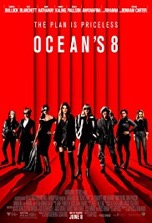
Starring: Sandra Bullock
June 2018
Warning! This is NOT a movie review. This is a critique of the film. Intended to initiate a dialogue, the following analysis explores various aspects of the film and may contain spoilers. Views are my own and elaborate on comments that were originally tweeted in real time from the back row of a movie theater @BackRoweReviews. For concerns over objectionable content, please first refer to one of the many parental movie guide websites. Ratings are based on a four star system. Happy reading!
Did you know that Ocean’s 8 is the fifth movie in the franchise? The original Ocean’s 11 (1960) starred the Rat Pack and centered on a casino heist in Vegas. George Clooney’s Ocean’s Eleven (2001) was similar to its progenitor but upped the ante by hitting multiple casinos at once. Ocean’s Twelve (2004) took place in Europe and was largely forgettable (other than the cameos by Bruce Willis and Topher Grace…as themselves). Ocean’s Thirteen (2007) was a return to form (Vegas casino heist) but proved to be one trip too many to the well. Confusingly, even though 8 is a sequel, its number would indicate that it’s a prequel. As with the new Ghostbusters (2016), 8 features an all-female cast. A female heist film? When women can pull off an elaborate crime just as well as men, it’s just another sign of our emasculated times. The movie opens with Debbie Ocean (Sandra Bullock), sister of the deceased Danny Ocean (Clooney), being released from prison. Debbie soon hooks up with gal pal Lou (Cate Blanchett) and they hatch a plan to steal the priceless Toussaint diamond necklace at NYC’s annual Met Gala. The rest of the team is comprised of a potpourri of top-tier performers including: Mindy Kaling, Sarah Paulson, Awkwafina, Rihanna and Helena Bonham Carter. Anne Hathaway plays a self-important actress who serves as the movie’s wild card. The only tether between this film and the Steven Soderbergh films is Elliott Gould, who reprises his role as Reuben Tishkoff in a brief cameo. Like a three-act play, 8 can be cut into thirds. After the initial excitement over watching Debbie do her thing (scheming and stealing), the movie takes forever to get going. The assembling of the team is flat and rote and the planning phase is belabored and overly methodical. The middle of the movie (the actual heist) is a high-stakes, fast-paced feat of cinematic chicanery—an enjoyable lark that singlehandedly redeems the movie. Most of the post-heist action is unnecessary and is tantamount to a bad magician explaining his trick…nothing is left up to the spectators to figure out on their own. This narrative inconsistency, between its three segments, is the movie’s biggest drawback. The directing by Gary Ross (The Hunger Games) is sure-handed but is surprisingly low energy at times. The cast is as dazzling as the MacGuffin necklace. In particular, Bullock and Blanchett have excellent screen chemistry. However, I never got the same sense of synergy among this cast that I did from the ensembles in the Soderbergh trilogy. In the end, 8 is a diverting film that has none of the panache, or humor, of the Clooney capers. The stellar cast suffers at the hands of a standard story that offers nominal thrills and twists and has a denouement that overstays its welcome. Still, future films seem to be in the cards. But what will the franchise do when it gets back to 11?
Rating: 2 ½ out of 4 stars
American Animals (R)
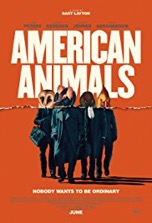
Starring: Ann Dowd
June 2018
Warning! This is NOT a movie review. This is a critique of the film. Intended to initiate a dialogue, the following analysis explores various aspects of the film and may contain spoilers. Views are my own and elaborate on comments that were originally tweeted in real time from the back row of a movie theater @BackRoweReviews. For concerns over objectionable content, please first refer to one of the many parental movie guide websites. Ratings are based on a four star system. Happy reading!
American Animals is the story of how four college-age men bungled their plan to steal some rare bird books in Lexington, Kentucky’s Transylvania University library. The premise sounds outlandish and fictitious. However, as the opening text emphatically states, the movie isn’t “based on” the real story, it is the real story. To ensure validity, director Bart Layton weaves canned interviews throughout the tapestry of the film. This creates a strange narrative flow between the documentary style interviews with the real-life criminals and the dramatized action with the actors portraying them. Other drawbacks are slow pacing and an initially confusing plot…interviewees reference the incident long before we learn the details of what happened on that fateful day in 2004. The film is packed with allusions to other movies, including the “bigger boat” quote from Jaws (1975) and the characters’ assumed aliases (Mr. Pink, etc.) which were inspired by Reservoir Dogs (1992). When things start to unravel during the heist—i.e. incapacitating the librarian and the plan B exit through the first floor stairwell—the film finally finds some energy and urgency. Much like the early stages of the movie however, the denouement is dragged out and many of the silent reaction shots, though emotionally impactful, are painfully long. The movie boasts a cast of talented young actors, headlined by Evan Peters, who plays Quicksilver in the newer X-Men movies. The only other recognizable face in the cast is Ann Dowd, who is best known for her work on TV’s The Leftovers and The Handmaid’s Tale. The most striking sequence in the film comes during the disguise prep scene when a close-up shot of one of the young men creating wrinkles around his eyes cuts to a painting of an owl (and how fascinating that a synonym for thief is owl). It’s a jarring, disturbing cut that hints at the animalistic impulses that are driving these characters toward baser behaviors. There’s a subtle inference that this transformation is also a psychological one (i.e. assuming the traits of different animals), but this potentially fascinating storyline is never explored. The film is a mishmash of themes including: youth is wasted on the young, anything that can go wrong will go wrong and crime doesn’t pay. The movie is also a conglomeration of many different plot elements like: art, crime, college life, documentary filmmaking, etc. This reveals the movie’s narrative indecisiveness—much like the young men it focuses on, the story is in search of an identity. In the end, AA is a unique film both in terms of its subject matter and story structure. If you’re looking for something different, this is it.
Rating: 3 out of 4 stars
Murder on the Orient Express (PG-13)
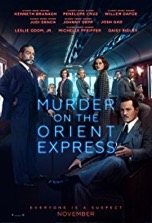
Starring: Kenneth Branagh
November 2017
What follows is the full-length review based on comments that were originally tweeted in Real-time from the back row of a movie theater @BackRoweReviews. Though efforts were made to tease rather than ruin this movie’s memorable lines and moments, some spoilers may exist in the following evaluation. For concerns over objectionable content, please first refer to one of the many parental movie guide websites. Ratings are based on a four star system. Happy reading!
The standard opening would say something like: “Based on the novel by Agatha Christie…” In this case, it’s more accurate to say: Loosely based on the novel of the same name by Agatha Christie, Murder on the Orient Express is a modern retelling of Christie’s seminal mystery yarn. Much to its detriment, this version of Christie’s magnum opus is more concerned with casting Hercule Poirot (Kenneth Branagh) as a superstar sleuth in the mold of Sherlock Holmes than as the humble, working man’s detective from the source material. The “loosely” argument is bolstered by the fact that director Branagh makes several significant alterations to the literary classic, the first of which comes during the movie’s opening when Poirot solves a mystery in the style of Holmes. Unfortunately, the case is exceedingly conventional and the specifics are muddled. We have no interest in the people involved in the whodunit since we just met them and could care less about the caper itself because we have no investment in its outcome. The whole sequence is gratuitous since it was designed solely for the purpose of demonstrating how marvelous a detective Poirot is…which we’ll figure out anyway once the titular murder has been committed. These are wasted minutes that could’ve been used for developing back stories or laying out the details of the homicide—both of which are cursory to the extreme in Branagh’s Murder. The procedural elements are breezed through—the clues (handkerchief with an embroidered H, pipe cleaner, broken watch and, later, scarlet kimono) are discussed in less than 30 seconds and the specifics of the murder (i.e., number of stabs, where and how severe the blows were, etc.) only take up about a minute of screen time. So what does Branagh spend the balance of the film on? Good question. It certainly isn’t on character development. Indeed, we get to know these train passengers far less than their counterparts in Sidney Lumet’s version of Murder (1974). That iteration of Christie’s book also had a decorated cast (Albert Finney, Sean Connery, Vanessa Redgrave, Michael York, Ingrid Bergman, et al.), but it could be argued that individuals in that movie were two-dimensional too. Branagh spends a few minutes of screen time on establishing shots of the train rolling along the European countryside. It’s a nice add since the technology didn’t exist in the 70s to create these sweeping, aerial landscape shots. However, the double-edged sword of technology is that it draws attention to itself. Here, our first impression is, “Wow, gorgeous vista,” and then our second thought is, “And it’s been rendered to death by CG artists.” As for the cinematography, Branagh makes the most of the cramped train set by using clever camera angles. Branagh employs a high angle shot twice—once when the body of loathsome Ratchett (Johnny Depp) is discovered and then during the examination of the corpse. One instance would’ve been sufficient, twice is overkill. Plus, both shots are long takes, which are more enjoyable for their artistic achievement than for their viewing pleasure. Another “loosely” item is the scene where Arbuthnot (Leslie Odom Jr.), who’s a doctor instead of a colonel in this rendition, shoots Poirot. Though his motivation is to protect Mary (Daisy Ridley), the good doctor earlier averred that he couldn’t harm a fly. This is the kind of inconsistency that drives Poirot, and savvy spectators, mad. Of course, the shooting serves the story as both a red herring and an action interlude, so its inclusion is understandable, if unacceptable. The next scene also has plenty of new material in it. For starters, none of the characters leave the train in Christie’s book. Here, all of the suspects sit at a table (where did it come from?) inside a train tunnel: the obvious visual antecedent here is da Vinci’s “The Last Supper.” This is the setting where Poirot solves the case, albeit in a less streamlined and cogent manner than in the book and earlier film. In particular, the two possible solutions aren’t explained very clearly. A compelling new scene involves Poirot offering himself up as a sacrificial lamb so that the guilty parties can go free. Poirot places a gun on the table, which affords the conspirators an opportunity to silence him. In a shocking twist, Mrs. Hubbard (Michelle Pfeiffer) grabs the gun and tries to off herself. Though not without entertainment value, this story embellishment falls flat when we learn that the gun is empty, making the whole sequence a pointless exercise, other than to generate some faux tension. Once the case has been solved and the train freed from the snow drift, the movie should come to an end. But the denouement is dragged out so that we can observe Poirot heading off to his next case—again, it’s obvious, and somewhat pathetic, that Branagh is so determined to portray Poirot as an in demand, top-shelf detective when he knows that the Belgium sleuth carries none of the clout or name recognition (at least in America) as Holmes, Spade, Marlowe or Hammer. Michael Green’s adaptation of Christie’s book is disappointing on so many levels there isn’t even a word to describe how poor his efforts are. Everything in the plot is done hastily. Like a runaway train, the story steamrolls along to its inevitable, predictable resolution. The elegance of Christie’s tale is in how it selectively dispenses clues and gradually reveals the motivations of its diverse, yet unified, characters. All of this is lost in Branagh’s Murder, which, in the end, is just a Reader’s Digest version of Christie’s masterwork. Murder’s expedience is its undoing. That’s a bitter reality since the film wastes a fine central performance by Branagh (which is much more enjoyable to watch than Finney’s, in my opinion). It’s also sad that the considerable talents of the rest of the spectacular cast were wasted on such perfunctory material. Ironically, that’s an even bigger crime than the one committed in the movie.
Jack Reacher: Never Go Back (PG-13)
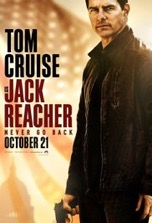
Starring: Tom Cruise
October 2016
The below comments (in Black) were originally tweeted in Real-time from the back row of a movie theater and appear @BackRoweReviews. Though efforts were made to tease rather than ruin this movie’s memorable lines and moments, some spoilers may exist in the following evaluation (in Red). For concerns over objectionable content, please first refer to one of the many parental movie guide websites. All ratings are based on a four star system. Happy reading!

“One guy took ‘em all out in like seconds.” #JackReacher
90 seconds until a bad cop is arrested. #MagnificentProphecy
“I woke up one morning and the uniform didn’t fit.” #CareerChange
“I don’t like being followed.” Yep, that’s daddy’s little girl.
“Welcome back to the Army, major. You’re under arrest.” #PlotTwist
“It’s time we stop running, and start hunting.” Yeah! #GameOn
“You’re very intense.” #JackReacher
“All you contractors go to the same barber?” LOL #GreatLine
“Never underestimate the charm of a seedy motel.” Ha! #SeedyMotel
“I don’t like being followed.” Hmm. Seems to me I’ve heard that before.
“People talk to me. It’s a thing.” Nice tip of the hat to #HowIMetYourMother. #ItsAThing
“Now the numbers add up.” #PureOpium
Bad guy gets hosed by Danika.
“It means we’re dead already.” Daddy/Daughter code.
Girl’s got #PhoneDrop skills.
Final analysis: a solid follow-up to the first film with some new characters and challenges.
Rating: 3 out of 4. Drags at times, but the action scenes are well executed. Cruise keeps cruising.
Based on Lee Child’s novel series, the first Jack Reacher (2012) movie introduced audiences to the title character, an anti-establishment, off-the-grid, ex-military drifter whose MO is cracking skulls while defending the little guy from evildoers. The follow-up film, Jack Reacher: Never Go Back, is a diverting, if not life-altering, sequel that finds Reacher (Tom Cruise) on the run from the military he once served as well as from his past; one of his former conquests had a daughter and is claiming that he’s the father…fourteen years after the supposed deed. To a former Special Forces lone wolf like Reacher, outrunning the MPs is a far less daunting challenge than raising a teenager. Fortunately, he gets some significant support in dealing with his alleged daughter, Samantha Dayton (Danika Yarosh), from a falsely accused Army officer, Major Susan Turner (Cobie Smulders). Together, Reacher, Turner and Dayton try to stay one step ahead of their pursuers while attempting to uncover an illegal arms racket inside the military, which will exonerate Turner. The story’s climax features a protracted chase sequence through the crowded streets of New Orleans during Mardi Gras—an action set piece that’s been done to death by now but somehow still manages to entertain. The scenes where Reacher says goodbye to his new-found friends are touching without being overly schmaltzy, which is consistent with Reacher’s laconic persona. The movie closes with Reacher thumbing a ride on the side of a highway—moving on to his next adventure like an Old West cowboy heading off into the sunset. Aside from some new characters and a few new scenarios, there really isn’t anything here that wasn’t in the previous movie. That’s not necessarily a bad thing for fans of the first film who just wanted more of the same in the sequel, but those seeking something other than just a reheated story may find this film wanting in the creative department. On the plus side, the acting is solid across the board: Smulders’ pluck is a plus as is Yorosh’s naïve self-assuredness. Cruise is satisfactory in the title role but doesn’t bring anything extra to the part this time, he just hits his marks and delivers his lines…and runs. Running has become a staple of every Cruise film; partly because he’s good at it and partly because a certain segment of his fan base really enjoys it. Here, Cruise is joined by the svelte Smulders on a few of his mad dashes—just to provide equal opportunity for ogling spectators. Although there are a few witty one-liners in the film, like Reacher’s pre-clobber comment about a thug’s barber, the proceedings are mostly serious and could’ve used more humor to counterbalance the dramatic and action beats. The fight sequences, coordinated by director Edward Zwick, are top-notch, yet feel like a retread of the multi-assailant melees seen in the prior movie. Even though Reacher 2 is an adequate sequel, has it done enough to extend the franchise into a trilogy? And if so, will audiences even show up for a third installment, or have they already decided to Never Go Back?
Hell or High Water (R)

Starring: Jeff Bridges
August 2016
The below comments (in Black) were originally tweeted in Real-time from the back row of a movie theater and appear @BackRoweReviews. Though efforts were made to tease rather than ruin this movie’s memorable lines and moments, some spoilers may exist in the following evaluation (in Red). For concerns over objectionable content, please first refer to one of the many parental movie guide websites. All ratings are based on a four star system. Happy reading!

The “no bailout” graffiti is telling. #NoBailout
“All you’re guilty of right now is being stupid.” Ha! #BungledHeist
Bury the car, bury the evidence. Clever.
“Tweakers don’t sleep, they just...tweak.” LOL.
“Ain’t one drill the same as the next?” #ThatsWhatSheSaid
Second car buried. How many vehicles do these guys have?
“Kicking around skulls.” The origins of #Soccer.
“What don’t you want?” This waitress is a hoot.
Large crowd in the Post bank. This can’t end well.
Roadblock. Intense scene.
“Lord of the plains.” #FamousLastWords
Great acting in the final scene with Pine and Bridges.
Final analysis: though the premise is well worn, the acting is superb & the cinematography is gritty real.
Rating: 3 out of 4. A dusty drama with a strong sense of place and an Oscar worthy performance by Bridges.
As exemplified in silent masterpieces like The Great Train Robbery (1903), heist films have been with us since the inception of cinema. The tone of such films can be elaborate, like in The Italian Job (1969, 2003) and Ocean’s Eleven (1960, 2001), intricate like Mission: Impossible (1996) and Entrapment (1999) or intimate like Thelma & Louise (1991) and Drive (2011). This offshoot of the thriller genre has remained popular throughout the decades and seems to find new scenarios despite its well established conventions. The new bank robbery movie, Hell or High Water, resembles the buddy movie model in Thelma more than the team approach featured in the Ocean’s series. This movie’s pilfering partners happen to be brothers, Toby Howard (Chris Pine) and Tanner Howard (Ben Foster). What incites the film’s robbing rampage is twofold: 1. Toby’s pressing need to support his family, and 2. Toby and Tanner’s desire to buy back the family farm from the bank after their mother dies. On the right side of the law is Texas Ranger Marcus Hamilton (Jeff Bridges), a Southern fried law enforcer who talks like he’s got a perpetual wad of chaw in his mouth and who walks around like he’s got a load in his pants (witness him running toward the motorcade during the movie’s climactic action scene for a prime example of this). Though a bit of a fuddy-duddy (with racist tendencies) Marcus is a shrewd old agent, skilled at anticipating the next move of the perpetrators he’s pursuing, which sets up a rather riveting game of cat-and-mouse with the Howard boys and serves as the backbone for the film’s narrative. Bridges has tapped into some of his recent roles for inspiration for his character here: Marcus is roughly 80% Rooster Cogburn from True Grit (2010) and 20% good ole boy Roy from R.I.P.D. (2013). This is a measured performance that only misses fully realized status due to the screenwriter Taylor Sheridan’s negligence in providing Marcus with a substantial back story. Still, Bridges’ acting is utterly captivating and should garner a serious look from Oscar voters. Pine and Foster are also very effective at bringing their respective roles to life as two brothers on completely different life journeys—Toby turns to a life of crime for the sake of his family, Tanner engages in illegal activities simply for the thrill of it. In the end, each of the brothers gets exactly what he deserves. Also serving as inanimate characters in the film are the authentic looking Texas towns and landscapes (which were actually shot in New Mexico) and the skillful way such stark, yet strangely beautiful, locations are framed by cinematographer Giles Nuttgens. Director David Mackenzie has presented a somber and atmospheric on-the-run adventure that’s enjoyable as much for its acting as for its story and settings. The straightforward storyline is extremely deceptive since it contains a good deal of character subtext and several unexpected turns along the way, especially the ironic coda, which reveals that a greater fortune than the one the Howard’s stole has been right under their noses all along. Ultimately, the film isn’t earth-shattering, but, as a hayseed heist film populated with superb performances and gritty real locales, it certainly isn’t a bad way to spend two hours.
Central Intelligence (PG-13)
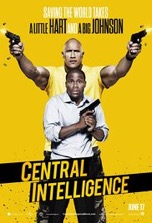
Starring: Dwayne Johnson
June 2016
The below comments (in Black) were originally tweeted in Real-time from the back row of a movie theater and appear @BackRoweReviews. Though efforts were made to tease rather than ruin this movie’s memorable lines and moments, some spoilers may exist in the following evaluation (in Red). For concerns over objectionable content, please first refer to one of the many parental movie guide websites. All ratings are based on a four star system. Happy reading!

The #GoldenJet gets upstaged by a whale.
#JunkMail Bigger is better, right?
“Black people don’t go to therapy.” Ha!
“You gained it back in muscle.” Lol
The #GoldenJet flip. #EpicFail
Nice use of printer toner in the shootout.
“You hit us!” The therapy session is hilarious. #SoulGaze
“Once a fat kid always a fat kid.” Punch him, Bob.
“The universe provides.” #GoldenJet
#SnakeGyllenhaal Ha!
“I’m the Black Badger.” Similar to “I’m Spartacus.” #Spartacus
“Bob just went commando.” Hilarious! #MicDrop
Final analysis: a humorous, though farcical, buddy movie with a positive anti-bully message.
Rating: 2 out of 4. Fans of the two stars won’t be disappointed by this oft silly story, but others...
So the latest in the long string of buddy movies is Central Intelligence, which features action star Dwayne “The Rock” Johnson and comedian Kevin Hart. Though the two become unlikely friends in high school (which we see in a prologue section), the action picks up twenty years later when “Most Likely to Succeed” Calvin Joyner (Hart) hasn’t succeeded and overweight, bully magnet Bob Stone (Johnson) is now an uber-buff CIA agent. Just go with it. Fittingly, the catalyst for the two former classmates being reunited is the occasion of their twenty year high school reunion. The plot kicks into high gear when Stone glad hands accountant Joyner into interpreting a list of offshore bank accounts in order to determine the purchaser of some secret satellite codes that, in the wrong hands, could spell doom for our planet. Clear as mud, right? Of course, most people coming to see this film aren’t expecting an Academy Award caliber screenplay; just Johnson’s patented “pec pop” (you’ll have to wait to the end credits for this) and Hart’s high-pitched, rapid-fire one-liners. Though many of the movie’s storylines and characterizations are utterly daft, there are some redeeming themes here, like: the power of friendship, the reprehensible nature of bullying and the importance of getting therapy (not the Barbershop variety). The anti-bully message has a great deal of relevance since bullying is rampant in our society, especially online and in our nation’s schools. The fact that many bullies remain unrepentant even into adulthood, as Jason Bateman’s obnoxious character illustrates, is despicable and sad. Another meaningful moment is when Stone purposely stalls the plane, forcing a bucket list confession from Joyner. It’s a decidedly ridiculous scene but it does reveal how facing our own mortality brings into sharp focus the things that matter most in life. Though I could’ve done without Stone dancing naked at the reunion, I realize that such scenes were a main draw for admirers of Johnson’s physique. The action scenes, though well choreographed, are occasionally ridiculous, like when Stone and Joyner jump out of a tall building and land on a gigantic inflatable ape…yeah right. Though addled with dunderheaded beats, the story maintains interest throughout and keeps us guessing where Stone’s loyalties lie right up until the very end. Despite the fact that this movie is a mediocre affair and an obvious rip-off of Rush Hour (1998), a sequel seems all but assured. Let’s just hope the next film has a more compelling story…this Intelligence doesn’t live up to its name.
Money Monster (R)

Starring: George Clooney
May 2016
The below comments (in Black) were originally tweeted in Real-time from the back row of a movie theater and appear @BackRoweReviews. Though efforts were made to tease rather than ruin this movie’s memorable lines and moments, some spoilers may exist in the following evaluation (in Red). For concerns over objectionable content, please first refer to one of the many parental movie guide websites. All ratings are based on a four star system. Happy reading!

“You don’t have a clue where your money is.” Scary reality.
“Glitch.” Is it possible this movie is unintentionally timely, i.e. the edited #Iran video?
#ErectileCream on a news set. #Random
“We don’t do journalism period.” Does anyone anymore?
#LeeGates has some decent dance moves.
Most lax security on a set ever. #Nitpick
“It’s all rigged.” Not exactly a news flash.
“Start hosting.” Way to turn the tables.
Shoot the star of a news show live on TV? Shades of #Network.
Buy #IBS, save a life. #TripleBuy
“You believe in money, not people.” #ShallowExistence
Who needs enemies with a girlfriend like that?
“It’s not the computer’s fault.” Sure, buddy.
“We have an 80% chance of an 80% chance.” Hilarious!
Talk with the weapons up. Negotiation at gunpoint.
“What’s wrong with making a profit?” Plenty if people are made to suffer for it.
Final analysis: a message film wrapped in a thriller built on a farce. Entertaining but not earth-shattering.
Rating: 2 1/2 out 4. Nice to see Clooney and Roberts together again even though they only share one scene.
If money is the root of all evil, Lee Gates (George Clooney), a Jim Cramer style stock tip show host, is desperately wicked. As the movie opens, Gates and his producer, Patty Fenn (Julia Roberts), are engaging in some good-natured banter as they prep for another episode. But as filming commences, an unexpected visitor drifts onto the set and sends the plot veering in a different, unexpected, and ultimately, less interesting direction. It’s rare that such scintillating stars (Clooney and Roberts in front of the camera and Jodie Foster behind it) should be attached to such a banal, lackluster film. What starts off as a compelling The Newsroom style TV studio drama rapidly morphs into a high stakes thriller with Gates doing his finest fast-talking to avoid being blown to bits by a suicide vest on national television (a knowing riff on Sidney Lumet’s prescient 1976 film, Network). The movie’s tonal shift is jarring and really detracts from what sets up as a dramatic edutainment centered on the turbulent world of finance. This bait-and-switch narrative choice may annoy or confuse some audience members since the genre at the beginning of the film isn’t the same as when it ends. Sadly, the more the thriller storyline progresses, the daffier the movie becomes and the more we don’t care who comes out alive…or who doesn’t. It’s a shame that such tremendous talent was squandered on such mediocre material and that the movie’s intriguing premise, which contains a salient message about the current state of our economy and its effect on the scores of struggling citizens in our society, is thrown away in favor of the kind of remedial fare you can find on any run-of-the-mill TV procedural. So what did the actors see in this script that made them want to sign up? Maybe it had nothing to do with the script and everything to do with Clooney and Roberts jumping at another chance to perform together (this is their fourth big screen collaboration). Or maybe their decision was simply based on a desire to work with Foster. Perhaps I’ve got it all wrong and their true motivation for making this movie wasn’t camaraderie or artistic integrity…just the money.
London Has Fallen (R)
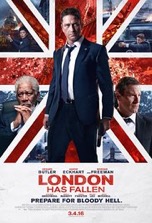
Starring: Gerard Butler
March 2016
The below comments (in Black) were originally tweeted in Real-time from the back row of a movie theater and appear @BackRoweReviews. Though efforts were made to tease rather than ruin this movie’s memorable lines and moments, some spoilers may exist in the following evaluation (in Red). For concerns over objectionable content, please first refer to one of the many parental movie guide websites. All ratings are based on a four star system. Happy reading!

“Vengeance must always be profound...and absolute.”
#GerardButler and #AaronEckhart are in a “presidential race.” Yuk, yuk.
#KevlarMatress It’ll sell.
“40 different countries with 40 different security teams.” What could possibly go wrong?”
“Nobody knows. That’s why it’s a surprise.” The way security should be.
Amazing FX on the bridge demolition.
How many times does the president have to be told to keep his head down?
“They only have to get it right once.” Frightening reality.
“Mr. President, those better be comfortable shoes.” #PresidentialRace 2.0.
“Never criticize, always encourage.” Words to live by.
“I was wondering when you were going to come out of the closet.” Hilarious!
“They should’ve brought more men.” Yeah!
“I won’t justify your insanity to make you feel better about yourself.” #PresidentialSteel
“The worst option is to do nothing.” So true.
Final analysis: a slow start turns into a decent actioner with a frighteningly topical story.
Rating: 2 1/2 out of 4. Will this film perform well enough to justify a trilogy? How about #ISISHasFallen?
London Has Fallen, sequel to Olympus Has Fallen (2013), features the same lead characters from the first film: the U.S. President’s security chief Mike Banning (Gerard Butler), U.S. Vice President Trumbull (Morgan Freeman) and U.S. President Benjamin Asher (Aaron Eckhart). Unfortunately, the sequel also employs the same basic plot as the original, with the only major twist being that the action takes place over the pond. The story sets up with the leaders of forty countries attending a funeral in London (and isn’t that just asking for it?) and the ensuing destruction that occurs when a well coordinated terrorist attack kills hundreds and razes several key buildings inside the city. The rest of the movie is one protracted pursuit with terrorists chasing Asher and Banning through the city in a series of action segments, including: frequent firefights and fistfights, motorcycle chases and a spectacular building demolition. Whereas the action is taut, the plot is not. Besides the characters stumbling out of a helicopter crash as if they’d just gotten off a Tilt-a-Whirl (and why don’t they have parachutes on a presidential chopper?), the fact that Asher and Banning emerge from the movie’s perpetual bullet storm without so much as a graze defies credulity. The dialog is also daffy at times, i.e., the “presidential race” and “coming out of the closet” gags which are clearly played for laughs. Beyond all of its standard action movie silliness, however, Fallen 2 is a frighteningly topical (perhaps unintentionally since the movie was filmed prior to the terror attacks in Paris) story that taps into very real fears over the growing radical elements in our modern world. The movie’s underlying, unspoken message is that our foes are clever and don’t mind playing the long game in order to secure a victory. The sad truth is that individuals dedicated to the destruction of others will find a way to accomplish their mission, regardless of how long it takes or how hard it is to execute (we saw this tragically demonstrated on 9-11). This hint of social significance is really the only thing that prevents this film from becoming yet another mindless action flick. The performances are solid but are largely dialed in (even the great Morgan Freeman plays his character exactly as you’d expect him to) and the direction by Babak Najafi is prosaic when evaluated alongside the typical film in its genre. So will we see another city fall in the future (Paris is off limits…forever)? The film’s performance at the box office will have major implications for the future of the franchise, but judging from this middling and formulaic entry, the series looks like it’s fallen and can’t get up.
Captive (PG-13)

Starring: Kate Mara
September 2015
This review was originally tweeted in Real-time from the back row of a movie theater and appears @BackRoweReviews. Though efforts were made to tease rather than ruin this movie’s memorable lines and moments, some spoilers may exist in the following evaluation. The original tweets appear in black, while follow-up comments appear in red. For concerns over objectionable content, please first refer to one of the many parental movie guide websites. All ratings are based on a four star system. Happy reading!

Yeah, a #CR meeting. Best place to go to work on life’s three “H”s.
Hurts, hang-ups and habits. “Keep coming back, it works if you work it and it won’t if you don’t!”
“I like it too much.” If you’ve ever said this, there’s a good chance you’re an addict.
Actually, it’s almost a certainty.
“A month...a few days.” #AddictsTimetable
You hear this type of revisionist history all the time on TV shows featuring real-life drug busts.
Ahh...the old pour a Coke on the battery trick. #Classic
And just think, we actually put that in our stomachs.
Brian isn’t a complete monster, he has a soft spot for his son.
His one redeeming quality.
Brian is in denial over raping a woman and Ashley is in denial over her meth habit. #DoubleDenial
Messed up people have an uncanny way of finding each other.
“My family doesn’t listen to me either.” #NoTrust
Of course, once you’ve burned enough bridges, you have no more credibility.
“You’re not my brother.” Got him!
“Lady’s first.” #CrisisMoment
If you were an addict desperately trying to quit, would you take at hit or a bullet?
Brian’s plan is to rob a bank and escape to Mexico. #RealOriginal
This is pretty much the plan every villain has in every Western book/movie script ever written.
Brian says, “I have a demon in me.” Hadn’t noticed.
He also has drugs in him. Probably doesn’t help matters any.
The car stall scene is intense.
You just knew this was going to happen since they set it up earlier in the movie.
The greatest tragedy is a “life without purpose.” #PDL #Saddleback
One of the many great lines from The Purpose Driven Life by Rick Warren.
“Goodbye, Little Man.” Touching voice mail message.
It’s sad when you think of all the little men out there who will never get to meet their dads because they’re doing time for doing illegal things.
“You don’t have to be perfect to be used by God.” A #PowerfulMessage from @RickWarren. #Saddleback
In fact, many of the people God used in the Bible were far from perfect.
Final analysis: a powerful true story of how one woman finds redemption amid a life-changing tragedy.
And one man’s courage to do the right thing by letting the woman go and surrendering himself to the authorities.
Rating: 3 out of 4. A hope-filled story and fine performances help to overcome the movie’s budgetary constraints.
Based on the true story of how Folsom County prison inmate, Brian Nichols (David Oyelowo), escaped from his cell, killed four people (including a judge) and became the focal point of one of the most high profile manhunts in our country’s history, Captive is a tragic tale but also a story of courage, hope and forgiveness. The events portrayed in Captive take place in 2005 during a terrifying and tragic eight hour period and are adapted from the book of the same name written by Ashley Smith, the woman Brian holds captive when he tries to hole up and evade the police dragnet. Ashley, played by Kate Mara, is a meth head who is trying to get her life back on track so that she can regain custody of her daughter. Fate, or perhaps a higher power, puts these two tragic figures together and the results are, by turns, intense and inspiring. The first thing most viewers will notice about the film is that it doesn’t have a very big budget. The second thing that will register with the audience is that the producers wisely allocated a generous portion of their budget to securing A list actors, namely Golden Globe nominee Oyelowo (Selma, 2014) and Mara (House of Cards). Since the majority of the film features both actors, either together or separately, the lead performers had to be solid if the film had any chance to succeed, so money well spent on these two fine performers who fit their roles perfectly and work extremely well together. The story maintains its intensity throughout and the riveting drama is punctuated by thriller-esque moments, like when Ashley’s car breaks down at night in the pouring rain. The climactic sequence, where police close in around Nichols, is also quite suspenseful. The movie’s theme of redemption isn’t necessarily subtle, but it isn’t driven home with a jackhammer either…thankfully. Though there’s a strong religious underpinning here, the film never comes off as preachy. In fact, this movie should serve as a template for other “religious” dramas: it’s a gripping true story that has some top talent and a faith-affirming message that’s conveyed organically rather than foisted upon its audience. Some sports movies, like Facing the Giants (2006) and last year’s When the Game Stands Tall have already perfected this faith-based film formula. Granted, due to its conspicuous message and/or shoestring budget, Captive won’t be everyone’s cup of tea. At the very least, the film has given us a big screen treatment of the ripped-from-the-headlines account of Nichols’ prison break and subsequent life changing encounter with Smith. So, whether or not you find the film illuminating, hopefully you’ll find it captivating.
Furious Seven (PG-13)

Starring: Vin Diesel
April 2015
This review was originally tweeted in Real-time from the back row of a movie theater and appears @BackRoweReviews. Though efforts were made to tease rather than ruin this movie’s memorable lines and moments, some spoilers may exist in the following evaluation. The original tweets appear in black, while follow-up comments appear in red. For concerns over objectionable content, please first refer to one of the many parental movie guide websites. All ratings are based on a four star system. Happy reading!

Can’t believe it’s been well over a year since his passing. How bitterly ironic that it was a car accident that took him from us.
“You can’t outrun the past.” Unless you have a really fast car.
That’s equipped with a flux capacitor.
“An open road helps you think.” Conversely, heavy traffic constricts thinking.
Or worse yet, fuels #RoadRage.
Who brings a sledgehammer to a cemetery?
And what good would it do to shatter a headstone anyway? The family would still know where the grave is and public records would have an accurate record of who’s buried in the plot. Strange motivation.
Amazing fight scene at the PD. A real backbreaker.
A friend of mine (a female mega fan of Johnson’s) says The Rock’s physique is too big now. Opinions?
“No more funerals.” In an action movie? Not likely.
Of course, we’re tricked into thinking that one of the main characters will die, but…psyche!
What happens when neither driver flinches in a game of chicken? #BahBoom #AirbagCheck
This just shows how insanely macho Diesel and Statham’s characters are. However, it’s this excess of testosterone that makes for a thrilling showdown at movie’s end.
God’s Eye. The Patriot Act on speed.
Similar to “The Machine” in TVs “Person of Interest.”
“Completely wrong thinking. And I like it.”
A quote that perfectly captures this movie’s fly-by-the-seat-of-your-pants plot.
Backing a car out of a plane. #InsaneButterflies
If you allow yourself to get lost in this sequence, it’s quite an adrenaline rush.
“Touchdown, baby.” And we’re not talking about football.
“You might want to put on your helmet for this one.” A fitting slogan for the entire movie.
Make sure your seatbelt is snug too.
“Double alpha.” #ManCandy Ha!
Tyrese Gibson is this film’s comic relief and is quite effective in his role.
“What’s real is family.” #TrueThat
One of the only redeeming aspects of these characters is how they look out for each other as if they were a biological family.
The #Goldfinger dancers are a bit much.
However, this is an action movie, and they are in Dubai.
Game of Chicken 2.0. Just as destructive as the first.
With a twist at the end. It’s all about getting the upper hand.
“Woman, I am the cavalry.” #OneManArmy
A great line taken right out of Schwarzenegger’s playbook.
“The street always wins.” Good line.
And the street always extracts its price in blood.
Final analysis: amazing action sequences compensate for the movie’s shallow characterizations.
The touchy feely sequence at the beach doesn’t make up for the dearth of character development throughout the rest of the movie.
Rating: 3 out of 4 stars. The touching tribute to #PaulWalker at movie’s end puts it over the top.
Back when The Fast and the Furious was released in 2001, I’m sure no one could’ve guessed that the concept had the potential to spawn a franchise that would span fourteen years and include seven films (to date). Of course, the bigger headline here is that this is the final film to feature Paul Walker, who fatefully died in a car accident back in November of 2013. His work lives on in this movie, which contains original footage plus a few CG facial composites of the actor near the end of the film. If you’re a fan of the series, you’ll be ecstatic over this movie’s soft-core plot and hardcore action sequences. Replete with stock characters and customized cars (I’d prefer the reverse), the film is chockablock with high-octane stunts that achieve a high level of success with varying degrees of believability. Judging by the action scenes alone, this film is arguably the finest in the series. The protracted adrenaline rush that begins with parachuting cars and ends with Walker sprinting for his life toward the safe end of a bus that’s rapidly plummeting off a cliff is one of the finest action sequences in film history—immaculately storyboarded and supremely executed by director James Wan. As for the movie’s acting, Vin Diesel is as wooden as your grandmother’s armoire, but somehow manages to be the glue that holds the whole works together in his starring role as gearhead ringleader, Dominic Toretto. On the other side of the law, Dwayne “The Rock” Johnson is sidelined for much of the movie but makes the most of his limited screen time with several Schwarzenegger style feats of machismo during the movie’s climax. Kurt Russell is a nice addition to the cast as the leader of a secret spy organization, but his character doesn’t factor into the action as much as we’d like. As for the rest of Toretto’s posse, each member of the diverse cast plays his/her part well, but none of the performances stand out as exceptional. But, this kind of movie typically doesn’t feature fine acting, so fairness demands that I refrain from criticizing the performances too harshly. In the end, this full throttle actioner fills the bill as a pulse-pounding popcorn flick. And while it’s sad to see Walker drive off into the sunset, the movie appropriately pays its respects to the actor while bringing closure to his character’s story line. Thanks for all the miles and memories, Paul. RIP
Kingsman: The Secret Service (R)

Starring: Colin Firth
February 2015
This review was originally tweeted in Real-time from the back row of a movie theater and appears @BackRoweReviews. Though efforts were made to tease rather than ruin this movie’s memorable lines and moments, some spoilers may exist in the following evaluation. The original tweets appear in black, while follow-up comments appear in red. For concerns over objectionable content, please first refer to one of the many parental movie guide websites. All ratings are based on a four star system. Happy reading!

Firth won the Academy Award for Best Actor for The King’s Speech (2010). What does that have to do with this film? Nothing, other than the fact that they both have “King” in the title.
A surprise cameo from a galaxy far, far away.
He’s an over-the-pond professor who did his doctoral thesis on “The Multiplicative Capabilities of Interconnected Moisture Vaporators.” It was released in book form by Tosche Press.
#SamuelLJackson with a lisp is a hoot.
I know it’s mean-spirited to laugh at a person with a lisp, but Jackson’s delivery makes it impossible to keep a straight face.
Holo-glasses...a nifty invention.
“Manners maketh the man.” Firth teaches some thugs a lesson. An exciting fight scene.
And more than a little unbelievable. But it’s also a lot of fun, which is all that matters, I suppose. Correction: “Manners maketh man.”
Amnesia darts would come in handy.
Sometimes a self-inflicted amnesia dart would be helpful.
“Like in My Fair Lady.” Hilarious!
This is the scene where I knew we had a runaway romp on our hands. Flawless comedic timing.
This elevator ride reminds me of the Haunted House ride at #Disneyland.
Without the silly vertical wall paintings.
The body bag initiation puts things into perspective.
There’s no name for the Chinese “thecret thervice.” I’m dying!
Easily one of the funniest scenes in the movie.
Choose a dog...but choose wisely.
At least he didn’t select a Chihuahua.
The skydiving scene is as pulse-pounding as they come.
This was an extremely well executed action sequence that makes you feel like you’re free-falling right along with the rest of the characters.
“Give me a far fetched theatrical plot any day.” Here, here.
Movies with overblown, hyper real action scenes and melodramatic villains have their own unique charm.
Jackson and Firth share a “happy” meal.
Wonder who got to keep the toy.
Fitting Room 3. Bond’s Q would be envious.
Actually, he’s probably the one who invented all of these weapons and devices.
The three J.B.s scene is amusing.
No, one of them isn’t James Brown. Or Josh Brolin. Or Justin Bieber. Gag!
Brutal, protracted fight scene in a Kentucky church.
In truth, it was too long and too bloody for my taste. And how many bullets does Firth’s gun carry anyway…50?
“This ain’t that kind of movie.” Clearly not, from what happens next.
Remember this line. It comes back around to bite Jackson in the ath.
Reconnecting the satellite link. I’m literally biting my fingernails.
OMG! The head exploding sequence is probably the funniest macabre scene I’ve ever seen.
Sometimes, when something strikes my funny bone just right, I just start laughing uncontrollably. This sequence had that effect on me; like I’d inhaled a deep lungful of laughing gas.
Final analysis: the best un-Bond movie ever, with incredible action scenes and humor to spare.
Rating: 3 out of 4 stars. I haven’t laughed this hard in the theater in quite some time.
I must admit that this film took me by surprise. I knew it was going to be an action packed spy flick (based on the comic book “The Secret Service”), but I had no idea it would have laugh-a-minute hilarity to go along with its thrill-a-minute intensity. Though belonging to an altogether different narrative universe, this film reminds me of last year’s Guardians of the Galaxy, which was a very effective mixture of humor and action. That formula works like magic here on a story that boasts a truly unique spin on the by-now hackneyed sub-genre of spy thriller. This might look like a spy movie spoof, but looks can be deceiving—like the dressing rooms inside a particular London tailor shop. This film is actually more like an alternate reality version of a MI6 mission—it’s what a Bond movie would look like if it were directed by Robert Rodriguez. As would be expected, Colin Firth, Michael Caine, Samuel L. Jackson and Mark Strong are all superb in their roles, but it’s really youngster, Taron Egerton, who steals the show as Firth’s protégée and Kingsman initiate, Eggsy (no, it’s not a typo). Egerton plays Eggsy with a chip on his shoulder, but also infuses him with just enough good-natured irreverence and boyish charm to make him appealing to the audience. Kudos goes to director Matthew Vaughn (X-Men: First Class) for prohibiting his action sequences (with the exception of the church debacle) from running away with the movie. The character development is fairly shallow here, and yet we’re still fully invested in what happens to them, which is somewhat of an anomaly for a contemporary action film. The real star of the movie is the screenplay, written by Vaughn and Jane Goldman. The dialog is razor sharp and witty beyond compare. The story skillfully pokes fun at the spy genre without outright lampooning it. It’s also a well crafted yarn that includes several gobsmacking plot twists. The only caveat here is that the film might be offensive to some viewers (e.g., the pervasive foul language, inappropriate sexual references and mass killings inside a church). The parenthetical items notwithstanding (and lest we forget, this is a Rated R film), this is the most hilarious thrill ride that’s graced the silver screen in quite some time. So has this movie done enough to garner a sequel…or a franchise? In a word, yeth.
Nightcrawler (R)
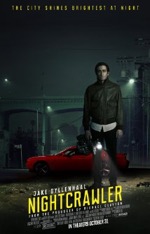
Starring: Jake Gyllenhaal
October 2014
This review was originally tweeted in Real-time from the back row of a movie theater and appears @BackRoweReviews. Though efforts were made to tease rather than ruin this movie’s memorable lines and moments, some spoilers may exist in the following evaluation. The original tweets appear in black, while follow-up comments appear in red. For concerns over objectionable content, please first refer to one of the many parental movie guide websites. All ratings are based on a four star system. Happy reading!

Gyllenhaal creates his own job as a freelancer.
After striking out with two potential employers, Gyllenhaal decides to take matters into his own hands and forge his own job description.
Gyllenhaal sees his “graphic” shooting clip on the news.
A monster is created. The chance to become famous for filming gruesome images at accident sites is like crack cocaine to Gyllenhaal’s narcissistic opportunist.
Gyllenhaal arrives late to a structure fire thanks to the ineptitude of his new intern.
Don’t worry, Gyllenhaal will get him back later in the film. And how!
Now that’s a significant upgrade in vehicles.
Though, it’s not very inconspicuous is it? In the scene where Gyllenhaal flees the scene of the shooting, wouldn’t his flashy sports car draw the attention of cops responding to the emergency? As a getaway car, his original beater would’ve been better suited for flying under the radar…plus, with the way Gyllenhaal drives, why would you risk crashing that beautiful new vehicle?
Gyllenhaal “sets the scene” at a car accident.
Clearly he never took a first aid course, because you never move an injured individual at an accident site for fear of creating or exacerbating a neck injury.
“A friend is a gift you give yourself.” Creepy!
Gyllenhaal films the accident he created. Now that’s cold.
Poor Bill Paxton didn’t know he was dealing with a nut job when he offered to partner with Gyllenhaal. Side note: Paxton played another adrenalin junkie in Twister (1996). However, the risk here is probably a little less and the pay is probably far better. It would be funny if this was an older version of the same character, who decided to settle down and get a respectable job after having his fill of chasing tornadoes.
Capturing a shooting in progress. Now that’s an exclusive.
This is a very grizzly sequence, especially in its original, non-blurred format. This sequence puts Gyllenhaal’s character on the map and also explodes the movie’s theme of ethics in media.
Gyllenhaal sets up his own exclusive. A dangerous game.
He uses cops as pawns in a scene that he’s created for his own amusement and professional advancement. Frightening!
Filming a high speed chase from right behind the pursuing cop car. Crazy!
You know this will be the next kick for those who like to live their life on the edge. Chasing tornadoes was so 90s.
Withholding information…minor detail.
Final analysis: a telling, salient story of media sensationalism gone awry.
Rating: 3 out of 4. A disturbing portrait of a troubled soul who finds his niche by capturing the shocking.
“If it bleeds, it leads,” Bill Paxton’s character says as he walks, no…swaggers, away from the scene of an accident with video camera in tow, brushing right past Jake Gyllenhaal, who’s late to the scene. Too late, it turns out, to sell his footage to a news station, because when it comes to independent footage, as with life itself, the early bird gets the worm. Conversely, I suppose the late bird gets the night crawler. Appropriately, that’s the name (nightcrawler) for these thrill-seeking freelancers who listen to police scanners and try to beat emergency vehicles to the scene of an accident in order to provide (for a price) local news affiliates with exclusive footage of the catastrophe. As if that premise wasn’t intriguing enough, the movie boasts a compelling character study and some searing commentary on the condition of our society. Gyllenhaal’s portrayal of a nightcrawler named Lou Bloom is undeniably brilliant—Bloom is a bundle of quirks and neuroses rather than just one idiosyncratic behavior, which seems to be all the rage in entertainment these days…especially on TV. To whit: Tony Shalhoub made the titular obsessive-compulsive detective famous on Monk, Claire Danes continues to astound as a bipolar CIA agent on Homeland and young Max Burkholder is masterful in his depiction of a preteen with Aspergers on Parenthood. The list goes on and on, but these clear-cut characters with easily diagnosable psychiatric conditions (even for a layman) often lead to predictable or caricatural enactments since the personality traits exhibited by such people are so distinctive and well-defined. Again, Gyllenhaal’s nuanced performance is utterly captivating because it adroitly avoids the obvious “Hey, guys, I’m playing an egomaniacal sociopath” telegraphing that frequently accompanies roles where attention is drawn to a character’s mental challenge or affliction. Acting aside, writer/director Dan Gilroy and cinematographer Robert Elswit do a superb job of capturing the distinctive look and mood of L.A., particularly during the night scenes. In many ways, Gilroy’s framing choices remind me of those in Nicolas Winding Refn’s Drive (2011), another nocturnal neo-noir that featured a generous portion of pulse-pounding racing through the city’s main arteries and side streets. As in Drive, the City of Angels serves as an additional, non-corporeal character in this film. I won’t belabor the movie’s not-so-subtle treatise on the current state of the news, but its message of morality (or lack thereof) in media is poignant, especially in light of the fact that many traditional news outlets have resorted to sensationalizing stories in order to compete with social media and online news sources. Sad to say, but traditional news just can’t satiate the appetite of a society that’s incessantly and exponentially drawn to the extreme, graphic and profane (all of which are shamelessly showcased and promulgated by YouTube videos, reality/late night/political commentary TV shows, etc) more than actual vetted and sourced journalism. At the time of this writing, HBO’s superb drama, The Newsroom, will air its final episode this weekend after three abbreviated seasons. As a show about a fictitious news network, The Newsroom never found a large enough audience to sustain a lengthy run, which is a profound disappointment since Aaron Sorkin’s topical, whip-smart drama is top shelf TV and deserved a better reception and fate than what it received. The characters on the show often express frustration over the fact that true journalism is being rapidly replaced by hack-on-a-corner reporting...after all, any idiot with a cell phone can capture or create the news these days. The grim reality we now face is that experienced and informed news anchors like The Newsroom’s Will McAvoy (Jeff Daniels) are becoming an endangered species, thanks to the Lou Bloom’s of the world. In a very real sense, these Joe Camcorders and late night creepers are holding the medium hostage. It’s enough to make your skin crawl.
A Walk Among the Tombstones (R)
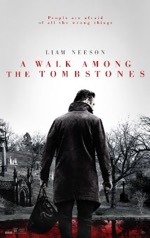
Starring: Liam Neeson
September 2014
This review was originally tweeted in Real-time from the back row of a movie theater and appears @BackRoweReviews. Though efforts were made to tease rather than ruin this movie’s memorable lines and moments, some spoilers may exist in the following evaluation. The original tweets appear in black, while follow-up comments appear in red. For concerns over objectionable content, please first refer to one of the many parental movie guide websites. All ratings are based on a four star system. Happy reading!

Not quite, since this movie is significantly darker than the Taken films and since it involves absolutely no abductions.
Two shots before a shootout.
Drinking and driving is bad enough, but shooting while sauced seldom ends well.
Neeson turns down a job and gets his eight year chip.
A win/win. However, if things ended right here, we’d have a pretty short movie.
An elaborate back story for Neeson’s new case. I smell a setup.
The man who hires Neeson is played by Dan Stevens from Downton Abbey. Another DA star, Michelle Dockery, appeared with Neeson earlier this year in Non-Stop.
Neeson takes the titular walk. Meets the creepy groundskeeper.
Played by Olafur Darri Olafsson (of course it wasn’t fun to type). He looks like the destitute, mentally challenged child of Kevin Page, Bum from Dallas (2012).
Neeson tails a POI and is tailed.
No East Village Plumbing. No surprise.
The punch through the glass is awesome.
One of the coolest scenes in the movie.
The 12 steps narrated over the firefight makes for a unique sequence.
There’s definitely some art here, especially the sobering voice over and freeze frame techniques.
Final analysis: a deliberately paced thriller with an understated but effective turn by Neeson.
Rating: 2 1/2 out of 4. A tale of redemption that’s worthwhile if only for Neeson’s performance.
The most compelling screen heroes have always been the ones beset by some kind of mental or physical flaw…the more severe or debilitating the flaw is, the greater the exultation is at the end of the movie when the protagonist overcomes his limitations, defeats the villain and saves the day. Here, Liam Neeson’s former cop/present private detective is a recovering alcoholic—his problem affected his on-the-job performance which led to his swift departure from the force. The pivotal incident in Neeson’s past serves as opening prologue and intermittent back story, delivered in a series of stylized flashbacks, and is the movie’s spine, or, more appropriately, its heart. Unfortunately, the rest of the movie is standard B-grade thriller fare. The case Neeson accepts is similar (though, admittedly, more graphic) to the plethora of conventional crime plots featured on the ubiquitous network TV procedurals. Other than the movie’s star, the rest of the performers, though well-suited to their roles in most cases, fail to exhibit big screen chops. This should come as no surprise since many of the supporting players here have spent a significant portion of their careers making a name for themselves on the small screen: Dan Stevens (Downton Abbey) and David Harbour (Manhattan) to name just a couple. One aspect of the film that works particularly well is the soiled and seedy NYC locations that serve as immersive backdrop and locus of action throughout the film…the foreboding cemetery, panoramic rooftop, well-appointed or ramshackle residences and even the sparsely populated municipal library are all used to great effect in making this modestly budgeted film seem a bit more prestigious. Credit director Scott Frank with adding visual variety and visceral verve to the handful of action sequences, particularly the poetic, climactic shootout (see above). All things considered, Tombstones isn’t a stellar thriller, but it’s unique in its own right and has much to recommend it. At the very least, this film should tide us over until Tak3n.
The Equalizer (R)
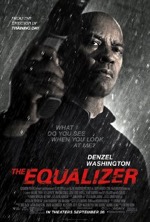
Starring: Denzel Washington
September 2014
This review was originally tweeted in Real-time from the back row of a movie theater and appears @BackRoweReviews. Though efforts were made to tease rather than ruin this movie’s memorable lines and moments, some spoilers may exist in the following evaluation. The original tweets appear in black, while follow-up comments appear in red. For concerns over objectionable content, please first refer to one of the many parental movie guide websites. All ratings are based on a four star system. Happy reading!

The TV show starred Edward Woodward as a 60 something British chap embroiled in Cold War intrigue. The show featured mostly average stories with standout performances by Woodward and Robert Lansing.
Profound quote by Twain opens the film.
Denzel tells Moretz the story of The Old Man and the Sea. Then she climbs into the back seat with a whale.
A visual connection was made and I just couldn’t help myself.
Moretz beaten and in the hospital. Something tells me Denzel will soon be trading his book for a gun.
Of course, who needs a gun when you can use a book the way Denzel does?
Denzel gives thug a corkscrew tongue ring.
A gruesome visual, but this scene, along with the climactic showdown, are the finest action sequences in the movie.
“Hit it on something stupid.” Ha!
Denzel exposes two dirty cops. Introduces them to his own brand of justice.
Denzel hides out in a dark alley and quickly routs the pair of corrupt detectives. Now all he needs is a raspy, whispery Christian Bale voice and a super suit and his journey toward becoming a full-fledged vigilante will be complete.
Hooded robber holds up a register at Denzel’s store. Hammer time!
Just think, whoever purchases that hammer will inadvertently own a weapon that was used in an assault.
“We who?” Got him.
An intense stare down between protagonist and antagonist. Award the round to Denzel for doggedly persisting in asking the above question.
Parting gifts scene is hilarious.
Now that’s a severance package I can get on board with.
Great Eastern goes up in flames. Amazing pyrotechnics.
Must admit, the home and garden section offers a variety of unique weapons.
What seems like an unspectacular locus for a final showdown actually works quite well, thanks to Denzel’s clever use of the implements at hand.
You might say that Denzel nails the bad guy.
Final analysis: a decent revenge story with some incendiary action sequences.
Rating: 2 1/2 out of 4. Too slow at times, but has some clever fight scenes with unconventional weapons.
Let’s face it; this is a pretty unremarkable film. Despite bringing his Best Actor chops to the part of Robert McCall, a retired secret agent forced back into action under predictable, usual circumstances, Denzel can’t quite elevate the evanescent effort that is The Equalizer. Of course, it wouldn’t be fair to blame Denzel for this lackluster affair since he isn’t given much to work with—McCall’s characterization is paper thin and has none of the complexity or believability that Denzel’s characters possessed in Training Day (2001) and Man on Fire (2004). Although Denzel anchors the film, solid support comes from Chloe Grace Moretz, who makes the most of a limited role as an ingénue trapped in a life of prostitution, and Marton Csokas, who is serviceable as the standard issue Russian baddie. The performances aren’t stellar, but let’s leave the acting alone since it’s the one bright spot in the film. Director Antoine Fuqua (Olympus Has Fallen), like his star, makes the most of what he has to work with, but does little to spruce up the film’s bland visuals, with the one exception being McCall’s self-timed killing spree. Fuqua’s workmanlike direction certainly isn’t spectacular, but it also can’t be blamed for the movie’s middle-budget look and stuck-in-neutral narrative. The true culprit for the movie’s mediocrity is its flaccid screenplay, turned in by Richard Wenk (The Expendables 2). Apart from the early scenes between Denzel and Moretz—the subtext during The Old Man and the Sea conversation is quite good—the dialog is stiff, the pacing is slow and the locations ordinary beyond belief. In fact, you could argue that stripped-down locations (diner, home improvement store, baseball field, etc), the straightforward story and Denzel’s spare portrayal all contribute to the unified feel for the film…a gritty, no-frills crime flick. The fact that the homogenized appearance and theme isn’t very cinematic is a major drawback aesthetically, and the movie’s dark tone and subject matter makes it hard to enjoy at times. While it’s always nice to see Denzel, he’s severely underserved here: this outing will go down as a lesser entry in his filmography. It’s a shame that the script squanders his solid lead performance with standard locations and situations. In the end, the writing just wasn’t equal to the task.
The November Man (R)

Starring: Pierce Brosnan
August 2014
This review was originally tweeted in Real-time from the back row of a movie theater and appears @BackRoweReviews. Though efforts were made to tease rather than ruin this movie’s memorable lines and moments, some spoilers may exist in the following evaluation. The original tweets appear in black, while follow-up comments appear in red. For concerns over objectionable content, please first refer to one of the many parental movie guide websites. All ratings are based on a four star system. Happy reading!

Taking pictures of pictures in Moscow.
Sounds easy enough, but it’s a dangerous occupation. Especially if you forget to return the key.
“42 is complete.” Now you’ve gone and made Brosnan mad.
Brosnan’s Bond always had to work really hard to dispatch bad guys, but his character here is more like 24’s Jack Bauer…casually strolling along and downing assailants as if he’d memorized enemy emplacement patterns in a FPS video game.
“Atrocities are like reality TV.” Hmm...
The film is pretty soft on social commentary, but this is one instance where ethical criticism is dispensed. And it’s a point well made.
Brosnan finishes his pupil’s training. An incisive scene.
Not to put too fine a point on it, but this scene has a surprisingly sharp edge.
Brosnan extracts information by playing an old Russian game.
I don’t think I’d wait until after the second click to divulge the intel though. Either squeal from the start or hold out to the bitter end…that’s the way I see it.
Corrupt agent discovers Brosnan’s “soft underbelly” and exploits it.
This plot point is poetic injustice since having a relational liability is precisely what Brosnan warned his protégé about from the very beginning. Do as I say not as I do, apparently.
Final analysis: a decent yarn with foreign flair and some pulse pounding action scenes.
But don’t expect Bond or Bourne levels of high-octane chase/fight scenes.
Rating: 2 1/2 out 4 stars. Brosnan isn’t Bond anymore, but he’s still respectable in action roles.
Kudos to the movie’s casting department because this project was a perfect selection for the gracefully aging action star. Brosnan is in remarkably good shape, so espionage yarns with moderate action work are still on the table for the spy genre stalwart. Let’s cut right to the chase, this is a well acted/directed/written political thriller with beautiful European locations and a clutch of adroitly choreographed action sequences. If there’s a drawback to the film, it’s the story’s first twenty minutes, which play an elaborate game of hopscotch all over Europe while setting up the plot and key players in this international intrigue. The rapid globetrotting is exhausting, not to mention confusing, and needlessly muddies the premise to the point where we don’t know what the movie’s goal is or even where in the world the bulk of the action is going to take place. Or even if we’ll care once we figure these things out. Once the story finally settles in, which is right around the time Operation 42 is executed, the enjoyment factor begins to gradually increase since at least we know which direction the plot is headed in at that point. The reemergence of Brosnan’s former pupil is an engaging subplot, but one gets the sense that far more dramatic intensity could’ve been extracted from this teacher/student dynamic. The “enemy holds the hero’s loved one for ransom” followed by “hero exacts revenge on enemy and rescues his captive family member” is a standard ending for this genre…it would’ve been nice to see something a little less conventional here. My only other criticism of the story is the head-scratching explanation for why Brosnan’s nickname is the movie’s title. Even after its meaning is interpreted, the appellative doesn’t seem to have much relevance to the story, relegating this intriguing title to the expansive ranks of dumb movie names. And why release a movie with November in the title in the month of August? Since it isn’t a blockbuster action picture anyway, this film should’ve been released in the fall. Bottom line: Brosnan is no longer Bond, nor does he need to be. Brosnan can churn out movies just like this one for many years to come until he decides to hang it up in the December of his career. Now that metaphor actually makes sense!
3 Days to Kill (PG-13)
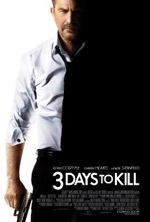
Starring: Kevin Costner
February 2014
This review was originally tweeted in Real-time from the back row of a movie theater and appears @BackRoweReviews. Though efforts were made to tease rather than ruin this movie’s memorable lines and moments, some spoilers may exist in the following evaluation. The original tweets appear in black, while follow-up comments appear in red. For concerns over objectionable content, please first refer to one of the many parental movie guide websites. All ratings are based on a four star system. Happy reading!

The dollar sign is on the wrong side of the numeral…long day at the movies.
Why are albinos always bad guys, a la #ThePretender?
The opening attack is pretty standard action movie fare…would’ve been nice to see a more elaborate scenario with edgier filming. And since Luc Besson is the co-writer, you’d almost expect that degree of punch and panache from the movie’s action sequences.
Costner is admonished to put his affairs in order.
A phrase no one ever wants to hear.
“Yellow is not a man’s color.”
Neither is purple, as he’s soon to find out.
Costner rides a purple bike through Paris.
“Kill or die,” says the comely woman in the hot sports car.
Well, when she puts it like that…
Costner ties up a bad guy with the handy man’s secret weapon. Reference #TheRedGreenShow.
You’ll be amazed at the myriad things you can create with the stuff.
“The spare’s loose in the trunk.” Funny scene.
Funny, but farcical. A spare tire can’t move on its own inside a parked car…unless we’ve unknowingly drifted into a horror movie.
Bike riding lessons...a sweet scene.
With a gorgeous vantage of the city in the background.
“Real football.” I love it.
Guido’s secret sauce...hilarious scene.
The funniest scene in the movie, but the trailer absolutely ruined it.
More lessons...dancing this time.
But the mom’s (Connie Nielsen) entrance at that particular moment, arranged for maximum emotional effect, is more than a little contrived.
Costner really knows how to crash a party.
Fitting, I suppose, since he was a bodyguard in a former (acting) life.
Final analysis: a unique blend of action and humor in this job vs. family themed film.
Some beautiful European locales along with a few Bourne-esque action sequences are a boon to the film.
Rating: 3 out of 4 stars. Another solid turn by Costner and McG’s finest directorial effort to date.
Despite its thematic tensions, something about this movie just works. It’s a serious movie about serious matters that doesn’t take itself too seriously. Thank goodness for small miracles. If played straight, the movie would’ve imploded since it falls far short of the quality seen in a Bourne or Bond Euro flavored action thriller. The film explores the lighter side of a genre where life and death stakes normally belie any modicum of levity. Tonally, the movie falls somewhere between Bourne and Red—a sizable dramatic chasm, to be sure. Some will, wrongly, view the film as a spoof, while others will be thrown by how it tries to wear two hats (or masks)—the light and the dark (reference the movie poster), the comedic and the dramatic. Such tonal shifts didn’t bother me because Costner is utterly convincing as a man with literally nothing to lose (except for the respect and admiration of his family) and because he navigates back and forth between the narrative poles with masterful ease. I can see where viewers expecting an all-out action film will be disappointed by the movie’s comedic bits and schmaltzy daddy/daughter scenes; the atypical blend of story elements will surely attract some viewers while repelling others, as any work of art will do when pushing the envelope. To me, the movie’s uniqueness is what sets it apart from a standard action picture and makes it an enjoyable entertainment. But if you disagree with my assessment, please don’t kill the messenger.
Muppets Most Wanted (PG)

Starring: Ricky Gervais
March 2014
This review was originally tweeted in Real-time from the back row of a movie theater and appears @BackRoweReviews. Though efforts were made to tease rather than ruin this movie’s memorable lines and moments, some spoilers may exist in the following evaluation. The original tweets appear in black, while follow-up comments appear in red. For concerns over objectionable content, please first refer to one of the many parental movie guide websites. All ratings are based on a four star system. Happy reading!

Guess I should show more respect for the little green guy. After all, he has a star on the Hollywood Walk of Fame. I know ‘cause I’ve seen it.
Really amusing Monsters University short.
Clever opening number about sequels. Did anyone catch The Seventh Seal reference?
One of the lines suggests that this is the seventh film since the original movie. My higher math tells me that there are now eight films in the Muppets series. Certainly a respectable franchise, although it has a long way to go to catch up to James Bond.
Badguy proposes a world tour. What could possibly go wrong?
“Drum solo!” Animal is a crackup.
Don’t worry; he eventually gets his solo…which lasts two hours. Thank God for editing.
Christophe Waltz dances the waltz. Doesn’t get any more tongue-in-cheek than that.
Correction: No “e” in Christoph.
Kermit receives a spork crown at the gulag.
Some people wait their whole lives for such an honor.
Liotta and Trejo doing dance moves is a bigger gas than Chris Cooper doing rap in the last film.
Kermit must direct a prison review or be stuck to “the wall.”
The prison ballet scene is just plain wrong.
These Cabbage Patch Muppets are creepy looking.
They look like Chucky’s illegitimate children.
Piggy sees double at her wedding.
The doppelgänger subplot is older than dirt, but keeps finding its way into movies.
Final analysis: just what you’d expect from a Muppets movie...lots of gags, pratfalls and inside jokes.
With puns and one-liners to spare.
Rating: 2 1/2 out of 4 stars. Not as heartfelt as the previous film, but just as entertaining.
The previous film in the series, The Muppets (2011), was a valentine to the fans and franchise. The movie was delivered with undeniable reverence and passion by co-star/co-writer Jason Segel (TVs How I Met Your Mother), who is a lifelong Muppet lover. The new Muppet introduced in that movie, Walter, was clearly envisioned as a Muppet version of Segel’s younger fan boy self. Though Walter also appears in this film, his involvement is in more of an ancillary capacity. Even though it’s just as amusing, this movie isn’t as from-the-heart as its predecessor. But that isn’t to say it’s without entertainment value. Fey, Gervais, Ty Burrell and a slew of high caliber performers in cameos infuse the movie with sufficient star power and the laughs keep coming at a steady clip throughout the movie. The Spartacus inspired scene near the end of the movie, where all of the Muppets offer themselves up for imprisonment so that they won’t be separated from Kermit, is definitely an emotional high point. All in all, this movie is diverting, family friendly fare that should fill the bill if this is the kind of entertainment you’re in the mood for. In the end, Muppets Most Wanted is exactly what you’d expect it to be. And in this instance, that’s not such a bad thing.
RoboCop (PG-13)
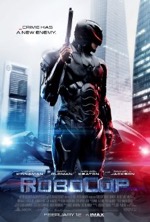
Starring: Joel Kinnaman
February 2014
This review was originally tweeted in Real-time from the back row of a movie theater and appears @BackRoweReviews. Though efforts were made to tease rather than ruin this movie’s memorable lines and moments, some spoilers may exist in the following evaluation. The original tweets appear in black, while follow-up comments appear in red. For concerns over objectionable content, please first refer to one of the many parental movie guide websites. All ratings are based on a four star system. Happy reading!

Cylons patrolling the streets in Tehran. Peace through superior firepower.
An ironic, and in this instance fitting, quote from ST:TNG’s “The Arsenal of Freedom.”
Do the robots factor in collateral damage?
Robophobia. Ha!
“What do these machines feel?”
Robo’s first step...gotta’ love those mechanical servo sounds.
There’s a metal man in my rice paddy.
The pumping lungs are pretty well unsettling.
For some reason this scene is far more disturbing than the myriad people blown to bits in the movie.
Old Batman and new Commissioner Gordon argue over Robo’s effectiveness.
Cylons vs. Tin Man...who will win?
“The illusion of free will.” Hmm...
If there’s any complexity to the story, this is it. An interesting argument when applied to media’s power over the consumer.
Maybe they should’ve uploaded the criminal database after the media circus.
Reconstruction of the accident sequence is awesome.
Warehouse shooting is like a video game.
Which is already on its way to your local game store, I’m sure.
“Bad cop, RoboCop.”
Getting a bit cutesy now.
Robo vs. the AT-STs. A flurry of bullets.
You just knew this scene was coming. It’s a smoother sequence with CGI, but there’s something charming about the old, clunky stop motion FX in the original.
Final analysis: far better than I expected for a remake. Appropriately updates the story.
Oldman holds the whole thing together and Jackson’s opinion TV show is entertaining and topical.
If not heavy-handed in the way it lampoons a particular political slant.
Rating: 2 1/2 out of 4 stars. Has some heart and a decent plot, but something’s missing here.
This is a valiant attempt at updating the 80s classic with modern technology and trappings, but it’s ultimately an effort that falls flat. Hollywood has always been sequel happy, but was remaking Robocop (1987), which hasn’t aged very well, a solid choice for a sequel? Aside from the nostalgia factor, is this story even that compelling? The movie reveals acts of terror abroad and at home and I suppose it’s cathartic to see a good guy with the power to defeat evildoers, but a superhero movie could’ve just as easily fulfilled such a need. Is this premise too silly for the more sophisticated modern viewer? Everything in its time I suppose, but hasn’t Robocop’s time already passed? Box office returns will reveal all.
The Wolf of Wall Street (R)
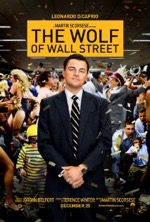
Starring: Leonardo DiCaprio
December 2013
This review was originally tweeted in Real-time from the back row of a movie theater and appears @BackRoweReviews. Though efforts were made to tease rather than ruin this movie’s memorable lines and moments, some spoilers may exist in the following evaluation. The original tweets appear in black, while follow-up comments appear in red. For concerns over objectionable content, please first refer to one of the many parental movie guide websites. All ratings are based on a four star system. Happy reading!

DiCaprio’s internal monologue becomes a direct address to the camera. Interesting narration method.
American Hustle, a concurrent release, also features an unusual mode of narration.
McConaughey’s chest thumping is truly bizarre.
And his protruding buck teeth only add to the strangeness of the scene.
DiCaprio gives a clinic on how to sell stocks.
Jaws go slack all over the call center.
Hill’s “present” sets DiCaprio on a bad course.
New company with a new script.
Wages increase while inhibitions decrease.
Robin Leach’s extravagant description of the yacht is amusing.
“Pick up the phone and start dialing.” DiCaprio’s rousing speech verges on the manic.
No verge about it…he falls over the cliff.
DiCaprio and Kyle Chandler’s amiable showdown on the yacht is amusing.
The Cerebral Palsy Phase. Funny stuff.
DiCaprio decides not to be sold to and creates an army of chest-thumpers.
Not to worry, they’ll all be making cameos in the next Planet of the Apes Movie.
Somehow the story just morphed from Wall Street into The Perfect Storm.
A very bizarre narrative left turn.
Chandler delivers a yellow “go to jail” card.
Final analysis: an overlong tale of greed, sex and drugs with an unrelenting blitzkrieg of F bombs.
Slick direction by Scorsese and fabulous acting all around.
Owes a debt to Wall Street and The Boiler Room, but pushes the boundaries of excess to the extreme.
Rating: 2 1/2 out of 4 stars for being derivative & excessive. Now I need Benihana & a mind cleanse.
There’s a great divorce in my evaluation of this film—a giant chasm which makes reconciling both sides a quandary of epic proportions. On one side is Scorcese’s sumptuous direction, DiCaprio’s utterly captivating performance and top-notch work in every phase of the production. On the other side is the ostensibly hyper-real lifestyle of the characters which comes complete with lewd behaviors of every kind imaginable and pervasive drug use all being done at work, out in the open for everyone to see, enjoy and clap and cheer for. If you’re still under the assumption or misguided, idealistic hope that some things are still sacred in the world, give this film a watch and it will shatter any such notions. I think the disconnect for me is a matter of identification…the lifestyle placed on display in the film isn’t even remotely appealing to me so it’s hard for me to sympathize with any of the characters. As such, this get rich, live large philosophy holds no fascination for me. Despite its stellar production values, I just can’t endorse this film because its excesses detract from its entertainment value. In the final analysis, Scorcese’s wonderfully woven Wolf is merely a celebration of corruption and debauchery. Morally reprehensible from one set of credits to the other, this film is gratuitous to its own peril.
American Hustle (R)
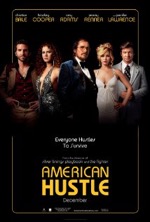
Starring: Christian Bale
December 2013
This review was originally tweeted in Real-time from the back row of a movie theater and appears @BackRoweReviews. Though efforts were made to tease rather than ruin this movie’s memorable lines and moments, some spoilers may exist in the following evaluation. The original tweets appear in black, while follow-up comments appear in red. For concerns over objectionable content, please first refer to one of the many parental movie guide websites. All ratings are based on a four star system. Happy reading!

How to do a comb over 101.
Apparently there’s an art to sliding a suitcase.
An art Cooper hasn’t mastered.
“We’re all conning ourselves.” Interesting philosophy.
Two lunches. Trouble brewing?
Four busts and they skate.
The new “science oven” doesn’t like metal.
Palpable antipathy between Adams and Lawrence. The opposite of a meet-cute. Classic!
The new player from Florida has a familiar bearing.
Something tells me you don’t wanna’ mess with this guy.
The ongoing ice fishing story is hilarious.
Cooper has listening problems…he’s always jumping to conclusions.
It’s all fun and games until someone gets hurt. Rough scene in Renner’s house.
Final analysis: a top-notch heist yarn with top shelf performances and peerless direction by Russell.
A wholly immersive film that cleverly employs filming techniques from the period it showcases.
Production values, especially costumes and hair styles, are staggeringly authentic.
Unique employment of the internal monologue from multiple characters.
And sometimes characters switch from talking (thinking) about themselves to talking about a different character.
Rating: 3 1/2 out of 4 stars. Should be a frontrunner for Oscar’s top prize.
Russell, Bale and Lawrence should be strong contenders as well. However, there’s an intangible missing ingredient here. Each aspect of the production is superb, but some ineffable quality eludes the proceedings. In the end, this is a handsomely mounted, highly styled heist film that has everything but heart. The absence of that crucial element might be its Achilles heel come awards season.
The Counselor (R)

Starring: Michael Fassbender
October 2013
This review was originally tweeted in Real-time from the back row of a movie theater and appears @BackRoweReviews. Though efforts were made to tease rather than ruin this movie’s memorable lines and moments, some spoilers may exist in the following evaluation. The original tweets appear in black, while follow-up comments appear in red. For concerns over objectionable content, please first refer to one of the many parental movie guide websites. All ratings are based on a four star system. Happy reading!

The graphic opening is tastefully and artistically shot.
24-karat conversation with the jeweler. Talk about multi-faceted.
#HaveYouBeenBad. There’s the line made popular by the trailer.
Pitt’s joke about why Jesus wasn’t born in Texas is hilarious.
A tad sacrilegious, but still very funny.
How did the cops catch up to the motorcycle if it was going 206 mph?
Desert Star Septic. “We pump it all!” Now that’s marketing at its finest.
Winston Rothschild, III (Jeff Lumby), a septic tank worker on the Canadian comedy The Red Green Show had the slogan: “We take the stink off your hands.” Just proves that toilet humor will never die.
What if another vehicle had happened by before the motorcycle arrived?
I only ask because this sort of plan never succeeded in the Roadrunner cartoons.
“Grief is worthless.” Deep philosophical terrain.
Pitt’s demise is gruesome.
Final analysis: immaculately filmed, well acted with a peerless script by Cormac McCarthy.
Who wrote the post-apocalyptic novel The Road, which became a motion picture in 2009 and starred Viggo Mortensen.
Should be renamed “Sex, drugs and cheetahs.”
Rating: 3 out of 4 stars. Adult themes abound accompanied by scathing commentary on human flaws.
This is a well acted/directed “immorality play” that reveals the dark underbelly of the drug trade along the Texas/Mexico border. Nothing really shocks here—we typically associate these behaviors, lifestyles and actions with those who manufacture, transport, buy and sell drugs. Crime doesn’t pay and the comeuppance received by the characters here is consistent with the truth of that universal maxim.
Machete Kills (R)

Starring: Danny Trejo
October 2013
This review was originally tweeted in Real-time from the back row of a movie theater and appears @BackRoweReviews. Though efforts were made to tease rather than ruin this movie’s memorable lines and moments, some spoilers may exist in the following evaluation. The original tweets appear in black, while follow-up comments appear in red. For concerns over objectionable content, please first refer to one of the many parental movie guide websites. All ratings are based on a four star system. Happy reading!

Spilled is probably a better usage of the word.
70s style “prevue” is a hoot.
Three different armies in as many minutes. The bloodbath begins.
This initial bloodletting, which comes even before the first evidences of a plot have coalesced, clues us into the fact that everything else in the movie will take a back seat to the action sequences.
Mr. Machete Goes to Washington.
“Machete don’t smoke.” Ha!
Machete don’t tweet either. Fortunately I do.
However, these “Machete don’t ____” gags are getting tired at this point.
Helicopter homicide is disgusting.
And utterly unrealistic.
Mexican standoff in a Mexican restaurant ends with a bang.
OMG! Vergara’s body part weapons are...words fail.
Molecule blaster is gross, but humorous.
The Star Wars and Star Trek allusions are becoming intolerable.
The ending gets extremely gimmicky and borrows heavily from a plethora of genre movies.
Final analysis: bloodier and more outlandish than the original, if possible.
Rating: 2 1/2 out of 4 stars. Will this film earn enough money to justify the promised sequel? Voz knows.
This movie is a profound disappointment. The first film was also a bloodbath, but it was amusing and had more than its share of heartfelt chuckles. Here, the laughs are strained and far too many of them are accompanied by eye rolls. Rodriguez’ first Machete (2010) allowed us to experience the lighter side of a splatter-fest; the slayings were so elaborate, so frequent and so graphic that they bordered on the comedic. In this sequel, far too many of the action scenes are gross or gratuitous and lack the degree of levity that made the first film such a guilty pleasure. As for the supporting players, Sofia Vergara is way over-the-top and Mel Gibson’s villainous Voz is just strange—even by Mel’s standards. Hopefully Rodriguez will right the ship for Machete Kills Again.
Prisoners (R)
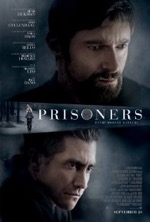
Starring: Hugh Jackman
September 2013
This review was originally tweeted in Real-time from the back row of a movie theater and appears @BackRoweReviews. Though efforts were made to tease rather than ruin this movie’s memorable lines and moments, some spoilers may exist in the following evaluation. The original tweets appear in black, while follow-up comments appear in red. For concerns over objectionable content, please first refer to one of the many parental movie guide websites. All ratings are based on a four star system. Happy reading!

Be prepared...Jackman’s diatribe on survival is advisable but extreme. A harbinger of things to come?
Using the Chinese zodiac as a pick up line. A valiant attempt.
Wait, is this an inside joke? Jake Gyllenhaal also starred in Zodiac (2007).
Dano wraps his RV around a tree. The mystery deepens.
Instead of searching the forest shouldn’t they be canvassing the neighborhood?
Oops…spoke too soon. I just hate it when stories have to catch up to me.
A basement without stairs. You couldn’t pay me enough.
Don’t ignore the necklace on the stiff.
Dano made a big mistake in angering the Wolverine.
Jackman goes Jack Bauer on Dano. Brutal scene.
Definitely not for the faint of heart. This whole subplot has a tragic The Ox-Bow Incident (1943) quality to it.
Creeper at the wake. Are we dealing with a cult?
Creeper in the house.
Jake’s shirt is always buttoned up...hiding a necklace?
Creeper’s house has curious wall designs.
“The war we wage with God.” Frightening!
There are some real sickos out there.
As we learned in Titanic, never underestimate the power of a whistle.
Final analysis: moody atmosphere is palpable from the start. Taut yarn that’s accompanied by fine performances.
The ending could’ve gone a couple different ways, but I’m okay with the resolution they chose.
Perhaps a bit too leisurely in its pacing, but is engaging from start to finish.
Does an excellent job of challenging our notion of what constitutes a monster.
Rating: 3 out of 4 stars. A psychological thriller more than a physical one, but it will stand the test of time.
This is a very intelligent and emotionally supercharged thriller. It’s so good, in fact, that it was exceedingly difficult to keep from spoiling several of the story’s main plot points, which I managed to do anyway in certain instances. Amusingly, one of my “spoilers” is an unintentional red herring, so don’t always believe what you read. Some of the torture scenes are not recommended for those with a weak stomach. However, if you made it through 24 okay, you should be fine here.
Kick-Ass 2 (R)

Starring: Aaron Taylor-Johnson
August 2013
This review was originally tweeted in Real-time from the back row of a movie theater and appears @BackRoweReviews. Though efforts were made to tease rather than ruin this movie’s memorable lines and moments, some spoilers may exist in the following evaluation. The original tweets appear in black, while follow-up comments appear in red. For concerns over objectionable content, please first refer to one of the many parental movie guide websites. All ratings are based on a four star system. Happy reading!

Shooting her friend in the back. With friends like her...
Absent for her perfect attendance award.
Dr. Gravity to the rescue.
This is one funny sequence. You just never know when some random vigilante will appear to save your butt in this comic book world. Apparently there’s no such thing as deus ex machina in this world either.
“You’re gonna need a bigger jar.” NK. Especially with her potty mouth.
These wanna-be superheroes remind me of the misfits in Mystery Men.
The 1999 comedy is highly recommended for those who, like me, have a warped sense of humor.
Fight moves at dance team tryouts is a really nice sequence.
Or maybe it was cheerleader tryouts…I don’t remember. Don’t care either.
Will the “date ditch” impel Hit Girl into taking up her mantle again?
Starting to turn into Mean Girls. The puke taser is gross.
No description required.
Battle royale. Great protracted battle between Hit Girl and Mother Russia.
Final analysis: as brutal and crass as the first film, but still quite entertaining.
I still miss Nicolas Cage’s Big Daddy, though. Probably my all-time favorite role of his…which still isn’t saying much.
Rating: 2 1/2 out of 4 stars. Some good messages sandwiched between action scenes.
Compared to the first, controversial film, the sequel seems somewhat tame by comparison. With no origin story to give it context and structure, the sequel focuses on Mintz-Plasse’s 2.0 version villain and a gaggle of B and C tier “Superheroes/Super villains.” Not as clever or incisive as its forebear, this follow-up film makes a valiant attempt at superseding the first film, but in the end gets its butt kicked by the original.
Closed Circuit (R)

Starring: Eric Bana
August 2013
This review was originally tweeted in Real-time from the back row of a movie theater and appears @BackRoweReviews. Though efforts were made to tease rather than ruin this movie’s memorable lines and moments, some spoilers may exist in the following evaluation. The original tweets appear in black, while follow-up comments appear in red. For concerns over objectionable content, please first refer to one of the many parental movie guide websites. All ratings are based on a four star system. Happy reading!

Steven Knight.
Multi-camera opening reminds me of a Person of Interest episode.
“Fair and transparent.” Broadbent certainly isn’t referring to the US justice system.
Judge lays out the rules for the case...the relational ticking time bomb is set.
42191. The mystery deepens.
Cross-cutting between both sides of the investigation keeps the plot rolling along.
Broadbent warns Bana not to stray. A taut exchange.
The plot reveals its hand at this point though…Knight should’ve worked a little harder to shroud the purpose and function of this antagonist.
“Thou shalt not communicate” commandment is broken. Ramifications could be far-reaching.
Howe grills Witness X. Wow!
Hell hath no fury…and boy does she unleash it.
New plan...get him to the court on time.
They skip the whopper of a topper though.
Breakfast with Broadbent. “Let it go.”
Also Henry’s advice to his son in Indiana Jones and the Last Crusade (1989).
Final analysis: a decent spy yarn infused with the appropriate degree of paranoia.
Features fine performances all around and boasts deft direction.
By John Crowley.
Rating: 2 1/2 out of 4 stars. Non-thrilling Thriller sputters down the runway but never quite takes off.
The abilities of some truly fine actors were squandered here. The story isn’t very gripping from the outset and never really goes anywhere…well, nowhere exciting anyway. Cut from the same narrative cloth as Tinker Tailor Soldier Spy (2011), this film is a slow boil political yarn that fails to deliver the major climax we anticipate. And how many times must Bana be told to back off the case before he gets it…or gets it? Long after the audience is bored to tears, I suspect.
R.I.P.D. (PG-13)
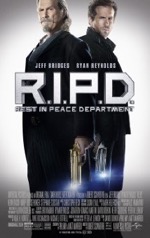
Starring: Ryan Reynolds
July 2013
This review was originally tweeted in Real-time from the back row of a movie theater and appears @BackRoweReviews. Though efforts were made to tease rather than ruin this movie’s memorable lines and moments, some spoilers may exist in the following evaluation. The original tweets appear in black, while follow-up comments appear in red. For concerns over objectionable content, please first refer to one of the many parental movie guide websites. All ratings are based on a four star system. Happy reading!

Reynolds is double-crossed by his A-list partner.
Mary Louise Parker as St. Peter? She’s in two new releases this week...impressive.
Parker also appears in Red 2.
Indian food sure does bring out the monster in some people.
Reynolds’ old partner can traverse realities? Color me interested.
Eternal affairs...clever.
A singularity forming over a city...didn’t we see this in last summer’s The Avengers?
“She billygoated me.” Eww!
Final analysis: a unique concept that isn’t exploited to maximum effect.
In fact, the premise is dumbed down for maximum commercial appeal.
Thematically and conceptually similar to the Men in Black films.
Bridges steals the show as the Custer-esque, chaw-mouthed veteran who shows Reynolds the ropes. A truly unique role.
The way he sits sidesaddle in the patrol car is a nice character touch.
Rating: 2 1/2 out of 4 stars. A sequel is almost certainly assured.
I remember laughing out loud when seeing the trailer for this film, thinking “now here’s a clever conceit.” The germ of that conceit—the premise—is the only part of the film that works. As with most Hollywood productions today, it’s poor execution and cursory character development that render this movie a pale reflection of what it could’ve been in more skillful and creative hands. And, also like too many Hollywood films today, R.I.P.D. is far too vulgar and vapid for its own good. Though Universal Studios will work hard to find a way to resurrect this sad effort into a sequel, this DOA plot should be left six feet under. RIP R.I.P.D.
Red 2 (PG-13)
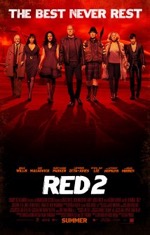
Starring: Bruce Willis
July 2013
This review was originally tweeted in Real-time from the back row of a movie theater and appears @BackRoweReviews. Though efforts were made to tease rather than ruin this movie’s memorable lines and moments, some spoilers may exist in the following evaluation. The original tweets appear in black, while follow-up comments appear in red. For concerns over objectionable content, please first refer to one of the many parental movie guide websites. All ratings are based on a four star system. Happy reading!

Is Malcovich playing possum...again?
Beware Pringles in a shoot out.
Death by origami...not pretty.
Don’t look the Frog in the eye.
Especially if it’s a hypnotoad.
The un-torture scene is uproariously funny.
“I knew she’d play him like a banjo at an Ozark hoedown.” Ha!
I didn’t find Malcovich’s character all that funny in the first film, but virtually every line he delivers in the sequel is side-splitter.
It goes without saying, but Hopkins is fantastic.
The scene where he stages his own breakout is nothing short of brilliant.
Red mercury...is that the predecessor to Trek’s red matter?
Final analysis: a rip-roaring good time. At least as good as the first, perhaps a bit better.
Rating: 2 1/2 out of 4 stars. Great action with plenty of laughs. Not a bad way to spend two hours.
Just seeing all of these A-list stars hamming it up together on the big screen is worth the price of admission, but the movie also boasts a serviceable plot populated with snappy dialog and some heart-stopping action sequences. Here’s hoping Red 3 advances the spy spoof series with the same degree of wild and witty action showcased in the first two Red films.
Despicable Me 2 (PG)
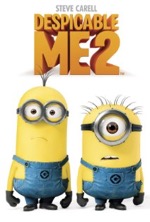
Starring: Steve Carell
July 2013
This review was originally tweeted in Real-time from the back row of a movie theater and appears @BackRoweReviews. Though efforts were made to tease rather than ruin this movie’s memorable lines and moments, some spoilers may exist in the following evaluation. The original tweets appear in black, while follow-up comments appear in red. For concerns over objectionable content, please first refer to one of the many parental movie guide websites. All ratings are based on a four star system. Happy reading!

Horseshoe-shaped super magnet appears in the Arctic. A slick sci-fi teaser.
In a jam, Gru considers a new profession.
But before he can make that decision, he lands in a sticky situation. C’mon, that’s better than half the lines in the movie.
The last thing I wanted to see in this family film was a minion in the buff. Eww.
Bad date leads to a better prospect.
Chip hat...fashionable and delectable.
But how often do you need to purchase a new one?
Shouldn’t the mutant minions be able to chew through the cages?
A bit of a spoiler, but a question that exposes this contrived plot point.
Minion mock music videos are exceedingly silly.
But it made the kids laugh, so mission accomplished I suppose.
Final analysis: too many pratfalls by minions and too shallow a plot to be fully enjoyed.
All of the best scenes were spoiled in the trailer.
Too much time was spent in the mall, which is a hackneyed locus for action.
Rating: 2 out of 4 stars. Unremarkable sequel lacks the heart of the original. A Gru-some experience.
With the runaway success of the first film, it was a foregone conclusion that a Despicable sequel would ensue. That effort ended up being pretty safe by trying to turn former super villain Gru into a nice guy (which is far less compelling), adding a possible love interest for Gru (contrived and mushy for a kiddy pic) and amping up the minion mischief (a gimmick to garner more laughs from the target audience). Those preteen spectators won’t notice the decline in story quality, but everyone else in the audience will chalk this one up as mildly disappointing. And annoying: bee-doh, bee-doh, bee-doh…
The East (PG-13)

Starring: Brit Marling
June 2013
This review was originally tweeted in Real-time from the back row of a movie theater and appears @BackRoweReviews. Though efforts were made to tease rather than ruin this movie’s memorable lines and moments, some spoilers may exist in the following evaluation. The original tweets appear in black, while follow-up comments appear in red. For concerns over objectionable content, please first refer to one of the many parental movie guide websites. All ratings are based on a four star system. Happy reading!

Now that we’re pulling up the stakes on many summer tentpoles, it’s time for some different fare.
Meatier fare, thank goodness.
I’ve always loved Page’s delivery and Marling was fabulous in the deeply-affecting #AnotherEarth.
A trippy, gut-wrenching film that will have you noodling for days.
Prepare to get your spy on.
After that harrowing opening narration, the movie definitely has my attention.
Marling picks a bad time to become a hobo.
This application of super glue actually works...I’ve had occasion to use it in the past.
Learned it from a master meat cutter when I was apprenticing under him in a former life. Seals the cut and heals remarkably fast.
Wearing a straight jacket to dinner...interesting attire.
Clever place to hide a cell phone.
A deadly toast...a taste of their own medicine.
Spin the bottle...enjoyed at frat parties and cult gatherings everywhere.
When a thought comes, it comes. Don’t know that I’ll ever be able to outdo this one.
Jason Ritter’s character here is virtually identical to the one he plays on #Parenthood. Does he have any range?
Group washing in the lake...weird.
Page confronts her dad...the same actor who plays the VP in #Homeland.
Actor Jamey Sheridan.
The last jam strikes close to home.
The trash apple scene is unsettling, but is it an act?
Final analysis: a thought-provoking yarn that grapples with the nature of justice.
Should corporations be held responsible for the ecological disasters they create?
Rating: 3 out of 4 stars despite some ponderous pacing. Definitely a water cooler discussion film.
The movie has an undeniable independent feel to it, but has a surprising raft of A-list talent in its cast. There are disturbing scenes here and some challenging ones as well. The movie broaches some important questions, like: which is worse, a corporation that makes millions by ravaging our environment or homegrown terror cells bent on bringing down such companies? The film isn’t exactly popcorn entertainment, but it’s an effective counterpoint to the increasingly vapid and vulgar offerings at the Cineplex.
Now You See Me (PG-13)
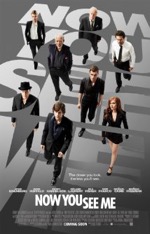
Starring: Jesse Eisenberg
May 2013
This review was originally tweeted in Real-time from the back row of a movie theater and appears @BackRoweReviews. Though efforts were made to tease rather than ruin this movie’s memorable lines and moments, some spoilers may exist in the following evaluation. The original tweets appear in black, while follow-up comments appear in red. For concerns over objectionable content, please first refer to one of the many parental movie guide websites. All ratings are based on a four star system. Happy reading!

Receiving tarot cards from a hooded mystery man is never a good thing.
I thought teleportation was only possible in Star Trek.
First rule of magic. Don’t drink Diet Pepsi with something that rattles inside.
Also the first rule of common sense.
Great to see Michael Caine and Morgan Freeman together again.
Unbelievably, for the first time ever in a scene together. Although, both men appeared in Nolan’s Batman trilogy, their characters never crossed paths.
Rob the rich and give to the poor. Robin Hood would be proud.
Ruffalo tracks himself. Maybe he’ll find a better personality.
Unless you’re Gambit, thrown cards can’t do much damage.
Is the high speed chase just another misdirection?
Or just a stunt to infuse more action into the movie?
Awesome holographic projections at Five Points.
Resolution: Love trumps magic.
If it sounds oversimplified…it is.
Final analysis: Too slick for its own good. The trick was on me for shelling out a ten spot on this movie.
Harrelson and Eisenberg were phenomenal in Zombieland, but so-so here.
Rating: 2 out of 4 stars for shallow character development and a plot that was merely a house of cards.
The movie had some decent moments and solid acting from its diverse and decorated cast, but it failed to deliver the sensational “ah-ha!” it promised from the outset. If you’re looking for a better magic movie check out The Illusionist (2006) and if you want a hipper heist flick Ocean’s Eleven (2001) should be your ticket.
Taken 2 (PG-13)
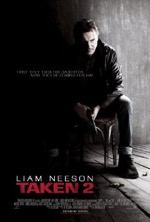
Starring: Liam Neeson
October 2012
The follow-up to the successful thriller Taken (2008), Taken 2 is leaner, meaner and doubles the number of kidnappings. This time around it’s a family affair as Liam Neeson, Famke Jansen and Maggie Grace, while vacationing in Istanbul, are targeted by Albanian thugs with a grudge against Neeson for his former transgressions against their family. Grace’s Kim was the one taken in the last film, but she evades capture this time, thanks in large part to a major assist from dad. Turning the tables, Neeson’s Bryan and Jansen’s Lenore are abducted by the avenging Albanians.
Admittedly, the formula is very much the same here as in the first film: foreign locale, high speed chases, high body count, etc. Other similarities to the earlier movie are flaccid character development and plot holes so large that even Kim can parallel park inside of them: case in point, Kim goes from twice failing her drivers test to zipping through the narrow, teeming streets in Istanbul as if she’s the second coming of Jason Bourne. Besides the utter silliness of the chase scene, doesn’t Kim look a little old for a high school student? Perhaps she was held back a few years. Oh, and how many times must Bryan admonish Kim to speed up, go faster, etc (you can create a drinking game with such repetitions) before she finally follows her dad’s instructions?
With a running time of ninety-two minutes this second Taken installment is definitely lean, which is a good thing since a longer film would’ve made it even more obvious just how little story there is here. The plot’s breakneck pace further distracts the audience from realizing they’re viewing a ridiculously simple through line, heavy on action and nearly devoid of any character complexity. On the upside, the movie doesn’t overstay its welcome. On the downside, the “climactic” showdown between Bryan and the aggrieved father from Albania is akin to air escaping a balloon…the very definition of anti-climactic. We’re waiting for a rejoinder, another bigger, cooler battle like we’re used to seeing in the standard action picture. Taken 2 is the exception to that rule—the bad guys are finished off, the frazzled family is reunited and the movie ends…but not before Kim passes her driving test to the downpour of warm fuzzies. The film feels rushed and could actually use and additional ten to fifteen minutes of story; a panacea I prescribe for very, very few films.
In the end, Taken 2 is no better or worse than its predecessor and extends the series without necessarily advancing it. Still, if popcorn entertainment is the order of the day, it’s hard to go wrong with Taken 2. Some will enjoy the film for the pulse-pounding romp that it is while others will feel like they’ve been taken for a ride.
Rating: 2 1/2
The Dark Knight Rises (PG-13)

Starring: Christian Bale
July 2012
So how do you improve upon a film that was a global phenomenon (one billion worldwide gross) and also featured the unforgettable, posthumous Academy Award winning performance by Heath Ledger as the maniacal Joker? Though a daunting question to grapple with, the obvious answer is that you take the sequel in a different direction. Director Christopher Nolan certainly achieved that in his darker, grittier trilogy capper, but did he choose the right direction?
The movie opens with a spectacular midair heist that introduces us to the movie’s formidable villain, Bane (Tom Hardy). A robbery at the Wayne Manor establishes the other villain/wildcard in the movie, Anne Hathaway’s Catwoman. Bruce Wayne (Christian Bale), a battered shell of his former self, is on hiatus from his jaunting about as Batman and is set to be voted off the board of his own company due to bad business decisions. To make matters worse, Wayne’s longstanding, long-suffering butler, Alfred (Michael Caine), leaves the Wayne Manor over a dispute with Wayne. With the death of Rachel Dawes (Maggie Gylenhaal) in the previous film, Wayne now has little, if anything, to hold onto. And all of this occurs before the action with Bane kicks into high gear.
Kicking the hero while he’s down is okay as long as he eventually emerges as the hero we know and love. That Batman, however, never makes an appearance in this film. You’d think that with the word rises in the title, Batman would overcome his mental and physical infirmities and avenge himself upon Bane, but his role in the film’s resolution is anything but triumphant. One of the points frequently stressed in the movie is that Bruce Wayne/Batman can’t do it all by himself, but it would be nice if he did something…other than get his butt kicked in every melee he’s a part of in the movie. As such, though brimming with gritty realism, the film gives us little to cheer about or for. By movie’s end, the whole sordid affair amounts to little more than a bleak exercise in anarchy.
As for Batman’s fighting style in the film…it’s annoying. He’s out of control and impatient, forcing punches in a berserker style that should be Bane’s method of attack. Did Batman forget all of his training? If anything, shouldn’t Batman, as an experienced fighter, be the more restrained and patient of the two combatants and use Bane’s bulk and momentum against him?
I repent of ever criticizing Batman’s (Bale’s) hushed and throaty speech, because Bane’s muffled and mechanized vocalizations are exceedingly difficult to decipher at times. I’m not sure I’m sold on Nolan’s take on Bane. I much prefer the Bane from the Venom storyline in the Batman comic books. True, Bane is more compelling if he isn’t under the influence of an illicit substance, but the Venom-enhanced Bane is far more frightening since there’s just no reasoning with him. Although I’m certainly not advocating a return to the goofy sidekick caricature of the character in Batman & Robin (1997), a Venom-infused Bane, if handled properly, is one of the most formidable and ferocious members of Batman’s rogues gallery. Plus, by introducing Venom into the Bane storyline, how awesome would it be if Wayne also got hooked on the juice like he did in the comic, unleashing a more savage side of the Caped Crusader? The Venom storyline would seem to be tailor-made for a story about a physically battered Batman in desperate need of a physical edge against an imposing, seemingly impervious adversary.
The film has some severe highs and lows, both thematically and critically. Fittingly, the movie’s high point is when Wayne gains the courage to leave the hellish gulag by ascending the jagged walls of an ostensibly bottomless well. The sequence works on different levels: symbolically (Wayne literally rising above past fears, mistakes, etc.) and personally (as the film prefigures, Wayne must find the anger, focus and motivation to return him to his former status, if not physical condition, as Gotham’s protector).
Another aspect that works well here is Nolan and cinematographer Wally Pfister’s sweeping city shots, which are some of the finest in Nolan’s Batman trilogy. The city shots featuring pyrotechnics are utterly mesmerizing, especially the double bridge explosion. The most exciting visual in the film is at the Gotham Knights football game when, during a kickoff, a sprinting player stays one step ahead of the collapsing field which falls away in sections behind him. Though only consuming a few seconds of screen time, it’s a gorgeous yet gut-wrenching visual.
Of course, bridges exploding and sections of the city crumbling beneath the surface are rife with 9-11 imagery. Just as he did in the previous Batman films, Nolan taps into lingering anxieties over 9-11 by showing a city being ripped apart at the seams by a terrorist. As such, the film’s most obvious 9-11 allusion is Bane himself—a self-styled, self-righteous terrorist with misguided populist notions of an ideal society operating under his jackboot. Bane sees himself as a type of Robin Hood, an avenger for the people (who’s ultimately in it for himself). Bane’s men stealing Wayne’s Bat-Tanks and unleashing them on the city to wreak havoc echoes the way terrorists used our own technology against us on that fateful day in 2001. Besides blowing things up, Bane’s mission also includes bringing corrupt political leaders, tycoons, etc to justice for their decadent lifestyles. By using his antagonist as a type of avatar, Nolan exposes corporate greed and political pork by borrowing from real life headlines ranging from the Enron scandal to the financial fleecing by the city council in Bell, CA.
Getting back to the Bat-Tanks, wouldn’t engineer Lucius Fox (Morgan Freeman) have built in an optical scanner failsafe so that only Batman could use them (with thanks to my sister for pointing this out)? Other than the Bat-Tanks, the newest toy in this movie, not to be outdone by the more heavily armored Batmobile in the previous film, is the envy inducing Bat-Bike. The way the Bat-Bike takes corners, it’s round front tire somewhat reminiscent of the swiveling ball on a Dyson vacuum, is another of the film’s visual delights…it really must be seen to be fully appreciated.
I have neither the energy nor the inclination to detail an exhaustive list of the movie’s inconsistencies or gaps in logic, but one sequence in particular is addled with numerous errors. After being convicted in Bane’s kangaroo court, Commissioner Gordon is sent out onto a river covered in thin ice. Three problems here: when Batman shows up, he’s standing right where others have already fallen through the ice. With the added weight of his suit and all of its various equipment, gadgets and weapons, wouldn’t Batman be in serious danger of falling through the cracking ice? Next, Batman lights a flare and throws it down onto that same cracking ice. Is this a good idea?
Worst of all, the flare ignites a trail of gunpowder which begins on the ice and ends up lighting up a makeshift Bat Symbol high atop a distant skyscraper. Did Batman arrange this gimmick all by himself? How long did it take him to lay that trail of gunpowder and wax artistic on the side of the building? Wouldn’t that time have been put to better use by rescuing Gordon and foiling Bane’s plans?
This flawed scene is a microcosm of the film’s lazy lapses of logic, but it’s not just story elements that miss the bull’s-eye. Everything, from the dialog to the pacing to the action scenes, just feels “off” here. Whereas the previous film was a flawless sensation, this third Batman installment is riddled with incongruent story devices and plot holes large enough to drive a Bat-Tank through with room to spare. Much like Wayne and the city he protects, the story here seems battered, fractured and beleaguered. In that regard, the narrative’s reflection of Wayne’s psyche is brilliant, but does it necessarily make for an enjoyable entertainment?
It’s hard to say if Nolan’s intention was to trigger a cathartic release in the audience over Bane’s avenging mission against corporate and political corruption, but it’s safe to say that there’s no way he could’ve predicted the film’s potential to produce anarchy in real life. I speak, of course, of the incident at the theater in Aurora, Colorado, where a young man, decked out in Bane garb, killed and wounded several patrons in a wanton slaughter. The shooting has tainted the film in profound and palpable ways—it’s not just an entertainment anymore, it’s a heinous headline. Ironically, the film’s message that evil is real and rampant is starkly validated by this opening night massacre. When entertainment inspires actions in real life and tragedy ensues, it’s hard to know where the blame should be placed. One thing’s for sure, no matter how well the film performs; the theater shooting will always stand out as an unfortunate footnote to whatever the movie achieves financially, critically or artistically. However unintentional, the movie has created its own monster…life imitating art has seldom been as bitterly realized.
It’s hard to imagine a darker, more psychologically complex film than The Dark Knight, but Nolan has delved deeper into the sordid, corrupt and festering underbelly of Gotham while presenting us with a villain even more frightening (though not nearly as colorful) than the Joker. However, for all of its gritty realism, The Dark Knight Rises gives its audience absolutely nothing to cheer about. The movie is bleak for the sake of being bleak, and as such, is an extremely well-crafted, well-acted, well-written and well-directed movie that’s ultimately not enjoyable in the least. It’s entertaining but is nowhere close to being exhilarating. It’s hard to say where Nolan should’ve taken this film or even if a different plot would’ve produced a different result, but the direction he took is less than satisfactory, especially when one considers how well it was set up by The Dark Knight.
Perhaps that downer feeling comes from the knowledge that there’s no easy way to say goodbye to Bale, Caine, Freeman, Oldman and company. Perhaps the previous film set the bar impossibly high, bloating our expectations for a more triumphant capper to Nolan’s brilliantly dark trilogy. Perhaps the film with be looked upon more favorably as time passes? Perhaps the Dark Knight will rise again?
Rating: 3
21 Jump Street (R)
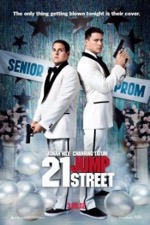
Starring: Jonah Hill
March 2012
Based on the 80s TV series of the same name starring a pre-Captain Jack Sparrow Johnny Depp, the new film version of 21 Jump Street revisits the “undercover cops go back to school to catch a bad guy” premise for the umpteenth time in film history. In the age of remakes, it was just a matter of time before this marginally successful TV property was exploited to its most ridiculous extents on the big screen. Just as nature abhors a vacuum, Hollywood hates leaving any potential revenue stream untapped.
The movie features Jonah Hill and Channing Tatum as two rookie detectives who’ve drawn the short straw and must go back to school; but hey, it actually beats their former assignment—security guards at a public park. The fish-out-of-water role reversal, where Tatum is now a bigot and bully and Hill is the life of the party, is amusing for about five minutes, but this plot device is severely belabored. Other than brief cameos by Depp and his partner, Dustin Nguyen (which is amusing for fans of the original show and confusing for those not familiar with the show), all we’re left with here is a new type of drug that’s running rampant through an inner-city high school and non-stop crass language and sexual (particularly homo-) references to fill out the story.
From the first bawdy joke over two dogs humping in the park to the climactic scene where a handcuffed man tries to retrieve his blown off phallus with his mouth, the movie is an unrelenting deluge of obscenities and indecencies of every variety imaginable…and plenty that were unimaginable before viewing this tawdry affair. The movie frequently crosses the line of bad taste and, as a default, settles for cheap laughs deriving from dunghill humor. But most of the laughing I heard in the theater was of the nervous variety as if those in the audience were looking at each other for approval…a silent “is it okay to laugh at this?” passing between them.
The real loss here is that this could’ve been a decent film had Hill and the other writers chosen a different tack. Hill and Tatum are skilled enough at both comedy and drama that some appropriate blend of the two genres could’ve made for an engaging story with occasional moments of humor punctuating episodes of hard-hitting drama. Just as the actor’s talents were wasted, so was my time and money. And I only paid two bucks…I feel sorry for the saps who paid full price for this morally reprehensible, wholly irredeemable affair.
I could go into more detail concerning the plot, what little of it there is, but I’d just be wasting your time with a potpourri of profanities and inanities. There have only been a handful of movies where, due to the subject matter or inappropriate dialog, I’ve felt like taking a shower after leaving the theater and this was definitely one of them. Clean up your act, Hollywood. Nobody’s laughing.
Rating: 1 1/2
J. Edgar (R)
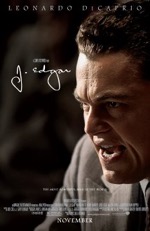
Starring: Leonardo DiCaprio
November 2011
What everyone will be talking about after seeing the Clint Eastwood helmed biopic, J. Edgar, is Leonardo DiCaprio’s performance as the title character…and why shouldn’t they? It’s a career defining turn by the actor who once stood on the bow of a ship and yelled “I’m the king of the world!” If he keeps turning in performances like this one, DiCaprio may someday own that very title.
A fascinating character study of the former FBI director during the 40s and 50s, J. Edgar is psychologically complex despite the character’s single-minded furor to rid our country of any trace of Communism. The central thesis of the film, as is conveyed in an opening narration by DiCaprio portraying a doting J. Edgar Hoover, is that “even great men can be corrupted.” J. Edgar spent his entire life and career ferreting out communists and other nefarious agents with an unholy zeal.
The bitter irony here is that J. Edgar himself was corrupted, not by the system, but by his own hubris and egomania. J. Edgar’s bloated view of himself is powerfully exposed near the end of the film by his good friend and assistant Clyde Tolson (Armie Hammer). The essence of Tolson’s scathing comments, if they are to be believed, rewrites some of the major events of the film effectively excluding J. Edgar from many of the story’s main events, which, of course, would make for a brief and dull movie.
Tolson gives his friend a reality check when recounting arrests that were made not by J. Edgar, as he claimed, but by other agents. Tolson’s frank assessment of his friend’s consistent self-aggrandizement stuns J. Edgar at first, but the moment of mental sobriety is short-lived and the FBI director is back to ridding the world of perceived evils. There’s something poignant here about how we see ourselves versus how others see us.
As portrayed in the film, J. Edgar was a grade-A narcissist who was in love with himself and his work, to the exclusion of anyone else. J. Edgar had mommy issues (his mother is played by the inimitable Maggie Smith) and eschewed heterosexual (Naomi Watts) and homosexual (Hammer) offers for companionship. There’s something to be said for the ardent adherence to an ideal, especially one that ensures domestic tranquility, but all extremes are dysfunctional and J. Edgar’s rigidity of behavior and thought alienated even the few people in his life who actually cared about him. Though addled by a different form of psychosis, J. Edgar was just as mentally ill as John Nash was in A Beautiful Mind (2001).
None of these broad stroke characterizations take anything away from the intricate nuance of DiCaprio’s performance and one wonders how much instruction the actor received from Eastwood, who is notorious for getting what he wants in the first take. It seems to me, and this is just a guess, that Eastwood was more hands-off than micromanaging with respect to the film’s performances. As an actor himself, Eastwood is an actor’s director, so it stands to reason that he would just roll the camera and trust his talent to deliver fine performances—which they do to a superlative degree here.
Eastwood’s direction might feel a little labored at times, but his method is actually an unqualified work of genius. Most of the shots, with a few notable exceptions, are done in the style of a classical Hollywood film. As such, Eastwood mirrors the filming techniques employed in the period he’s portraying—clever. Though difficult to defend, it’s also my belief that Eastwood’s conservative direction is the perfect parallel for the conservative politics displayed in the film. In a sense, Eastwood, whose career has been marked by decidedly conservative narratives or sentiments, was the perfect choice to helm this Oscar bait biographical period piece about such a fiercely conservative political figure from the not-too-distant past.
Though the production values are superb across the board, we hardly even notice the sets due to DiCaprio’s scenery-chewing performance. Indeed, there are moments when the actor so inhabits the character that we no longer see DiCaprio—only J. Edgar. This is especially true of his scenes as the older J. Edgar where his acting is genuinely convincing despite that fact that he’s buried under latex and make-up. Unfortunately, the same cannot be said of the make-up or performance by Hammer as Tolson. We often get the sense that Hammer is “playing” an old person rather than simply being an old person. In many instances that noticeable disparity pulls us out of the reality of the film. Granted, Hammer’s make-up isn’t as good as DiCaprio’s, but he’s decisively overmatched by DiCaprio and one wonders if a different casting choice would’ve served the story better.
J. Edgar might be a name frequently bandied about come awards season. Although a nod for Eastwood’s directing is uncertain at this time, DiCaprio seems to be a strong contender for Best Actor and might just walk away with the golden statuette. It’s anyone’s guess if the film will win Best Picture, but one thing’s for sure, come February, J. Edgar will be well acquainted with Oscar.
Rating: 3
Drive (R)
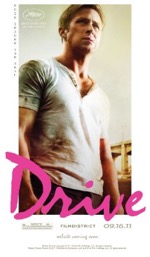
Starring: Ryan Gosling
September 2011
When I saw the trailer for Drive, I thought it was going to be another of those high-octane, lowbrow car race/chase movies in the mold of the Fast and Furious franchise. How wrong I was. Although centered on cars, specifically a silver Chevy Impala, Drive is more Shakespearian than Vin Dieselian (that didn’t quite roll like I wanted it to). There are plenty of scenes or elements in the movie that hearken back to earlier cinema staples involving a solitary man driving a car at night, the most obvious antecedent being Martin Scorsese’s Taxi Driver. Drive also borrows from a variety of styles/genres, including: films noir (Double Indemnity) and thrillers (Vertigo) in the way it anthropomorphizes the city as an ancillary character in the film with streets and highways representing veins and arteries.
As it turns out, the story more closely resembles a Shakespearian tragedy, particularly Macbeth, than any other car-centric film. Though not quite approaching the bloodletting witnessed in an R-rated splatter fest like Scarface (1983), the film is exceedingly bloody and sees nearly every main character stabbed or shot by movie’s end. However, the movie never crosses the line of becoming gruesome or gratuitous, and, if anything, is artful in how its characters are dispatched. Again, car movies aren’t usually mentioned in the same breath as art films, but Drive comes close to straddling both sides of the street—it’s the perfect balance between a well made mainstream movie and a stylish indie.
And speaking of art, there are some beautiful shots/sequences in the film—and many of them have absolutely nothing to do with cars. There’s an understated scene, with minimal dialogue, where Ryan Gosling and Carey Mulligan converse inside their apartment complex and we see the orange-red glow of a sunset bathing the distant skyscrapers seen through the window the couple is standing in front of…the same hue highlights Mulligan’s hair and back in an ethereal outline. As far as production is concerned, the scene is fairly unremarkable, save for the narrow window of opportunity the crew had to work in before the rapidly setting sun disappeared beyond the horizon and the lighting effect was lost. Besides the execution of the shots, what’s being conveyed between the characters—the subtext—is what’s most fascinating about the scene. Indeed, it could be argued that the lovelorn characters realize, on some innate level, that the kind of relationship they yearn for with each other can never be realized and the setting sun signifies the impending cessation of their friendship.
Even though the themes and mode of storytelling are completely different, there’s something about Drive’s characterizations, pacing and narrative structure that feels similar to a Coen Brothers film, especially Blood Simple (1984). I have no reason to make such a comparison other than my own interpretation of Drive. Although the trappings are divergent in nearly every way, Drive and Blood Simple are examples of thrillers or postmodern films noir. Both movies boast complex characters/relationships, a botched heist and excessive bloodletting.
Another genre quoted from here, although certainly not directly, is the Western. I will stop well short of classifying Drive as a modern Western, but in addition to bounty hunters and shootouts, Gosling’s character is a laconic, rugged individual who is competent not as a gunslinger but as an expert driver. Additionally, Drive turns Western conventions on their ear when Gosling’s character leaves behind a fortune and the woman that he could’ve settled down with, and drives off not into the proverbial sunset but into a pitch black night. The movie also leaves us with a lingering question: Will Gosling’s character even survive since he was wounded in the final confrontation?
The performances here are, fittingly, just as stellar as the performers. Gosling and Mulligan mesmerize as misfortunate lovers, whose ill-timed and ill-fated romance never has the chance to blossom into the kind of lasting relationship they both need and desire. Just as serendipity brings the couple together, tragedy splits them apart. Oh how fickle fate can be. In addition to the dazzling leads, the movie’s supporting players are equally impressive: Albert Brooks, Bryan Cranston and Ron Perlman were all perfectly cast and deliver rich and authentic performances.
Drive is a subtle and engrossing character study and a thinking person’s action film. Some will criticize Drive for not having enough, well…driving in its story or that it needed more action sequences. For me, I just wanted the story to keep going—to learn what would happen next with these characters. Regardless, the movie successfully upholds the old show biz maxim that instructs writers to “always leave them wanting more.” There’s definitely part of me that wants to follow Gosling into that good, dark night to learn the fate of this fascinating lone wolf. Drive on, young Gosling, drive on.
Rating: 3
Lakeview Terrace (PG-13)

Starring: Samuel L. Jackson
September 2008
“I’ve Got My Eye on You!”
Have we really come all that far? Are we, as a society, just as racially motivated as we were during the Rodney King riots or even the Jim Crow era? Those are the challenging, haunting questions posed in Neil LaBute’s tight, taut and terrifying thriller, Lakeview Terrace.
The movie stars Samuel L. Jackson as Abel Turner, a hot-tempered cop, who’s coping with his wife’s recent death in a tragic car accident. Abel disapproves of the interracial couple that recently moved into his diverse, titular neighborhood—Caucasian Chris (Patrick Wilson) and African American Lisa (Kerry Washington)—and determines to make their life a living hell in an effort to force them out of the community. But are such extreme acts as home invasion and slashed tires committed by morally superior Abel or by some other unseen agency?
In his most ambitious and multifaceted role to date, Jackson turns in an Oscar-worthy performance as a disturbed soul who walks the tightrope of legal and illegal activities, all the while shielded by the badge he wears. Abel often goes to extremes when teaching others a lesson. Instead of talking down a drug dealer who has a shotgun to his chin, Abel encourages the man to pull the trigger. When the hood chickens out, Abel cuffs the man, satisfied that the dealer will never again contemplate suicide.
In another jaw-dropping scene that you’ll be trying to get out of your head for days, Abel drops his britches in front of Lisa to illustrate how there are no longer any standards in our country. When Lisa threatens to call the police, Abel hands her his cell phone and says, “You want to call the cops? Here, I’ll tell you who’s on duty.” After the episode, Lisa throws up in the sink. Knowing that she can’t tell Chris, for fear of his reaction, Lisa knows she’s trapped. And therein dwells the primary dilemma at the core of this spine-tingling thriller: Who do you call when you can’t call the cops?
As the object of our identification, Chris is the most pivotal character in the film. We can feel his frustration when Abel’s outside floodlights keep him up at night. We can sense his barely contained anger when Abel embarrasses him in front of his wife and their guests at a housewarming party. Even though Abel makes for a fascinating character study, he would have come off as too cartoonish or maniacal were it not for Chris’ “can’t we all just get along” persona as a counterbalance. If Wilson’s acting had been only half as convincing, the movie would have fallen flat…his subtle performance is the key to making the film a viable reflection of reality.
Juxtaposed with the thriller narrative is the issue of racism, or in this case, reverse racism. The film takes a hard look at interracial marriage and the ramifications of such a union—the potential for a mongrel child. Writers David Loughery and Howard Korder tackle these issues in an unflinchingly intelligent manner without sermonizing or choosing sides. What’s even more frightening than the movie’s racial epithets is Abel’s acerbic statement, “Why don’t you go back to where they accept your kind of people.” Lakeview Terrace is in an L.A. suburb. L.A. is one of the largest melting pots in the world. If not in L.A., where would Chris and Lisa find acceptance as an interracial couple?
Though the pacing is slow in spots, LaBute (The Wicker Man) has crafted a visually engrossing film. His use of close-ups reveals the deep-seated motivations of his characters; his clever framing techniques are also superb. In fact, there’s just as much subtext being conveyed through cinematography as there is through dialog, facials and body language, which makes the viewing experience a real treat.
Throughout the movie, a fire rages in the surrounding mountains and edges ever closer to the neighborhood; as the action intensifies so does the inferno, which becomes a symbol for the film’s violence and racial tensions. In spite of its recurring racial slurs and graphic language, the film possesses many redeeming qualities, not the least of which is an intelligent, nuanced and textured story. Lakeview Terrace is an uncommonly good thriller that engages the senses with pulse-pounding showdowns and cliffhangers. As a didactic and climactic thrill ride that gradually builds suspense layer upon layer, the movie’s structure, ironically or intentionally, resembles a terrace.
Rating: 3
The Dark Knight (PG-13)
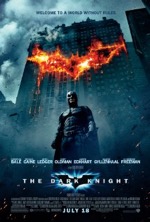
Starring: Christian Bale
July 2008
“Dark and Disturbing Bat-sequel Doesn’t Clown Around”
So how do you follow up a box office smash that not only rebooted a franchise but also proved beyond doubt that a comic book film could achieve high art status? Take a cue from Star Wars! George Lucas’ second Star Wars movie, The Empire Strikes Back (1980), was, in its day, the most successful sequel of all time. Empire kept audiences coming back with its bold new direction, darker tone and bitter outcomes, i.e., the bad guys occasionally win and the good guys get frozen and loose appendages.
The Dark Knight, like Empire, resisted the urge to rest on the success of its predecessor (Batman Begins) by taking a sharp left turn into the seedier and grittier regions of Gotham’s crime-infested underworld. Living up to the darkness denoted in its title, The Dark Knight is a well-crafted heist film, a highly styled noir and an elaborate Greek tragedy all wrapped up into a tangled, yet cohesive, ball of narrative yarn. Call it Batman meets The Departed.
Deuces are wild in The Dark Knight: besides being the second film in the series, it features two villains (one is even named Two-Face). The score was arranged and conducted by two veteran composers, Hans Zimmer and James Newton Howard: not since Jaws has an ascending two note main theme been used with such terrifying effectiveness. There’s also enough plot for two movies here and, as such, some may consider The Dark Knight to be too long.
With a movie as finely mounted and expertly executed as The Dark Knight, it’s nearly impossible to find fault with the film, and an objection leveled at any part of the picture is tantamount to a baseless attack; like pointing out one errant brushstroke in the Mona Lisa. Just the same, here are my gripes: Though the action is frenetic out of the starting gate, Nolan and David S. Goyer’s story is slow to unravel—the main point of the movie doesn’t coalesce until somewhere near the middle. Another minor irritant is the choose-your-own-fate gimmick which was used ad nauseam in the Spider-Man movies. Here, The Joker (Heath Ledger), who claims to be a man without a plan, sets up two separate scenarios where one person/group must be sacrificed so that the other person/group can live. Once is acceptable, twice is overkill in the same movie. Nolan’s one directorial miscue is his overuse of 360 degree tracking shots which keep spinning around until we’re all sufficiently dizzy. Oh, and is it my imagination or has Batman developed a speech impediment since the last movie?
On the flip side of the coin, the movie’s directing, acting and production values are nearly unimpeachable. The sweeping overhead cityscape shots are breathtaking as are the pulse-pounding action sequences. Nolan expertly, almost imperceptibly, alternates his action scenes between day and night. He also cleverly juxtaposes Harvey Dent, Gotham’s White Knight, with Batman, the city’s Dark Knight, and effectively turns the old “good guys wear white, bad guys wear black” Western film convention on its ear.
Most of the supporting ensemble was retained from the first film, including Michael Caine as Alfred, Gary Oldman as Lt. Gordon and Morgan Freeman as Lucius Fox; all of whom have meaty subplots here. Journeyman character actor, Eric Roberts, represents a crucial piece in the crime puzzle as mob boss, Salvatore Maroni, and Anthony Michael Hall keeps us well-informed as an earnest news reporter. The only significant casting change is that of Rachel Dawes: Maggie Gyllenhaal has replaced Katie Holmes, who received career-stalling advice from hubby Tom Cruise when he steered her toward a part in Mad Money and away from reprising her role in the Bat-sequel. Gyllenhaal immediately hits her stride as conflicted lover Dawes; Bruce’s old flame and Harvey’s new squeeze. If anything, Gyllenhaal’s portrayal of the driven young attorney is less strident and more balanced than Holmes’ Dawes, but, even with a successful baton exchange, it’s a shame that character continuity had to be disrupted.
Much has been made of Ledger’s maniacal riff on The Joker and his shocking death a few months after wrapping this film. Clamoring fans have petitioned for a posthumous nod for the Australian actor—solely based on what they saw in the trailer, mind you—but such wish fulfillment may prove too optimistic come Oscar season despite Ledger’s career-defining performance. Ledger’s Joker is, inexplicably, less sinister and psychotic than Jack Nicholson’s version of the Clown Prince of Crime in 1989s Batman. Still, this Joker is more accessible and less predictable which is far more entertaining to watch, especially when the mad genius outsmarts the cops and Batz at practically every turn. Whether or not Ledger gets a nod, this will go down as his most iconic role and Hollywood’s most effective villain since Hannibal Lecter.
As strange as it sounds, the focal point of the film isn’t Batman or The Joker, but Harvey “Two-Face” Dent (Aaron Eckhart, who delivers a superbly multi-faceted performance). Dent’s tragic fall from grace is the emotional and thematic vertex of the film. As an unwitting pawn, trapped between powerful agents of good and evil, Dent is forced to choose sides. His brazen statement, “You either die a hero or you live long enough to see yourself become the villain,” is a self-fulfilling prophecy; for in the end, The Joker outmaneuvers Batman and turns the crusading district attorney to the proverbial “dark side.” You can bet we’ll be seeing more of Two-Face in the next movie.
On the technology front, the highly advertised new Batpod is only in the movie for a few minutes before being totaled. Some may feel short-changed, but I find it refreshing, even ironic, that in a big budget action/adventure film the main attraction isn’t the FX or the newest hi-tech gizmo or machine, but rather, the hero’s courageous sacrifice, the villain’s psychotic schemes or the plot’s many twists and turns. Perhaps Batman films are helping to redefine the summer blockbuster as something other than a progression of filler scenes in between CG battles. One can only hope.
Though this wasn’t the sequel I expected, it’s hard to argue with the results. The movie’s direction is masterful, the writing is inspired, the acting is pitch-perfect and the production elements are superior in every category. This is an epic crime saga that just happens to have Batman in it…and that’s just the way Nolan wanted it.
Why so serious? Because The Dark Knight is a seriously good film that will captivate and exhilarate fanboys and casual viewers alike. Let’s just hope that Oscar takes it seriously!
Rating: 3 1/2
Vantage Point (PG-13)

Starring: Dennis Quaid
February 2008
“Do You See What I See…See…See?”
Four people standing on four corners of an intersection witness an accident. What does each one see?
I’m sure you’ve heard that hypothetical exercise in a philosophy or psychology class or perhaps in a riddle during a long road trip to help pass the time. It’s a simple illustration of a complex concept…point of view. The movie poster for Vantage Point succinctly spells out the movie’s premise while doubling the number of individuals in our example: 8 strangers, 8 points of view, 1 truth.
Vantage Point illustrates the subjectivity of viewpoint amid real world politics in our terror-wracked world. Freshman director, Pete Travis, says this about the movie’s intricate POV plot, “…our version of the truth depends on who we are and what perspective we’re viewing it from” (Empire, Feb 08). Like at the corner of an intersection.
The movie opens at an anti-terror summit in Salamanca, Spain, where the U. S. President (William Hurt) is set to deliver a rousing speech to a capacity crowd. As he approaches the podium, the President is shot by a sniper. Pandemonium erupts in the teeming square as panicked spectators flee the vicinity en masse. Then a bomb explodes and bodies rain down all over the courtyard. By the time the dust settles, we’ve got ourselves a whopper of a whodunit with frenetic, energetic action scenes and loads of political intrigue to spare.
However, the taut plot’s Achilles Heel is that the story rewinds five times to the same moment (twenty-three minutes before the assassination) and shows the same sequence of events but from different perspectives and, if we’re lucky, different angles. Useful for filling in the back story and gradually revealing more pieces to the puzzle, the movie’s repetition may prove exhausting to some, judging from the groans I heard each time the movie’s rewind button was engaged. However, writer Barry Levy deserves credit for delivering an intense and intelligent actioner with a Rashomon style plot device that bears up well under scrutiny while providing edge-of-your-seat exhilaration.
The movie’s A-list actors also deserve a shout out here. Sigourney Weaver, who plays a news journalist, does excellent work in a limited role—she only appears in the first act. Dennis Quaid and Matthew Fox are secret service agents. Quaid, who previously took a bullet for the president, is restive and a bit paranoid. Fox, on the other hand, is conspicuously calm during the movie’s tragic events. Forest Whitaker, in a superb turn as the innocent bystander who captures a glimpse of the assassin on his camcorder, is the emotional anchor in the movie and shines in the scenes where he tries to help a little girl find her mother among the stampeding throng.
Vantage Point is a good film, but with more experience at the helm and less redundancy in the non-linear story, it could have been great. Still, Vantage Point is an action-packed thrill ride that starts off in high gear, accelerates through the Bourne-like car chase and hits maximum velocity during the twisty, heart-stopping climax.
Final thought: If you find yourself needing a break from the repetitive storyline, don’t hesitate to get up and refill your popcorn. If you time it right, you can return to your seat at the same exact moment you left.
Rating: 3
The Bourne Ultimatum ( PG-13)
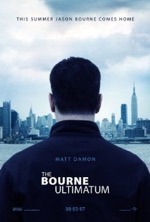
Starring: Matt Damon
August 2007
“Ultimatum is the Ultimate Bourne Adventure”
Bourne is back…with a vengeance! The Bourne Ultimatum, the third movie based on the thrill-packed trilogy by the late Robert Ludlum, brings the story full circle—back to NYC where it all started for Jason Bourne (Matt Damon), the fugitive of a top-secret governmental agency who trained him to be a no-nonsense, no compunctions assassin. The movie also brings back the fun and excitement of the first film, which was throttled back a bit in the middle chapter.
Globetrotting like Sydney Bristow in Alias, Bourne travels to several countries as he attempts to unravel the secrets of his past, which haunt his dreams but evade his conscious awareness. The taut actioner features Bourne surviving a shootout at London’s Waterloo Station, a high-speed motorcycle pursuit in Morocco, a pulse-pounding rooftop chase which culminates in a kick butt hand-to-hand melee and a car chase in NYC that climaxes with the most jarringly realistic crash ever committed to film. But all of these scenes pale in comparison to the jaw-dropping revelation at movie’s end when Bourne learns who he really is and how he became a cold-blooded killing machine.
The screenplay, by Tony Gilroy, Scott Z. Burns and George Nolfi, is a thoroughly enthralling yarn that boasts one of the most inventive, non-linear plot lines to come along in quite some time. Though the film is unabashedly action-packed from start to finish, director Paul Greengrass skillfully safeguards the movie’s refreshingly rich character development from being overshadowed by frenetic fistfights and explosions, a key to the film’s delicate balance between action and drama.
Though Ultimatum is the most emotionally and physically demanding Bourne outing yet, Damon handles the part with practiced ease, proving beyond any doubt that he belongs in the upper tier of action stars. Damon anchors the film, but the fine supporting players lend the film added depth. Joan Allen and Julia Stiles reprise their roles as FBI agents and are joined by movie legends Scott Glenn, David Strathairn and Albert Finney, each of whom turn in powerhouse performances in key roles.
“This is where it started for me,” Bourne states near the climax, “this is where it ends.” So, is this the end of the series or will Damon become Bourne again? The Bourne Legacy and The Bourne Betrayal (further Bourne adventures written by Eric Van Lustbader), could certainly provide fodder for future films, so time will tell. As things stand, the Bourne movies comprise one of the most exhilarating, and most exhausting, action trilogies in modern cinema.
Rating: 3 1/2
Live Free or Die Hard (PG-13)
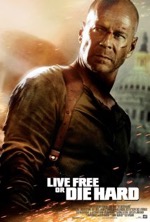
Starring: Bruce Willis
June 2007
“Old Action Stars Never Die…They Just Do Mediocre Sequels”
Life imitating art, and vice versa, has fueled many debates on ethical standards over the years, especially since societal ills are often blamed on one or the other. Executive Decision (1996), which starred Kurt Russell and Steven Seagal, focused on terrorists who hijack a jet and threaten to release a poisonous gas over Washington D.C. if their rebel leader wasn’t immediately released. Five years later our nation watched in disbelief as two commandeered jets crashed into the World Trade Center buildings, another grazed the Pentagon and yet another, United 93, crash landed in a Pennsylvanian field after its brave passengers prevented the plane from reaching its destination…the White House. Did Al-Qaeda come up with the idea of using jets as weapons all by themselves, or were they inspired—if only in small part—by the fertile minds in Hollywood?
In Bruce Willis’ new John McClane movie, Live Free or Die Hard, writers Mark Bomback and David Marconi set up a scenario where domestic terrorists (to keep things P.C.) hack into our government’s mainframe and create a “fire sale”—the crippling of our traffic control, financial and utility systems. As I was introduced to this new, potential threat to our country, the question that immediately popped into my head was, “Do we really need to give them any more ideas?”
In the film’s defense, the Die Hard series, since its pulse-pounding inception in 1988, has consistently featured nefarious types (generally from overseas) and their fanatical plans to commit acts of terror on our soil. However, the earlier trilogy was released before 9-11, and it goes without saying that the rules of the game have changed since then; leaving Live Free or Die Hard with no leg to stand on should an actual fire sale ravage our nation in the near future. There’s an old saying that goes, “Fool me once shame on you, fool me twice shame on me.” If an attack of this magnitude were carried out in our country, we would indeed be fools for having allowed our security to be threatened by an insidious plot packaged as entertainment and disseminated, en masse, at the Cineplex.
It’s a profound irony that the movie’s strongest element is the terrorist plot; on the flip side, the biggest contributors to the movie’s fits of incompetence are the flawed screenplay and static acting. Willis’ performance is exceedingly and disappointingly wooden; he delivers his lines with a swaggering overconfidence (the unfortunate side effect of being too comfortable with the role), which devolves McClane from character to caricature. The movie’s dialogue is as expressive and variegated as a telegram, and you just had to know that “Yippee ki yay” would be uttered somewhere in the film. Willis’ onscreen sidekick, Matthew Farrell (Justin Long), is just as off-putting as Mos Def’s nasally nitwit in Willis’ 16 Blocks, and the rest of the cast is largely forgettable.
The movie’s action sequences, though dynamic and frenetic, are so far-fetched they’ve actually redefined the word absurd. Semi vs. F-35 jet…need I say more? Actually, I think I will. I know the words Die Hard appear in the title, but just how difficult is it to kill John McClane, or wound or even bruise him? Like the old Timex slogan, McClane “takes a lickin’ and keeps on tickin’,” but credibility is shot to blazes when McClane takes a beating and then immediately gets up—without a scratch, mind you—and rushes headlong into the next action sequence. Most action movies push the limits of believability in this area, but Live Free or Die Hard conveniently tosses physical limitations and human attrition out the window. Maybe Willis is unbreakable?
Director Len Wiseman’s (Underworld) extensive background in various behind-the-scenes capacities clearly paid dividends in the movie’s top-notch production values, but he wasn’t nearly as effective at evincing convincing performances from the cast. As they say, you can’t squeeze blood from a turnip…you can’t produce Oscar-caliber performances from cardboard characters either. You’d have thought that after a twelve year sabbatical the fourth Die Hard film would have given us more to talk about than Bruce Willis’ bald head. So much for, “Good things come to those who wait.”
So, will John McClane return to save the world once again or will the series languish another decade and die? Hard to tell, but Stallone recently resurrected Rocky, so you never know. Where there’s a Willis there’s a way.
Rating: 3
Ocean’s Thirteen (PG-13)
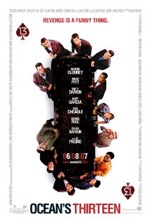
Starring: George Clooney
June 2007
“Clooney and Co. + Pacino = Lucky 13”
Steven Soderbergh’s Ocean’s Eleven was a rollicking riot of a good time, but the follow-up, Ocean’s Twelve, failed miserably because it tried to be too slick for its own good. Ocean’s Thirteen finds Danny Ocean (George Clooney) and his criminal cronies returning to Sin City, and fortunately for us, the fun has returned as well.
When casino tycoon, Willie Bank (Al Pacino) double-crosses Reuben (Elliott Gould), Danny hatches a plan that will repay Bank with interest for his ill-conceived ill turn: 1. sabotage the opening of Bank’s new casino so that it fails to receive a 5-star rating and, 2. swipe Bank’s cache of priceless diamonds before he knows he’s been hit.
All of the regulars are back, sans the women (Julia Roberts and Catherine Zeta-Jones); but even without the female headliners it still must have been a Herculean task to synchronize the schedules of so many A-list actors. Though this is primarily George, Brad and Matt’s movie, everyone is given generous screen time here…unlike the second film, which relegated secondary characters to marking time in jail until they could make a significant contribution to the story. Some of Ocean’s cohorts, like Virgil (Casey Affleck) and Turk (Scott Caan), have considerably more involvement here than in the earlier films; their side story in Mexico is uproariously funny.
Al Pacino was the perfect choice for billionaire Bank. Besides perfectly inhabiting his character and seamlessly blending in with the rest of the high-powered cast, Pacino brings legendary gravitas to the part of the nefarious antagonist. Andy Garcia played an adequate heavy in the first film, but the villain in the second movie was instantly forgettable. Pacino’s Bank is the best Ocean’s villain to date because he strikes the perfect balance of loathing and respect in the spectator; an effective combination.
The previous Ocean’s films utilized narrative sleight-of-hand and flashback sequences to reveal the intricacies of the heist, but this film doesn’t have any tricks up its sleeve. The straightforward storyline lulls the audience into thinking they have it all figured out, and then broadsides them with one mind-blowing twist after the next. You’d think—from a creative standpoint—that this type of plot structure would be less imaginative and more constrictive, but when random deviations start to derail Ocean’s painstakingly calculated plan, the movie actually becomes more enjoyable than if writers Brian Koppelman and David Levien had regurgitated the same well-worn storytelling device employed in the earlier films.
Ocean’s Thirteen has restored the series to its former, fun-loving form. Now the question is: Will there be an Ocean’s Fourteen? Like most Hollywood films, especially sequels, it’ll be a crapshoot.
Rating: 3
Breach (PG-13)

Starring: Chris Cooper
February 2007
“Cooper is Mesmerizing in Political Potboiler”
Based on the gripping true story of how the worst traitor in the history of U.S. Intelligence was discovered and brought to justice, Breach is a fascinating post-Cold War yarn which underlines the unsettling notion that the last person you’d suspect of being a criminal often times is.
FBI agent, Robert Hanssen (Chris Cooper) has projected such a sanitary image of himself throughout his distinguished career that he’s been placed in charge of a special task force to ferret out a rogue agent who’s been selling secrets to the Russians. A devout Catholic and family man, Robert never drinks (even off duty) and frequently extols the virtues of prayer. But Mr. Clean, it turns out, has some dark secrets which are eventually unearthed by Agent Burroughs (Laura Linney). Burroughs “promotes” Robert to a new post and assigns callow agent, Eric O’Neil (Ryan Phillippe), to serve as Robert’s assistant and her informant. As the high stakes chess match plays out, the questions become: is Robert guilty of treason, and if so, is anyone clever enough to beat him at his own game?
Breach, even without car chases and shootouts, is a first-rate potboiler that contains enough intrigue to fill two movies—the PDA download and car sweep scenes are especially suspenseful. Director Billy Ray does an excellent job of gradually building intensity throughout the film, and the script by Adam Mazer and William Rotko doesn’t miss a beat. The movie’s incisive dialogue is finely crafted and contains several memorable gems, like Robert’s first line to Eric, “Tell me five things about yourself and four of them true.”
Cooper turns in a spellbinding performance as Hanssen and almost single-handedly carries the movie: when it comes to chewing scenery, Cooper could give Pac Man a run for his money. Cooper’s wonderfully nuanced portrayal of straight-laced, no-nonsense, yet privately perverted Hanssen (the scene where he lusts after Entrapment’s Catherine Zeta-Jones is downright disturbing), is utterly captivating and convincing. An Oscar nod would be the appropriate response to this powerhouse performance.
Though some have exiguous onscreen time, the supporting actors play a vital role in servicing the plot as they fall into orbit around Cooper: Linney and Phillippe are joined by Caroline Dhavernas as Eric’s wife, Kathleen Quinlan as Robert’s wife, Bruce Davison as Eric’s father, Gary Cole as Agent Garces and 24’s Dennis Haysbert as Agent Plesac.
Besides touting the acting, directing and writing, there’s little more that can be said here without spoiling the plot to this truly riveting tale; a story that’s made all the more alarming by its factual elements. As the shock and horror of 9/11 continues to fade from our collective consciousness, Breach is a jarring reminder of the ever-increasing need for intelligence and vigilance…lest we should forget the tragedies of the past.
Rating: 3
Freedom Writers (PG-13)

Starring: Hilary Swank
January 2007
“Standard ‘True Story’ Formula Shackles Inspirational Tale”
From MTV Films, producers of Coach Carter, comes Freedom Writers, another inner-city portrait which is also based on a true story and features Academy award winning Hilary Swank as indomitable educator, Erin Gruwell. In the wake of 1992’s Rodney King riots in L.A., Woodrow Wilson High School, while embroiled in a tumultuous integration program, was reeling from violent turf wars not dissimilar to the ones taking place outside the school’s barbwire brimmed walls. Enter into that seething cauldron of bigotry and race hatred Mrs. Gruwell, a prim and proper freshman teacher who insists on wearing a real pearl necklace while also wearing a perpetual smile. Her smile is quickly erased when a knockdown, drag out fight ensues in her inaugural class.
With the classroom doubling as a battleground, teaching is a daily struggle to survive. Mrs. Gruwell eventually connects with her students as she learns their back stories. There’s an excellent scene where Mrs. Gruwell plays the “line game” with her students. Two rows of students face each other with a dividing line between them; a step toward the line indicates that a particular question applies to an individual. Mrs. Gruwell’s worst fears are confirmed when statements like, “Step toward the line if you’ve lost a friend to gang violence,” reveal the grim reality her students face on a daily basis.
The movie is standard in many ways; besides adhering too closely to the Coach Carter template, the movie comes complete with a connect-the-dots plot and underdeveloped supporting characters, played here by Scott Glenn as Gruwell’s dotting dad and Patrick Dempsey as her neglected husband. Other inherent weaknesses in the movie are a cloying resolution and an oversimplified remedy for educational and societal ills. I’m truly glad that Gruwell’s unorthodox methods of teaching paid off for a small group of young adults, but if the movie’s writers and producers are trying to champion a cause or inspire a movement, they’re being overly idealistic, much like Gruwell on her first day as a teacher. Besides, aren’t there more remarkable true stories out there just waiting to see the (green) light of day? Is Hollywood really that devoid of original material? Are we, as a society, so starved for heroes that the story of a rookie teacher who encourages her students to write about their hang-ups in journals will not only inspire us, but also induce us to shell out ten dollars to see it?
Freedom Writers is an unremarkable human interest story that has all the salience and staying power of one of those warm-fuzzy features that air at the end of news broadcasts. For those hoping to experience a feel-good flick, Freedom Writers might seem like it’s hot off the press, but for most, the movie will read like yesterday’s news.
Rating: 2 1/2
Casino Royale (PG-13)
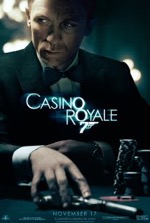
Starring: Daniel Craig
November 2006
“High Stakes Bond With a Rising Star”
From the first frame of the opening sequence—a brilliant, casino-themed montage where guns shoot spades, featureless victims bleed small red hearts and a person falling to his death shatters into a pile of cards upon impact—it’s clear that this isn’t your father’s Bond movie. Incidentally, this is also the first Bond film in memory that doesn’t showcase silhouetted naked women in the opener. The firsts don’t stop there; Casino Royale, based on the novel of the same name by Ian Fleming, chronologically predates all of the previous Bond films, making it a prequel of sorts. As such, we are retrospectively introduced to some Bond’s most recognizable touchstones; we discover how Bond comes to own his Aston Martin, learn how he creates the phrase, “shaken, not stirred,” and witness his first utterance of that iconic line, “Bond, James Bond.”
When Daniel Craig (Layer Cake) was confirmed as the new Bond, I was more than just a little skeptical; however, my misgivings were wholly unfounded. With all due respect to Connery and the rest of the gang, Craig, pound for pound, might just be the best Bond ever. He’s certainly more ripped than any former 007, judging from the scene where Bond emerges from the ocean with a premium six-pack—a tableau that parallels Halle Berry’s entrance in Die Another Day. Where Pierce Brosnan’s Bond would have quipped, finessed or negotiated his way out of a fight, Craig’s Bond bulldozes anyone who poses a threat to him. As such, the new Bond is scrappier than his predecessors and takes the quickest route to dispatching his enemies a la 24’s Jack Bauer. What’s refreshing—for an action hero archetype—is that this Bond occasionally makes mistakes (like when he gives himself up by clumsily tailing a bad guy), albeit, not fatal ones.
The stunt work, fight scenes and action sequences in Casino Royale are some of the finest in the entire series and are certainly above par when compared to your garden variety action picture. Some of the movie’s best action scenes include an explosive car chase at Miami International Airport, an all-out, hand-to-hand slugfest in a hotel stairwell and a frenetic shootout inside a pontoon-fortified Venetian building. However, all of those scenes pale in comparison to the opening, skyscraper scaffolding sequence in Madagascar where Bond pursues a bomb-toting, free running terrorist who scales walls like Spider-Man and bounces over and around obstacles like a monkey on speed. The scene easily qualifies as the finest action sequence I’ve ever seen…if it fails to get your heart racing, you have no pulse.
For poker lovers, roughly a quarter of the movie focuses on a high stakes Texas hold ‘em tournament in Montenegro. However, even if you don’t know the difference between a straight and a flush (or a straight flush), you’ll still enjoy the psychological warfare employed by the players along with the refined trash talking that randomly bounces around the table like a pinball. Here’s the scenario: If Bond wins, he will financially cripple an international terrorist organization…if he looses, Her Majesty will have just funded said terrorist group.
For female viewers, the movie also features a friction-filled romance between Bond and hard-to-get Vesper Lynd (Eva Green), an accountant sent to keep an eye on Bond and distract the other players with her slender frame, dangerous curves and bedazzling red dress. There’s a wonderful scene where Bond and Vesper engage in a war of words on a train bound for Montenegro. Fraught with sexual tension, double entendres and some of the best repartee I’ve heard since Cary Grant and Eva Marie Saint patented the lascivious train ride in Hitchcock’s classic North by Northwest, the scene kicks the romance subplot into high gear, and sets the stage for the twisty and tragic climax.
What makes this Bond superior to its forebears is the sure-handed directing by Martin Campbell and the superlative script penned by Academy-award winning screenwriter, Paul Haggis (Million Dollar Baby). The movie has great supporting characters including Judi Dench, who reprises her role as M and Mads Mikkelsen as a heartless villain, Le Chiffre, a man who bleeds from his blind right eye when angered.
Casino Royale is the best Bond to date, and not just because of its up-to-date FX or its new star; this is a more modern and mature Bond, unshackled by the usual silliness involving hi-tech gadgets and gizmos. With a film this superior, odds are we’ll be seeing Bond…Craig’s Bond again very soon.
Rating: 3
The Sentinel (PG-13)

Starring: Michael Douglas
April 2006
“Paranoid Thriller Hits the Mark with Star Power and a Taut Plot”
The Secret Service: one of the most well-trained, well-equipped and well-informed agencies on the planet. Fiercely loyal to America and the president, Secret Service officers represent the finest our country has to offer—unswerving patriots who would gladly die to protect national security. Pete Garrison (Michael Douglas) is such a man—he took a bullet for Reagan in 1981. In today’s terror-filled world replete with blurred lines and shifting loyalties, the haunting question has become: Could such a man be bought, and if so, at what price? Could there be spies in our country or traitors among our government’s elite force, the president’s last line of defense?
As the movie opens, new intelligence suggests that an attempt will be made on the president’s life (a daily occurrence in real life) and that there’s a mole inside the Secret Service. An agency-wide mandate requires all agents to subject themselves to a lie detector test. Pete fails the test, and when a fellow agent turns up dead, suspicions, naturally, are cast in Pete’s direction. Pete’s protégé, Dave Breckenridge (Kiefer Sutherland) and his newly assigned assistant, Jill Marin (Desperate Housewives’ Eva Longoria) are given the task of locating Pete and bringing him in on the charge of treason—a task Dave eagerly accepts since Pete slept with his wife years earlier (ironically, Pete is currently having an affair with the 1st Lady, played by Kim Basinger).
What ensues is a chase somewhat reminiscent of Harrison Ford’s flight from the U.S. Marshals in The Fugitive. The pursuit ends at a shipping yard where Pete makes a convincing argument for his innocence…Dave lets Pete escape. Later, Dave becomes more convinced of Pete’s veracity when he finds Pete running tests at Langley. Dave surmises, “A guilty person wouldn’t break into a crime lab to prove his innocence.”
One of the more pulse-pounding scenes in the movie is where an agent flips a coin and unwittingly determines the president’s fate: heads, the president goes in a motorcade, tails, he takes a helicopter. In a sequence seemingly spliced in from Sutherland’s 24, a rocket sails through the air, collides with the helicopter and transforms it into a plume of smoke, flame and debris. Fortunately, fate and the coin sent the president home in the motorcade instead of the helicopter.
The other standout scene, at least for testosterone-driven viewers (let’s face it, the movie’s target audience), is the final shootout at the political summit in Toronto. An assassin casually sits in a stairwell and picks off anyone who comes around the corner—hoping to score a hit on the president. Again, fortune smiles upon the pinned-down president when one of the mole’s accomplices has a change of heart and dies protecting the commander-in-chief. Pete and Dave arrive, not a moment too soon, and take out the assassin and his cronies. A tenuous friendship forms between ex-partners in the contrived dénouement; the movie’s feeble attempt at forcing a happy ending where one isn’t required.
The Sentinel has an identity crisis of sorts—the focus keeps bouncing back and forth between Pete and Dave like a tennis ball at Wimbledon. The movie isn’t a vehicle for either Douglas or Sutherland, but is, ironically, better off for just that reason…a film spotlighting either character, exclusively, would have flopped. As it is, The Sentinel has just the right mix of action, suspense, romance, political intrigue and character dynamics to please a wide range of potential spectators. It’s a B movie that aspires to be an A tier film, and somehow manages to pull off that feat with A-list performances, deft direction by Clark Johnson and a taut screenplay written by George Nolfi, based on the novel by Gerald Petievich. The Sentinel is a good popcorn flick, no doubt, but it’s also a sober reminder of the changing face of terror.
Rating: 2 1/2
16 Blocks (PG-13)
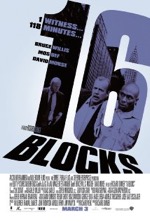
Starring: Bruce Willis
March 2006
“Dark and Gritty, But Not Sin City”
In Richard Donner’s 16 Blocks, Bruce Willis plays Jack Mosley, a haggard, beleaguered NYPD detective who drinks on the job and hobbles around on a bum leg—in other words, the very antithesis of John McClane from Willis’ Die Hard movies. And yet, this is one of Willis’ most refreshing roles in ages; by playing against type, he may have just rejuvenated his career…at least until the release of Die Hard 4.
The movie’s premise is basic enough—Jack must transport a witness, Eddie Bunker (Mos Def), sixteen blocks to the courthouse so that Eddie can testify and bring down six bad cops—but hit men and Jack’s crooked ex-partner, Frank Nugent (David Morse), make the sixteen blocks a serpentine maze of high stakes and narrow escapes. The time constraint (Jack must get Eddie to the courthouse in less than two hours) amps up the drama and a nicely executed twist near the movie’s climax hoists the movie to a level just above the standard action/thriller.
Though the bus sequence reminded me too much of Speed, some of the other action scenes were exceptionally well-crafted; like the hit on Jack’s car while he’s in the liquor store, or the stand-off in the bar or the shoot-out behind the restaurant, which is preceded by an intense verbal sparring match between ex-partners (Frank implores Jack to look the other way and hand over the kid).
Bullets are cheap in the movie, but between pulse-pounding action sequences a fair amount of attention is given to character analysis; such as Eddie’s perpetual death grip on his notebook. We eventually learn that the book is full of recipes—Eddie’s dream is to open a bakery where “every day is a birthday.” Eddie’s nasal delivery gets old after five minutes and his obnoxious blustering gets old even quicker; there’s only one instance in the movie where his effusive small-talk comes in handy…the rest of the time it nearly gets him and Jack killed. At times, you have to resist the urge to yell, “Shut up, already!” at the screen (a fellow spectator remarked, “The trick is to keep him from being killed without killing him.”). Perhaps Jack said it best, “Life’s too long and it’s people like you that make it longer.”
Jack is a fascinating, multi-layered protagonist: he tells Eddie, “I’m not a good guy,” yet when he tape records his last will and testament Jack claims that he’s “trying to do a good thing,” and certainly follows through with that intention at the movie’s climax. One thing I don’t like about the movie (other than Eddie’s excessive chin-wagging) is Jack’s change of heart—it’s a good twist and makes for a pseudo-happy ending, but it lifts the lid on the pressure cooker, effectively letting out any steam the movie had been building. If Jack had come to his senses and decided to change his ways earlier, Eddie would have been imperiled far less and fewer casualties would have been suffered along the way…in essence, Jack’s reformation makes all of the bullet showers and, in fact, Eddie’s very presence in the movie, utterly unnecessary.
Eddie’s parting encouragement to Jack, “People can change,” is a bit maudlin, but the point is well-taken; especially for typecast action stars desperately in search of a hit. 16 Blocks is a gritty urban drama that will satisfy hard-core action fans but will probably loose the rest of its audience somewhere between the precinct and the courthouse.
Rating: 2 1/2
The Pink Panther (PG-13)
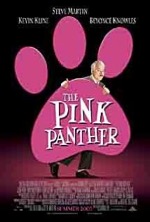
Starring: Steve Martin
February 2006
“Martin is Most Amusing When He Doesn’t Have a Clue”
Inspector Jacques Clouseau has been on quite a sabbatical. Last seen in 1993’s Son of the Pink Panther, it had been nearly twenty years before that when the brilliant Peter Sellers had finally hung up his detective’s hat after successfully playing the clumsy Clouseau in all four of the original Pink Panther movies.
This Pink Panther caper opens at a World Cup finals match between China and France in Paris. When the revered French coach is murdered by a poison dart at the conclusion of the contest and the famous Pink Panther diamond turns up missing, French police immediately launch an investigation. Chief Inspector Dreyfus (Kevin Klein) hatches a plan to catch the killer, an accomplishment that will solidify his claim on the elusive Medal of Honor—Dreyfus has been passed up for the coveted prize seven times. Dreyfus’ plan is to commission an incompetent cop to distract and divert the killer while he and the finest team of investigators in all of France nab the miscreant. The “perfect man” for the job is Jacque Clouseau (Steve Martin), a bumbling idiot and walking calamity, who mistakenly thinks his promotion to the rank of inspector is based on merit. What ensues is a witless investigation brimming with gags, double entendres and abject lunacy. Half the time I rolled my eyes, the rest of the time I was rolling on the floor at Martin’s unrelenting antics—he was the perfect choice to play dunderheaded Clouseau.
The movie’s storyline is essentially one catastrophe after the next. Some of my favorite moments are Clouseau’s alternate good cop/bad cop routine, Clouseau’s conversation with the Asian woman and the scene where Clouseau and his deputy sneak into Dreyfus’ ball in disguise. The movie’s creative highlight is when Clouseau crosses paths with 006—besides being uproariously funny, the scene features a nice bit of surprise casting.
And speaking of casting, the supporting characters add wonderful color and texture to the film, especially Ponton (Jean Reno), Clouseau’s vigilant deputy, Nicole (Emily Mortimer), Clouseau’s love interest, Xania the singer (Beyonce Knowles) and Yuri the trainer who trains (Henry Czerny). Martin and Klein are brilliant together, as are Martin and Reno; the scenes where Clouseau initiates random attacks on the deputy are idiotic and yet I still laughed. Perhaps that’s the film’s secret weapon; even when you don’t want to laugh, you end up doing it anyway…the movie is insidious that way.
Though The Pink Panther is replete with slapstick silliness, it’s also one hundred percent entertaining. Whether or not box office returns warrant a sequel, Martin’s Clouseau tickled me pink!
Rating: 2 1/2
Firewall (PG-13)

Starring: Harrison Ford
February 2006
“High-Tech Thrill Ride with an Old Ford”
Last seen in Hollywood Homicide (or rescuing disoriented hikers with his helicopter); Harrison Ford has staged a significant comeback with Firewall, a taut cyber-thriller from writer Joe Forte and director Richard Loncraine. In my review for Hollywood Homicide, I wrote, “Unlike some naysayers, I believe there’s still gas in the old Ford, but he needs to choose better films to act in…” Firewall is definitely “better” than his last outing, and though it fails to reach the level of intensity found in Air Force One, the movie is familiar territory for Ford and is, therefore, an ideal way for him to ease back into the routines and rigors of the biz.
Jack Stanfield (Ford) is a bright, hard-working bank security system designer who also manages to find time to be a family man. Jack’s wife, Beth (Virginia Madsen), is an architect and stay-at-home mom who keeps a watchful eye on their two quarreling kids, Sarah (Carly Schroeder) and Andy (Jimmy Bennett), and loyal pooch, Rusty.
On a rainy night in Seattle (which one isn’t?), a man jumps in the back seat of Jack’s car (nitpick: most people entering a car by themselves only open their door), points a gun at Jack’s head and tells him to drive home. Meanwhile, Beth answers the door for the pizza man and is accosted by several men toting guns and high-tech equipment. When Jack arrives at his home, he finds his family tied and gagged in the kitchen and a center of operations with fully-functioning computers and monitors set up in his living room. The leader of the outfit is a man named Cox (Paul Bettany in a typecast shattering role); he and his minions have been spying on Jack and his family for months in preparation for this heist. The plan is simple; while Cox and crew make themselves at home in Jack’s sprawling, beachfront mansion, Jack will go to work like normal and devise a way to hack into the system he designed. Jack must steal a hundred million dollars (virtual money) from the bank’s wealthiest investors, or his wife and children will be killed. The balance of the movie sees Jack scrambling to keep his family safe, while devising a way to prevent cold-blooded Cox (he kills his own men when they fail him, a la Vader) from getting even a dime.
The movie may be a tad slow out of the blocks, but once Cox initiates his plan, the movie transforms into a first-rate thriller where the hero has to stay one step ahead of the bad guys…or else. Ford enjoys solid support from Bettany and Madsen (Alan Arkin and Robert Patrick are throw-away characters, unfortunately, but 24’s Mary Lynn Rajskub plays a significant part as Jack’s secretary), but it’s his performance that really carries the movie. The character of Jack Stanfield isn’t as self-confident as Jack Ryan, nor is he as resourceful as Indy or as plucky as Han, but he’s really more interesting because he’s an “Average Joe.” The strength of this Jack is his “every day guy” appeal, which services this storyline far better than if he was one of those other guys—cut from hero’s cloth.
If the movie has a message, it’s that elaborate schemes can be quickly undone by everyday or unsuspected pieces of technology. Here are some examples: Cox puts a pen with a spy camera in Jack’s breast pocket to keep tabs on him, but Jack quickly figures out how to dump it off to a co-worker. Jack stages an escape in his house by using Andy’s remote controlled car to create static on the Cox’s security monitors. Jack uses Sarah’s iPod to download the account numbers of prominent bank lenders (to the machine, they’re just files), but Jack, wisely, takes a picture of the monitor screen with a cell phone and later returns all of the stolen money to the proper accounts from an airport bank. Jack ultimately finds Cox and his kidnapped family in an abandoned country house thanks to Rusty’s dog collar, which contains a G.P.S. sensor that can be tracked from the internet.
Despite gaping plot holes (i.e. Cox’s entire, ill-advised plan, which is made laughable when one considers the abundance of advance intel he had at his disposal), Firewall is an edge-of-your-seat thriller that climaxes with an old-fashioned fist fight and a heart-warming family reunion. Ford’s movements may be a little stiff, especially during action sequences, but he’s still the man. Welcome back, Harrison; don’t be a stranger!
Rating: 3
Batman Begins (PG-13)

Starring: Christian Bale
June 2005
“The Dark Knight’s Sordid Origins Are Finally Revealed”
I was never a fan of the campy 60’s TV series, but I’ve read my fair share of Batman comic books. I saw the Dark Knight’s theatrical hat trick in the 90’s, and though I enjoyed moments of those Gothic tales (except for Schumacher’s debacle), I’ve always been a proponent of Batman: The Animated Series and have contended since its inception that any of those brilliant, half-hour episodes are better than the movies…until now.
Director, Christopher Nolan, has returned Batman to his essential and elemental roots in the globetrotting origins tale appropriately dubbed, Batman Begins. From the opening sequence, where young Bruce Wayne falls into a pit teeming with squealing bats, to the final scene where Batman (Christian Bale) and Lieutenant Gordon (Gary Oldman) discuss a clue that will lead them to next movie’s villain, this is the movie I, along with countless millions, have been chomping at the cowl to see…the birth of Batman.
Avoiding the pitfalls of the past (i.e. psychedelic neon lights or nippled Bat-suits), screenwriter, David S. Goyer, has drawn fully realized characters in real life situations…no oversized props or larger-than-life villains here. Goyer clearly did his homework for this project, researching the Dark Knight’s haunted past and neurotic present—he masterfully cuts back and forth between Bruce Wayne’s boyhood tragedies and adult struggles with fear and injustice. There’s a fair amount of social commentary in the movie that, thankfully, never comes across as stilted: themes of government corruption, societal degradation and terrorist infiltration of our infrastructure run rampant throughout the film. Besides a powerfully gripping and salient story with finely chiseled characters, Goyer’s dialogue is witty, incisive and delightfully variegated (though Gordon’s reaction to the new Batmobile, “I’ve gotta’ get me one of those,” was a bit much).
Nolan has assembled a dream cast headlined by Bale, whose previous movie, The Machinist, called for a severely emaciated insomniac—the Welsh thespian gained 100 pounds in six months to adequately fill out the Bat-suit. Bale just might be the best big-screen Batman ever—he perfectly captures Keaton’s brooding melancholy and exhibits more humanity and vulnerability than either Kilmer or Clooney. Bale’s gravelly baritone is more menacing than any previous, live-action actor (no one will ever eclipse The Animated Series’ Kevin Conroy) to don the cape and cowl.
Aside from Crash, Batman Begins boasts this year’s finest supporting cast of A-list actors, including: Michael Caine, Liam Neeson, Katie Holmes, Oldman, Cillian Murphy, Tom Wilkinson, Rutger Hauer, Ken Watanabe and Morgan Freeman. In an ironic turn, Neeson plays Ducard, Bruce’s Jedi-esque instructor, whose seemingly limitless knowledge veils a dangerously misguided soul. Murphy is pitch-perfect as the chillingly calculated Dr. Crane/Scarecrow, and Caine is the anchor and conscience (not to mention comic relief) of the film as the staid butler, Alfred—the scene where he struggles to get unconscious Rachel (Holmes) into the backseat of a car is uproariously funny.
Nolan’s bold vision has reinvented and reinvigorated a comatose, left-for-dead movie series. For legions of hopeful fans, or snake-bitten skeptics, who desperately want to believe that Batman is still a popular and profitable property, this movie should assuage any lingering doubts as to the Dark Knight’s appeal and potential—the franchise has faced its darkest fears and overcome them in grand, heroic fashion (much like our redoubtable protagonist). With Bale already onboard for a sequel and Nolan hinting at a trilogy, Batman’s screen future seems as secure as a lodged Batarang.
I’m extremely stingy when it comes to handing out perfect scores, but my only snafu with Batman Begins is that Gotham City is Chicago, not New York as I prefer—and that’s pretty picayune. The only trouble the series now faces is a name for the sequel…Batman Continues?
Rating: 4
Millions (PG-13)
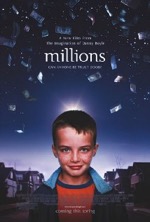
Starring: Alex Etel
April 2005
“Smart and Stylish: The Next Generation of Family Film”
Damian (cherubic Alex Etel) and Anthony (Lewis McGibbon) are seven and nine year old British boys, respectively, who have recently lost their mother—and to add insult to injury, their father moves them to a new neighborhood and school. Damian is a dreamer with a truly beautiful and innocent mind; a young man who can rattle off statistics about Catholic saints faster than any priest this side of the papacy, and who is oft visited by such venerated figures in his fertile and impressionable imagination. Damian builds an elaborate cardboard fort near some train tracks and fancies himself an astronaut when the train rumbles past—the raucous rumble of boxcars, the strident sound of wheels on steel and jostling vibrations that threaten to topple the makeshift shelter all simulate a lift-off sequence, and in his mind, Damian is launching into space.
On one fateful day, a duffel bag flies free from the train and flattens a section of Damian’s ramshackle fortress: curious, Damian opens the overstuffed bag to discover bundles of cash. Damian confides in Anthony and the two are soon building towers out of money stacks in their room. Replacing the cash and hiding the bag under their bed, they vow not to tell their father.
Damian consults his imaginary companions for guidance on how best to use the money: the saints suggest giving a portion to the poor, which he does without a moment’s hesitation. Whereas Damian’s motives are honorable, Anthony uses the money for personal gain—he hires bodyguards to protect him at school and buys friends by handing out bills.
Inevitably, word gets out that the boys are wealthy and they attract unwanted attention; a problem not aided by Damian’s impulsive acts of altruism, i.e.: dropping cash down the mail slot of a poor man’s door and tossing a bundle into the collection bucket for a school charity. The boys’ delirium over finding the cash is quickly replaced by guilt, fear and paranoia, especially when the money’s rightful owner shows up—a creepy drifter whose attempts at manipulating Damian amps up the thriller section of the movie. Another effective story device that adds tension to the more intimate and pedestrian moments in the movie is the conversion of currency to the Euro. With the deadline drawing closer and the shady man scheming for the money, Damian and Anthony turn to the only person they can trust…their father.
Millions is worth every penny of its namesake and has affectively ushered in a new era of family-friendly films—sophisticated and stylish, the movie embraces the Nickelodeon bunch without alienating the adult set. It’s ironic that this vanguard in family pictures comes from such and unlikely director, Danny Boyle (Trainspotting), but the auteur has crafted an exquisite film both in character and creativity. The time-lapse sequence at the beginning of the movie—an entire sub-division springs to life before our very eyes—is absolutely brilliant. The cell phone scene is also wildly imaginative: the brothers, sitting side-by-side on top of a hill, carry on a conversation with each other and two red, vertical lines reaching toward the sky represent the satellite link between them.
As young Damian, Etel is a revelation in pure, unadulterated innocence—his childlike wonder is truly the highlight of the film. Damian asks every imaginary saint he meets if they’ve heard of a new arrival named Saint Maureen, but none of them have. The movie’s emotional payoff comes near the end, when Damian is reunited with his departed mother (the saint he’s been inquiring about) in a tender vision—the moment of poignant closure allows the young boy to finally move past his mother’s untimely death.
The only scene I could have done without is the controversial depiction of St. Peter. Here, the disciple is a swearing, smoking, heresy-espousing figure with a tilted halo and a humanistic account of Jesus’ miracle of feeding the 5,000. Unfortunately, this brief exchange stands out as an unseemly tear in an otherwise beautiful tapestry woven by skilled screenwriter, Frank Cottrell Boyle.
Destined to become an annual favorite at Christmas time (the movie’s climax takes place during the Holiday season), as well as a chart-topper on family film lists for years to come, Millions is a rare breed—entertaining on many levels and salient for every generation, the movie is truly one in a million.
Rating: 3 1/2
Ocean’s Twelve (PG-13)

Starring: George Clooney
December 2004
“A Lot Less, Even with One More”
The long-awaited follow-up to 2001’s stylish smash-hit, Ocean’s Eleven, features the same cast as the earlier film, plus Catherine Zeta-Jones, and is helmed, again, by Steven Soderbergh. The question that always arises with a sequel is: “Is it as good as the first?” Answer: Ocean’s Twelve fails to equal, much less surpass, its modern predecessor. Here’s a rare exception in scriptwriting, where too much plot is actually an impediment to the movie’s entertainment value.
Soderbergh has toned down the flashy editing style displayed in Ocean’s Eleven (which employed a variety of wipes, quick cuts and multiple/moving frame shots), but here, the disjointed storyline has nearly the same effect. How do you take an average script and make it seem more complex? Present it in a non-linear fashion! It worked for the first film, so why not try it again? This time around the narrative sleight of hand doesn’t work, because the audience is ready for it. Also, the movie is saturated with technical jargon from the thieving handbook, which comes off as gibberish to the average viewer not educated in criminology.
Ocean’s Twelve ambles along on cruise control for most of the movie and introduces very few new characters or situations. It’s almost as if the producers thought, “Shoot the picture in some amazing European locations, have the preponderance of A-list actors pull off another mind-blowing heist and audiences will love it.” Guess again! Character development is appallingly shallow in the film; the writers just expect us to know everything about these people from the first film and only make cursory attempts at reacquainting us with or expanding our knowledge of these characters in any meaningful way.
The movie makes some significant missteps near the climax: the Tess Ocean (Julia Roberts) playing Julia Roberts sequence is inane, as is Bruce Willis’ zany cameo (let’s add one more luminary to the film, because we’re not quite sure we have enough star-power). Saul (Carl Reiner), the potential wildcard, shows up to save the day, but is promptly thrown into jail with the rest of the incarcerated cast. Vincent Cassel’s villain, Night Fox, is a worthy, if under-developed adversary, but his dance through the lasers is simply a fast forward version of the one seen in Entrapment. And finally, the reunion between Zeta-Jones’ character and her thieving father feels contrived and lacks emotional punch.
Ocean’s Twelve is devoid of the light-hearted synergy that Ocean’s Eleven had in spades. Where’s the fun? Where’s the humor? The bottom line: Ocean’s Twelve would have been twice as enjoyable if it had been half as confusing.
Rating: 2
The Bourne Supremacy (PG-13)

Starring: Matt Damon
July 2004
“Sequel is Supremely Disappointing”
Matt Damon is back as Jason Bourne in The Bourne Supremacy, the second film based on Robert Ludlum's popular spy novels. On the face of it, The Bourne Supremacy has just as much drama, intrigue and action as the first, but upon further reflection, the sequel falls short on several counts.
First of all, we were introduced to Bourne in the original film, so we pretty much know who he is and what he's capable of—we also know a good amount of his back-story. That's a down shot, because most of the fun in the first film was learning about Bourne as he learned about himself (amnesia).
Another aspect missing from the sequel is the romance factor. Bourne's girlfriend, Marie (Franka Potente), is seen in the first ten minutes and then she's conveniently killed off. I say convenient, because Marie's death does service the plot; Bourne comes out of hiding—with a vengeance—and starts tracking down the Russian assassin (Karl Urban) responsible for killing Marie and framing him.
The cast in this movie is almost identical to the previous one with a couple of notable exceptions. Deceased Agent Conklin (Chris Cooper) shows up in one of Bourne's retrieved memories—his first assignment when he killed the Russian president. Brian Cox (X-Men 2) is back as Ward Abbott, the hard-nosed, no-nonsense agent who stops at nothing to cover up top secret project Treadstone, including murdering a fellow agent, and, ultimately, committing suicide. Julia Stiles pops up again in the C.I.A. field ops and is reduced to set dressing once again, performing in a handful of scenes and delivering an equal number of lines. Her character serves no purpose, whatsoever, and Stiles makes such a superfluous cameo, that I don't even remember her character's name. The new face belongs to Joan Allen, who plays the tough, yet sympathetic Agent Pamela Lundy, the most fleshed-out character in the film other than Bourne.
There's a new director this time around, Paul Greengrass, and though his style lends itself to action pictures, his big car chase at the end of the movie was too long and frenetic—the scene plays like a six minute blur. And why another car chase, I ask? We already had our requisite pursuit last movie. Also, we’ve already seen a mano a mano slugfest between Bourne and some well-trained assailant the last time. The subway sequence was original, but most of the action in The Bourne Supremacy feels like stock footage from The Bourne Identity. The Bourne Supremacy is a slightly better than average action movie that doesn't measure up to the first and falls woefully short of my supreme expectations.
Rating: 2 1/2
The Whole Ten Yards (PG-13)
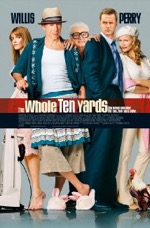
Starring: Bruce Willis
April 2004
“A Dud by Any Measurement”
I have two confessions to make regarding The Whole Ten Yards. I never saw the original The Whole Nine Yards, although I got the gist of the plot from the trailer. Secondly, I was bored with the movie even while the opening credits were still rolling. The movie failed to engage me on any level, and to call it entertainment would be a gross overstatement.
Part of the movie’s problem is its identity crisis—is it a comedy (it’s not all that funny), is it an action flick (there are only a few, short action sequences), or is it a family film (certainly not—discussions of shooting someone in the head or killing bums for sport are all too common). Since The Whole Ten Yards can’t be categorized by genre, it comes off as a particularly strange slice of Americana, complete with a highly-paranoid, tightly-wound dentist (Matthew Perry), a reformed hit man, Jimmy the Tulip (Bruce Willis), who now spends his time refining his culinary skills and tending to chickens, and his girlfriend (Amanda Peet), who desperately seeks to become the caliber of assassin Jimmy was in the past.
Add to that eccentric line-up Jimmy’s conniving ex-wife (Natasha Henstridge) and a larger-than-life mob boss (Kevin Pollack) who is revealed as Jimmy’s father in the movie’s climax (as if anyone didn’t see that coming), and you have a pretty bizarre cast of characters. The vast majority of acting in the movie is over-the-top, tongue-in-cheek and zany for the sake of being zany.
In fact, “zany” is really the most appropriate word to describe The Whole Ten Yards. It’s almost as if the producer/director/writer decided to push the envelope to absurd limits just because they could. The only scene I found remotely amusing was actually a recycled gag from Weekend at Bernie’s, where lifeless limbs of the Hungarian boss’ son are manipulated to give him the appearance of being alive. But even that was a shallow laugh.
It’s hard to find any redeeming qualities in the movie and its inane and mind-numbing storyline affixes a big minus sign to this B movie. The Whole Ten Yards may be one yard greater than the original, but it’s still a mile short of being entertaining.
Rating: 1 1/2
Starsky & Hutch (PG-13)
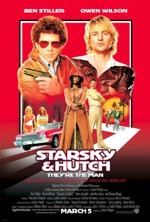
Starring: Ben Stiller
March 2004
“Groovy, But Not Great”
Acting:
This movie is Ben Stiller and Owen Wilson. Without the chemistry between these two comedic actors—who have collaborated on seven films now—Starsky and Hutch would be a fro-sized disappointment. Vince Vaughn (Psycho) does a serviceable job as the movie’s cookie-cutter seventies villain (who comes complete with a Fu Manchu mustache), and his pet, played by Juliette Lewis, is the stereotypical airhead (pothead?), flower chick whose no brains and no initiative character serves no other purpose than to massage her honey’s shoulders and deliver inane dialogue. The most colorful character in the movie is the glitzy Huggy Bear, played by Snoop Dogg, a shady figure who walks a dangerous tightrope between both sides of the law. His scenes as the golf caddie are absolutely hilarious. Carmen Electra adds a pretty face to the movie, but little more.
Director:
Starsky and Hutch—the movie—is nothing more than a glorified seventies television show, which seems to be the intent of director Todd Phillips (Road Trip). Besides hair and clothing styles and accompanying faves from groups like The Carpenters, Phillips utilizes old-style camera moves to capture the flavor of the original show. And, if you’re going to have a movie based on a seventies TV show, you’d better have the requisite fistfight and prolonged car chase, which, of course, this modern version also features.
Screenplay/Story:
Like the rest of the movie, the plot is typical of the seventies TV show, but the story elements, such as drugs, free love and violence have been updated, modernized and pushed to the extreme. In comparison to this new flick, the original TV show seems sanitary: what was a cutting-edge cop drama in the seventies would now be considered a family show. Social commentary aside, the movie never goes anywhere; there are no curveballs, no cliffhangers and no creative flourishes in most respects. Complete with the iconic, cherry-red Gran Torino with white lightning bolt along the side and a sea of Afros and bell-bottoms, the story is nothing more than nostalgic drivel.
Final Analysis:
Matinee all the way, dude!
Rating: 2
Intolerable Cruelty (PG-13)

Starring: George Clooney
October 2003
“Undeniable Stupidity”
Intolerable Cruelty truly is the best phrase to describe this film, because, after fifteen minutes of watching this mind-numbing display of unbridled avarice and over-the-top acting, you’re ready to sign your life away just to get out of the theater. George Clooney plays shifty divorce lawyer, Miles Massey, who never looses a case until he looses his heart to his kindred spirit, Marilyn Rexroth, an alluring divorcee portrayed by Catherine Zeta-Jones.
As the movie progresses, it gets zanier by the minute as Rexroth leaves behind a trail of affluent, but easy-to-dupe husbands who make her filthy rich with prenups. As kismet would have it, Massey marries Rexroth, and, in a display of undying love, he rips up the prenup. on their honeymoon night. Rexroth betrays Massey, of course, and leaves him lovelorn and homicidal; but in the end, she comes to her senses and decides to return to Massey. And they live happily ever after…or something like that.
Intolerable Cruelty leaves you searching for a meaning behind its quirky and murky plot. It flirts with a message (love’s supremacy over the lust for money), but the story is so muddied by ambition, deception and shady morality that anything virtuous is undetectable when looking back on the film as a whole.
There’s a ton of foul language in the movie and the dialogue, when clean, is excessively stilted, employing quotes from Shakespeare and other literary giants in order to convey basic concepts. This renders the movie verbose, trite and unreachable. The movie tries to be funny, but it fails miserably—like the “sitting before the judge before” scene with Edward Herman as the cornball, Mr. Rexroth.
The major problem with the film is its lack of a protagonist—Massey’s exploits are hardly laudable and Marilyn Rexroth is a manipulative minx. And we’re supposed to cheer when they finally get together? What were Clooney and Zeta-Jones thinking when they accepted this script? Intolerable Cruelty is a terrible waste of star power and an egregious waste of time.
Rating: 1 1/2
Out of Time (PG-13)
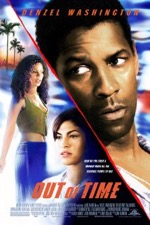
Starring: Denzel Washington
October 2003
“Thrill a Minute With a Touch of Humor”
Denzel doesn’t disappoint. Not much of a revelation, I know, but you would think that somewhere along the way, the Academy award-winning actor would trip up and select a project that would miss its target. In the early stages of the film, I thought this might be just such a time; the movie was very slow out of the starting blocks and featured Denzel, playing the chief of police in a small, shoreline town in Florida, in the throes of a divorce while messing around with another man’s wife—very uncharacteristic of the actor who’s brought us so many heroic roles in the past (Crimson Tide, The Pelican Brief, Remember the Titans and Antoine Fisher just to name a few).
Denzel’s Matt Whitlock makes one bad choice after another in the film’s prologue; he plans to steal away with his steamy paramour—who claims to be the victim of both an abusive husband and a fatal form of cancer—by using evidence money from a recent drug bust that had elevated his status to local hero. When Whitlock’s mistress and her husband are killed in an arson fire—and he’s spotted at the scene of the crime, events spiral downward at an alarming pace.
Putting out one brushfire after the next, Whitlock attempts to discover who framed him, while keeping his own police department and the feds. off balance just long enough for him to find the evidence that will exonerate him. After a series of nail-biting episodes in which Whitlock’s indicting affair is nearly revealed, and several genuine, on-the-edge-of-your-seat action sequences, Whitlock discovers the mastermind behind the elaborate trap and realizes that he may have committed one mistake too many.
As mentioned, Denzel is pitch-perfect as the protagonist, but he is surrounded by some wonderful talent, not the least of which is Dean Cain (Lois & Clark) as the rival husband, Sanaa Lathan as Whitlock’s mistress, Eva Mendes (2 Fast 2 Furious) as his estranged wife and his delightfully quirky side-kick, played by John Billingsley (Star Trek: Enterprise), who delivered the most memorable line in the movie, “A beer in hand is worth two in the fridge.”
It probably won’t go down as movie of the year in any category, but Out of Time is a great popcorn flick that entertains and raises the blood pressure all at the same time.
Rating: 3
S.W.A.T. (PG-13)
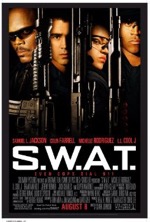
Starring: Samuel L. Jackson
August 2003
“By the Book Update of 70’s Police Drama”
S.W.A.T. is an acronym that stands for Special Weapons and Tactics. S.W.A.T. is also the name of a short-lived television series that ran during the 1975-1976 season and starred Steve Forrest and Robert Urich. The new S.W.A.T. movie has barrowed many of the names and archetypes from the original show, but has wisely transported the setting forward several decades and given the story an appropriately edgier tone.
In some respects, S.W.A.T. is little more than a glorified TV show with big-name actors, and this should come as no surprise since the movie’s director, Clark Johnson, is best known for his work on small screen hits like Homicide: Life on the Street and The Shield. Even though the movie closely resembles a standard police procedural, it’s still considerably better than it would have been had the producers committed the cinematic crime of adopting the style and milieu of the TV series: 70’s crime dramas were notorious for depicting police officers merely as caricatures of real cops, as virtual superheroes who were impervious to error, corruption or bullets.
Here, thankfully, the characters are a little more three-dimensional, if a little doughy in the middle. Samuel L. Jackson portrays hard-nosed Sgt. Dan “Hondo” Harrelson and Colin Ferrell plays debased officer, Jim Street, a man who desperately strives to earn Harrelson’s acceptance and thereby find redemption for a past mistake that has tarnished his record and reputation. In the Sydney Bristow era, it’s become a prerequisite for an action movie to feature at least one gorgeous, butt-kicking chica, and in S.W.A.T. we have Michelle Rodriguez (The Fast and the Furious), who embodies the tough-as-nails officer, Chris Sanchez. Rounding out the cast is LL Cool J as Deacon “Deke” Kay and Olivier Martinez as French baddie, Alex Montel, a loathsome tycoon who offers a $100 million reward to anyone who breaks him out of prison.
Most of the movie’s action scenes are similar those you’d see on primetime TV with one major exception…the heart-stopping sequence where Montel’s plane crash-lands on a four lane bridge and bullets start flying like snowflakes in a blizzard. Though I had hoped to see more scenes of this caliber throughout the movie, this pulse pounding sequence is, by itself, worth the price of admission. All things considered, S.W.A.T. is an admirable attempt at graduating a TV series to the big screen and features gritty realism, believable characters and a sobering reminder of how law enforcement officers all-too-frequently pay the price for our enduring security and freedom.
Rating: 2 1/2
Hollywood Homicide (PG-13)
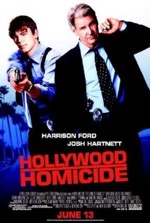
Starring: Harrison Ford
June 2003
“Glorified Cop Show Misses the Target”
Hollywood Homicide feels like a big-screen version of the new Dragnet TV series. Both are based in L.A., both feature cops working the homicide beat and both have a seasoned veteran and a young-buck sidekick. All of these similarities to Dragnet and other cop shows hamstring the picture, and any new and fresh ideas the writers hope to achieve seem trite by comparison.
The story begins with a murder at a dance club and the plot slowly unravels, linking the first murder to another double murder. As they investigate the case, Detective Joe Gavilan (Harrison Ford), who sells real estate on the side, tries to foist a lemon on anyone who will buy it, while his partner, K. C. Calden (Josh Hartnett), teaches a yoga class and schmoozes with every woman in sight. Joe engages in some unorthodox methods of investigation (one of his informants is a cross-dresser) and K.C. begins to consider a career in acting. The murders lead back to a local record producer, who evades the two detectives until he meets an untimely demise. An accomplice to the murders proves to be the man who killed K.C.’s father, and rather than taking revenge, K.C. records the man’s confession on a hidden cassette recorder. In the end, Joe sells the house and K.C. makes his acting debut. And they all live happily ever after—if that’s possible to do as a cop in L.A.
Hollywood Homicide takes an eternity to get going, and when it finally does, it doesn’t deliver all that big of a punch. Even by the second act, it’s pretty obvious who the killer is, and as a villain, the record producer is severely underdeveloped, and doesn’t really evoke the feelings of loathing or fear that a good antagonist should convey.
The last quarter of the movie is one big car chase and is embarrassingly reminiscent of an 80’s cop show. At first, it’s nice to finally see some action, but as the chase sequence drags on and on, the urge to look for stray Skittles on the floor becomes a viable alternative to the mind-numbing action on the screen.
The only novel idea in the movie is a cop selling real estate as a part-time job, an idea that gets worn out from overuse. And as for Ford, why did he select this role? His last few script choices have been average at best (Air Force One was his last big screen triumph). Here, he tries to be an action star, but doesn’t quite pull it off. He tries to be funny, but only lands about half of his jokes. And his cell phone in the movie is just downright annoying (beating the first few bars of the Temptation’s “My Girl” into the ground). Unlike some naysayers, I believe there’s still gas in the old Ford, but he needs to choose better films to act in (like the forthcoming Indiana Jones IV).
Hollywood Homicide is like a falling star in Tinseltown; it shows for two hours, but is gone in sixty seconds.
Rating: 2
The Italian Job (PG-13)
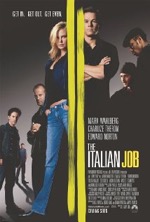
Starring: Mark Wahlberg
May 2003
“An Average Job, With Very Few Surprises”
“There is no honor among thieves.” The age-old saying proves very true in The Italian Job, an action-packed heist movie where routing for the bad guys is en vogue (because the other bad guys are much worse).
The movie begins with the thieves, led by Charlie (Mark Wahlberg) and John (Donald Sutherland), stealing a safe filled with 35 million in gold bars. The score goes down without a hitch until one of the members of the team, Steve (Edward Norton), double-crosses them, shoots John, takes all of the booty and kills the rest of the team (or so he thinks).
A year later, Charlie reassembles the original team (sans the deceased John) in L.A., with John’s daughter (Charlize Theron) thrown in for good measure, and they formulate a plan to get their gold back. Steve has purchased a plush mansion and has filled it with the dream items from all of the original team members (trophies that signify his conquest over them). Steve is smart and devious, but Charlie, with the help of his colorful and technical team, proves to be more than a match for the nefarious thief; and after a series of plot twists and action sequences, Charlie and his crew get their gold back.
The word that best describes The Italian Job is “average.” It’s not a bad movie, but it’s nothing revolutionary either; and Mark Wahlberg’s calculated under-acting only adds to the film’s mediocrity. The movie isn’t devoid of fun, however; the different members of Charlie’s team are quite entertaining, especially Lyle (Seth Green), a young man who claims to have invented Napster (he says his college roommate stole the program while he was asleep on his keyboard). Lyle fancies himself as “The Napster,” and is the technical genius of the group, deftly navigating his way through a self-made computer program that can hack into L.A.’s transportation system and re-route traffic anywhere he wants.
The team is assembled in an amusing, almost Ocean’s 11-like manner, but the moment is short-lived and most of the characters go unnoticed for the rest of the film. Edward Norton plays the perfect weasel-eyed villain and makes you want to reach through the screen and deck him in the face (like everyone else does in the film).
It’s not a complete loss, but in the final analysis, The Italian Job is a pretty average way to spend two hours.
Rating: 2 1/2
Daredevil (PG-13)

Starring: Ben Affleck
February 2003
The “devil” part is dead on—this character is no hero, seeking his own brand of justice and crossing the line (homicide) that other “true” heroes in the mold of Batman would never entertain, much less tolerate. Character development is as scant as Garner’s outfit and the fight scenes lacked emotional impact.
Rating: 1 1/2
The Recruit (PG-13)
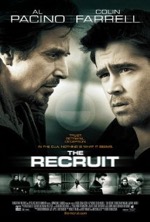
Starring: Al Pacino
January 2003
The Recruit is a solid spy movie that utilizes action sequences and plot twists to the hilt, while leaving the characters a bit underdeveloped. Pacino and Farrell are believable, if not amazing, in their roles. The only downside to the climax is that it leaves you scratching your head on the way out of the theater.
Rating: 2 1/2
Catch Me if You Can (PG-13)

Starring: Leonardo DiCaprio
December 2002
The opening sequence is absolutely brilliant—a throwback to a sixties spy flick. Catch Me if You Can is highly entertaining and Hanks and DiCaprio are spot-on. Catch Me if You Can is so unbelievable at times, that occasionally you have to stop and remind yourself that this actually happened.
Rating: 3
Die Another Day (PG-13)

Starring: Pierce Brosnan
November 2002
As Bond films go, this is probably the cream of the crop. And yet…it’s overstuffed with unbelievable action sequences, a smattering of double entendres and the requisite one-liners so stale they leave you reaching for a Rolaid.
Rating: 2 1/2
Ocean’s Eleven (PG-13)
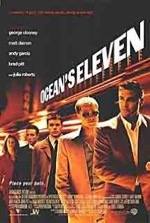
Starring: George Clooney
December 2001
Once Ocean's Eleven gets going, it’s an amusing, star-studded romp that depicts a daring heist in a major Vegas casino. The plot never tips its hand fully until the end, and the final series of twists is quite good.
Rating: 3